Instagram for farmers

Sri Lanka’s ag disaster




Due to smarter, targeted investment by the Australian Rail Track Corporation, Inland Rail is already paying dividends to regional communities well in advance of the completion of the entire project.
Split into 13 sections, the 1700km Melbourne to Brisbane Inland Rail, will transform the way we move goods between Melbourne and Brisbane, Perth and Brisbane and Adelaide and Brisbane.
The benefits of investing in national infrastructure that meets Australia’s growing freight task, will be seen and felt by everyday Australians – firstly through the 21,000 jobs it will create during the peak of construction and then through shifting modal share from road to rail.
Inland Rail will transform rail’s northsouth offering and trigger significant modal share shift in the intermodal and agricultural markets including supporting four of Australia’s richest farming regions, providing supply chain benefits and cost savings for producers.

While Inland Rail is a multi-year project, the build schedule allows for individual components to be released into the
national network when complete, providing incremental benefit as each section is completed. This means regional producers will have earlier access to the national capability of Inland Rail.

As the first fully completed stage of the project – the Parkes to Narromine section – has already shone a light on what is possible.
During construction more than 760 locals worked on the project and almost $110 million was spent with local businesses –and it was widely acknowledged that the
spending counteracted a large downturn that would have occurred due to the prevailing drought conditions in the area.
Parkes Shire Mayor Ken Keith revealed that the Railway Hotel served in the vicinity of 14,000 meals in three months.
“The year before last we were second only to Byron Bay in the appreciation in value of houses in our community, and last year it rose by 26 per cent, so it’s still growing year on year, and a lot of people are taking interest in positioning themselves in Parkes for the future,” he observed recently.
And why not? Following the completion of Inland Rail, the Parkes National Logistics Hub is emerging as one of Australia’s largest intermodal sites.
The reason is the 5.3km stretch of new rail track near Parkes, known as the North West Connection, which was completed with trains now using the line.
The North West connection provides a link between the north-south Inland Rail and the east-west Transcontinental Railway and has positioned Parkes as the epicentre of Australia’s freight and logistics network.


Rail freight operators can now consolidate freight at their terminals in the Parkes National Logistics Hub, before hauling them double-stacked across the Nullarbor to Perth or singlestacked to the ports of Botany, Brisbane or Melbourne.
Parkes is set to be a launch pad for freight volumes to all corners of the continent and the North West connection has already delivered immediate benefits with the east–west transcontinental line to Perth.
As the construction of Inland Rail continues, we will see even more employment opportunities for local businesses in regional Australia, bringing signifcant growth.
The second section of Inland Rail which is currently under construction –Narrabri to North Star – will allow freight customers to transport heavier freight volumes at higher speeds through its access to the Hunter Valley Rail Network.
The Inland Rail system will be built with 60kg of steel per metre of track with concrete sleepers at 25 TAL, allowing an average speed of 80km/hr and a top speed of 110km/hr.
This will make a large difference to productivity as it isn’t efficient to have a grain train that can only be partially loaded because one section of the trip is on tracks with a low weight limit. Standardising the Inland Rail will mean the same locomotives and wagons can be used for the entire trip and bulk handlers can use the full capacity instead of having to calculate how much they can load on each wagon in a section with a lower limit.
This has immediate tangible benefits to farmers with lower transport costs.
A second aspect of joining the Inland Rail N2NS section to the Hunter Valley network will be added reliability.
Although, they are already connected, raising the tonnages across the two networks will make the Inland Rail and the existing coastal network more resilient to extreme weather events.
We have had lines shut this year by fire, floods and land slips. Inland Rail will provide greater connectivity throughout the network and in some cases provide multiple pathways to work past a blockage.
Planning is being accelerated for all other sections of Inland Rail. More than $2 billion has already been spent in rural communities and another $1 billion in contracts is being rolled out.
The next few years will be pivotal as we continue to realise the benefits of this once-in-a-generation project.

A new Glovebox Guide will assist people to be aware of how to protect against and watch out for emergency animal diseases; The NSW Farmers Committee chairs highlight election priorities; A new branch for NSW Farmers in the Tweed; Update on the floods; Many of our essential roads are in dire need of repair 6
A popular apple cider is set to help restore Batlow’s apple industry 38
HOW SRI LANKA CRIPPLED ITS FARMING INDUSTRY
With a ban on synthetic fertilisers 44
AERIAL AG IS ON THE RISE
The use of drones as an aide to farming has increased exponentially 66
MOHAIR – A GREAT YARN
Two schools are rebooting the importance of agriculture through paddock-to-plate education initiatives��������������������������������� 22
Rising food prices and food security concerns in Australia should inspire a refresh of the decade-old National Food Plan
28
THREE TEA TREE TALES
Three tea tree oil farmers share the wonders of their produce 48 BUSINESS
THE CREAM ON TOP Strawberries and cream are just one part of a successful recipe for creating a viable small farm business 52
Rapid growth and higher profits in farming angora goats for mohair 74
NEW GENERATION: THE SUTTORS
The Suttor family from Bathurst show how Indigenous Australians and new settlers can find peace on the land 78
FARM DOGS
Meet Mr Bojangles from Wauchope 84
MARKETPLACE: SALEYARDS We’ve rounded up some top Aussie-made products for chic country style
MEET A MEMBER
Adele Smith from Young and her love for Merinos 86
The Cobar Sound Chapel is a unique installation in an outback water tank ������� 90

More and more farmers are seeing the benefits of being Insta-known 34
CREAM OF THE CROP
What some of the top schools across NSW are offering students 58
Welcome to another issue of The Farmer� Our thoughts go out to all of those still being affected by the disastrous floods, and we hope that in 2023 we see an improvement in weather conditions so that farmers can move ahead with their lives and businesses, and do what they do best
In this issue we have some interesting articles on innovation – including using Instagram and branding for farming, a strawberry farming family who have diversified to ensure that their small farm continues to thrive, and a cider producer who is expanding to employ hundreds of locals in his new venture

We also have an important feature about the need to overhaul the country’s decadeold National Food Plan, as with the rising cost of living, and in particular the prices of food, we need to ensure that people can continue to eat well, and afford to buy the food that are farmers are producing
This issue is also about ag education, and it is inextricably linked to food security As it’s the new generation of farmers and the youth of today who will be the ones making a difference when it comes to providing food and fibre for the rest of the country in the future� And as mentioned in our Special Report on education and scholarships, ag education is also key to ensuring that we achieve $30 billion in agricultural production by 2030
Agricultural education programs teach students how to be farmers, and trains tomorrow’s workforce� Teaching children when they are young and so open to new ideas and ways of doing things, where their food comes from and who is behind the production, is more important than ever
Especially because today, so many children spend so much more of their time online We need more young people on farms, learning about what you all do�
NSW Farmers Association and its many members continue to champion ways in which farmers can be innovative and grow their businesses, and they are also one of the strongest champions of ag education out there It’s one of the pillars of the organisation as it continues to work with farmers to ensure that voices are heard, and in turn, that the future remains bright for all� Enjoy this issue and drop us a line anytime – we love hearing from our readers and knowing your thoughts on all things great and small


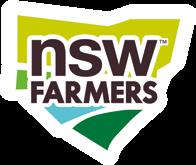 MICHELLE HESPE Editor
MICHELLE HESPE Editor






The Intermedia Group takes its corporate and social responsibilities seriously and is committed to reducing its impact on the environment. We continuously strive to improve our environmental performance and to initiate additional CSR based projects and activities.
As part of our company policy we ensure that the products and services used in the manufacture of this magazine are sourced from environmentally responsible suppliers.
This magazine has been printed on paper produced from sustainably sourced wood and pulp fibre and is accredited under PEFC chain of custody.
PEFC certified wood and paper products come from environmentally appropriate, socially beneficial and economically viable management of forests.
The wrapping used in the delivery process of this magazine is 100% recyclable.
DISCLAIMER: This publication is published by The Intermedia Group Pty Ltd (the “Publisher”). Materials in this publication have been created by a variety of different entities and, to the extent permitted by law, the Publisher accepts no liability for materials created by others. All materials should be considered protected by New Zealand and international intellectual property laws. Unless you are authorised by law or the copyright owner to do so, you may not copy any of the materials. The mention of a product or service, person or company in this publication does not indicate the Publisher’s endorsement. The views expressed in this publication do not necessarily represent the opinion of the Publisher, its agents, company officers or employees. Any use of the information contained in this publication is at the sole risk of the person using that information. The user should make independent enquiries as to the accuracy of the information before relying on that information. All express or implied terms, conditions, warranties, statements, assurances and representations in relation to the Publisher, its publications and its services are expressly excluded. To the extent permitted by law, the Publisher will not be liable for any damages including special, exemplary, punitive or consequential damages (including but not limited to economic loss or loss of profit or revenue or loss of opportunity) or indirect loss or damage of any kind arising in contract, tort or otherwise, even if advised of the possibility of such loss of profits or damages. While we use our best endeavours to ensure accuracy of the materials we create, to the extent permitted by law, the Publisher excludes all liability for loss resulting from any inaccuracies or false or misleading statements that may appear in this publication. Copyright © 2023 – The Intermedia Group Pty Ltd
The state’s peak farming body has welcomed a ‘common sense’ timeline for electronic sheep and goat tags in NSW.
The NSW Government has announced all sheep and farmed goats born after January 1, 2025 will require an electronic tag before leaving a property, and from January 1, 2027 all farmed sheep and goats will require an eID tag
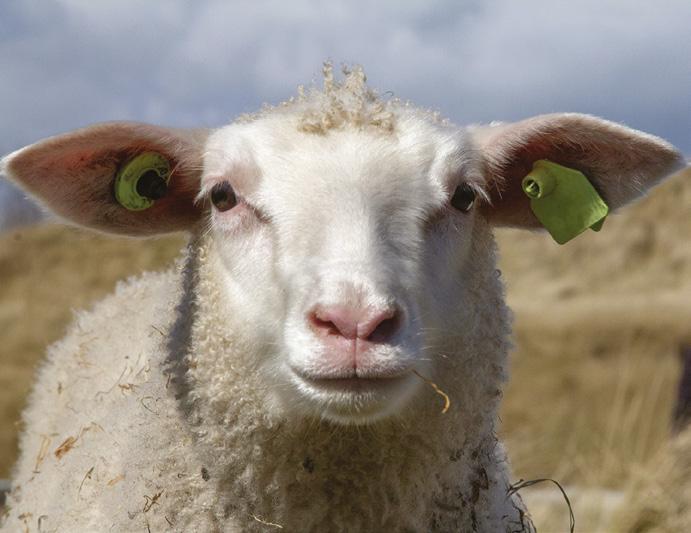
NSW Farmers President Xavier Martin said the implementation timeline developed in consultation with NSW Farmers is a commonsense approach:
“It means that if you’re producing sheepmeat at Armatree, farming goats at Broken Hill, or growing wool in Crookwell – you will not be rushed into preparing your property and animals to use the eID system.”
“We’ve heard from some farmers about issues around time frames and harvested rangeland goats, and from the outset we have said producers need enough time to implement eID properly.”
“Farmers shouldn’t have to put tags in ears until they can be scanned at the saleyard and the processor, and this
implementation plan will ensure the supply chain is ready to accept animals with eID devices.”

“It’s important that any reforms are manageable and able to be rolled out practically, and that’s the approach we’re seeing from the NSW Government.”
Agriculture Minister Dugald Saunders said he was committed to providing NSW producers with the smoothest possible transition, while maintaining a strong
focus on biosecurity� Work would continue across all sectors to determine what critical infrastructure was needed and how it would be funded�
Xavier said that while the timeline answered some important questions, it was important to ensure costs were managed – especially for tags – so that producers did not end up paying for this reform.
“There’s no point setting arbitrary timelines that can’t be met� The transition to electronic tags must be done simply and efficiently to avoid potential problems,” Xavier said.
“It looks like the Minister wants to set us up for success here in NSW, and we’ll continue to work through the NSW Sheep and Goat Traceability Reference Group to make sure we plan around potential obstacles.
“At the end of the day we want an affordable system that works for everyone.”
NSW Farmers members will soon receive a Glovebox Guide to to create greater awareness of how to protect against, watch out for and manage the risks associated with Emergency Animal Diseases (EADs) The need to be well informed is particularly important given the threat of foot and mouth disease
The Glovebox Guide: Biosecurity, Emergency Animal Diseases and preparing livestock for transport provides clear, digestible, contemporary information on the key issues all livestock owners, producers and those involved in the market chain need to be familiar with�
This includes biosecurity, EADs, and requirements for the safe transport of livestock The guide is being republished and will be available in the new year
In an easy to navigate, durable, flipbook format, the guide provides a quick reference for how to protect against biosecurity problems, what to look out for, who to contact if something does not look right, what to consider when preparing livestock for transport and, most importantly, which animals to load and which not to load
With plenty of helpful photos and concise information, this guide will help increase and refresh your knowledge and confidence to recognise the signs and behaviours that could indicate an animal may have an EAD�
It will also remind people of the number everyone in the sector both big and small scale should have in their phone or on the fridge – the Emergency Animal Disease Watch Hotline: 1800 675 888 Watch out for delivery in your mailbox soon
In 2023, look out for your copy of the Biosecurity, Emergency Animal Diseases and preparing livestock for transport Glovebox Guide.

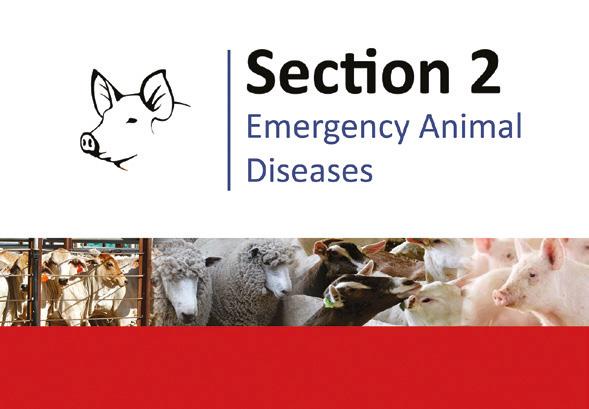

It will help everyone in the livestock sector to protect against, and prepare for, the potential of FMD and other emergency animal diseases.


With polling day less than three months away, NSW Farmers has launched its state election platform for farmers and regional and rural communities.
Words EMILY SIMPSONTitled Feeding the Future: A stronger outlook for farmers and the state, the NSW Farmers state election campaign looks at how industry and government can partner for a more food secure future.
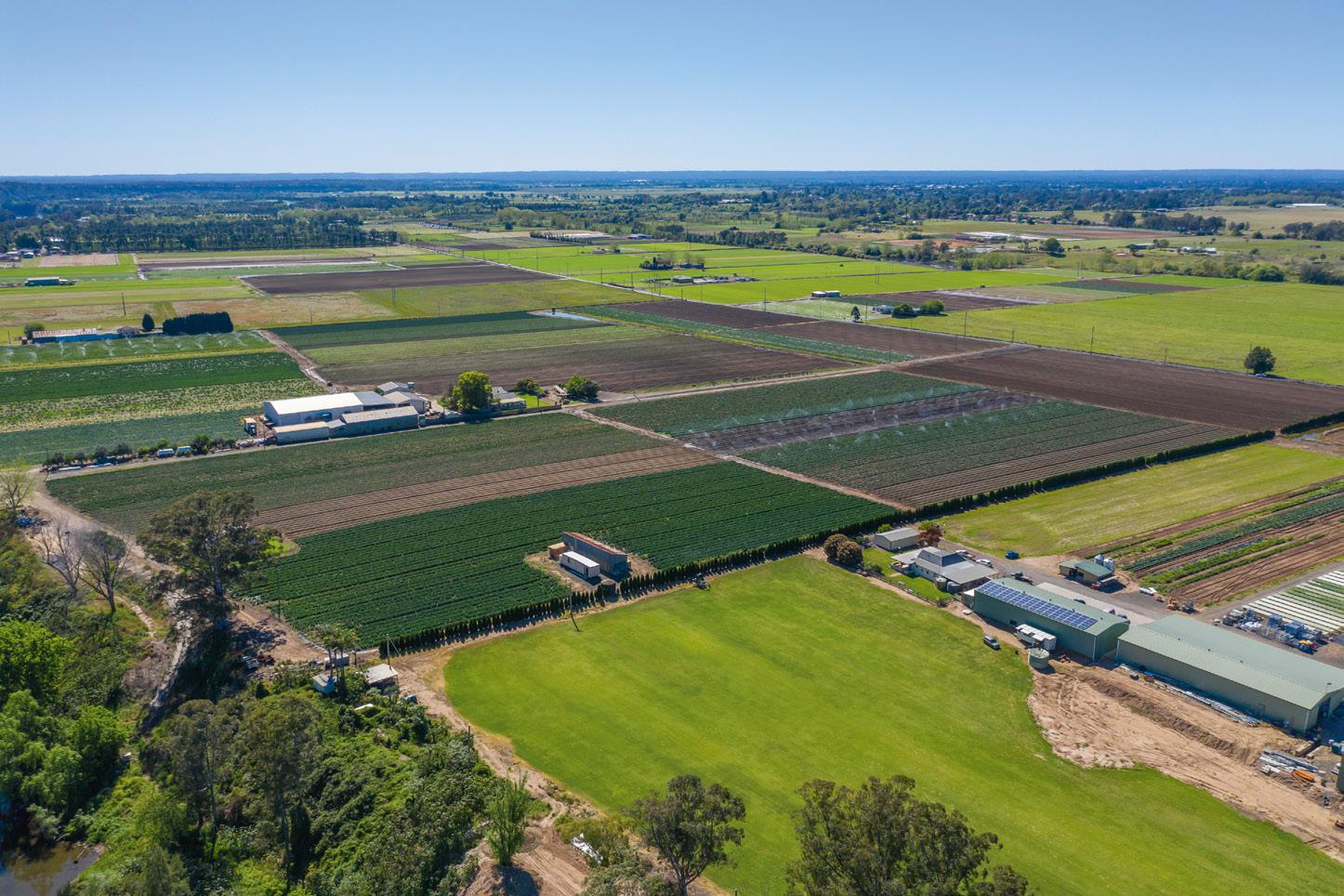
Food access and supply are becoming bigger issues, particularly with supply chain disruptions and the high cost of living� Even in a wealthy country such as Australia, food security is not guaranteed; the latest Foodbank Hunger Report reveals only 55 per cent of Australians consider themselves highly food secure while two million people experienced severe food insecurity in 2022 NSW Farmers has argued that agricultural productivity is about more than farmers and the communities they are part of – it is also about the innumerable consumers that rely on them for local food and fibre production� NSW Farmers has drawn on its membership and policy experts to identify road and rail infrastructure, biosecurity, farm productivity, workforce and land use pressures as the five key areas where work is needed to strengthen the long-term success of agricultural production in the state
Ongoing flooding and wet weather conditions have put many regional roads into a state of disrepair� NSW Farmers has called for more sustainable funding for councils to undertake repair work on local roads, deeming the current grants system inadequate
Chair of the Rural Affairs Committee, Deb Charlton, said councils needed funding certainty to undertake this critical work�
“The rolling flooding events have been disastrous for roads, but there is now an opportunity to fix the roads properly and make sure they can withstand future events,” Deb says.
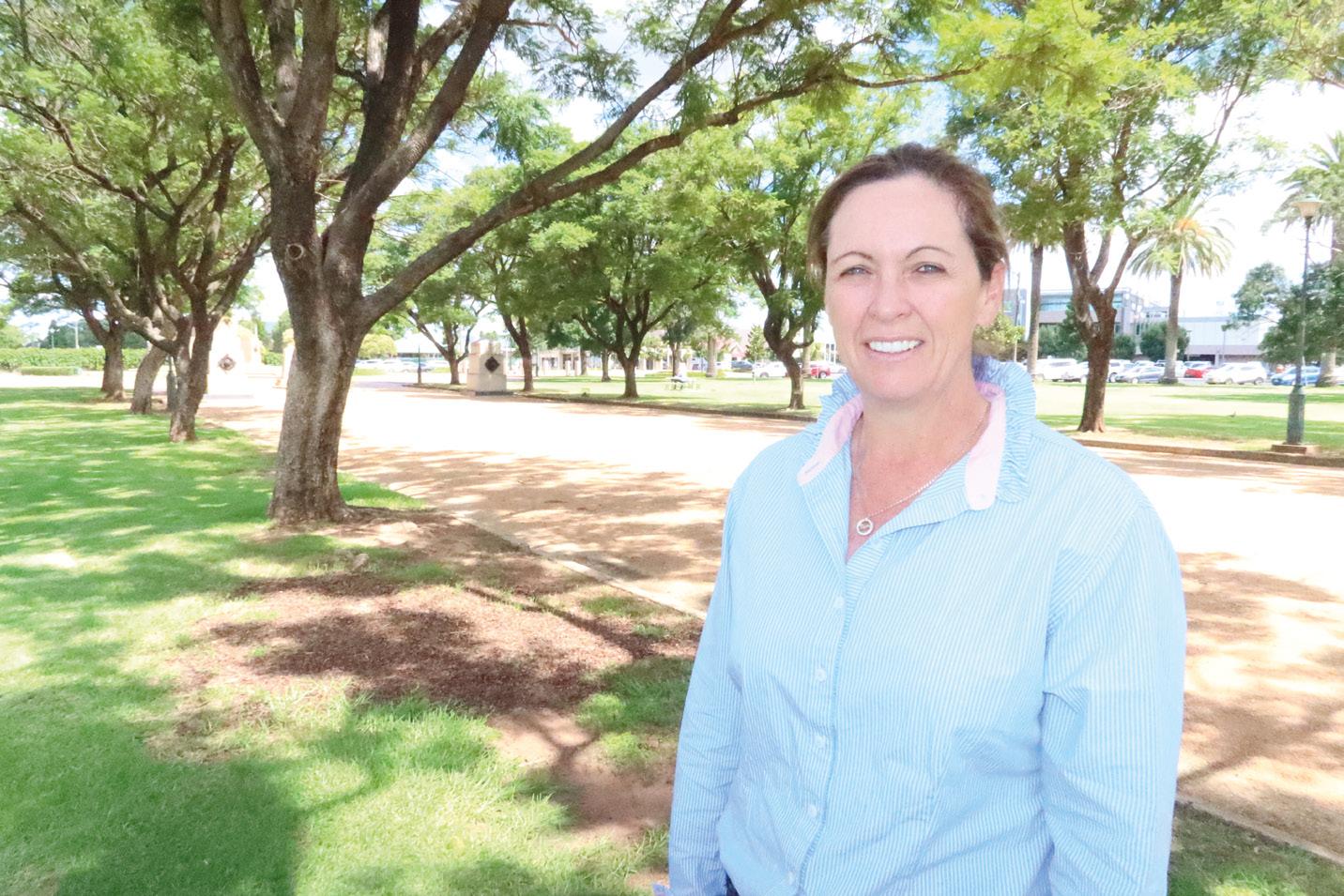
Deputy chair of Business, Economics and Trade
“It’s difficult for councils to do this work properly when they have to apply for the funding, and then they might be facing labour and material shortages as well,” Andrew says.

In October last year, NSW Farmers had a significant advocacy win when legislation to remove a fee liability to the NSW Government when it reached certain levels of container movements was passed and replaced with a more equitable pro-rata compensation payment The port is now in a position to grow competitively, including though a new container terminal Chair of the NSW Farmers Grains Committee and Howlong farmer, Justin Everitt, said this was a significant win for farmers, particularly grain growers in the north of the state
“We have had successive bumper crops, but we have been caught off-guard by not having the infrastructure in place to get all our produce off to export The state needs to be better prepared for boom cycles and expanding reliance on rail is a welcome thing,” Justin says.
Last year, NSW Farmers established the new Modernising Rail Infrastructure Taskforce to look at the rail opportunities across the state helm is Moree grain grower Matthew Madden, who said the government needed to look at the rail connections to the state’s three ports – Port of Newcastle, Port Kembla and Port Botany
“The world’s best performing ports have turnaround times more than three times faster than Australian ports, including Sydney, so it’s high time we look at the connecting infrastructure more closely,” Matthew says.
Last year was a big year for biosecurity, with localised outbreaks of varroa mite, QX disease and Japanese encephalitis But the threat of foot
























Caltex is coming back in a whole new way. You will soon see the new Caltex brand roll out across Australia, backed by the global power of Chevron. We’re still delivering the same quality fuel, world-class engine oils and reliable lubricants, so you can run a smoother, better business. Plus, we’re strengthening our distribution which means you can get our products where you need them, when you need them.





With a new Caltex as the guiding star and the confidence of Delo and Havoline, the future’s looking bright for Aussie businesses.






































































and mouth disease spreading to Australia from hotspots such as Bali was what captured headlines and triggered a strong government response�
In light of this threat, the NSW Government announced in July that the sheep and goat industries would be transitioning to a new traceability system, with electronic identification at the centre of
Sheepmeat Committee chair Jenny Bradley said the reform process needed to recognise the significant costs associated with the changes�
“Farmers cannot be expected to shoulder this
The state government has announced a sensible implementation timeline, but we do need to secure a practical support package that looks at cost-sharing between federal and state governments, and industry, throughout the entire
NSW Farmers has emphasised that biosecurity is not just about keeping risks at bay, but also about the pests and weeds in our own backyard�
Headlining this is a request for an independent Natural Resource Regulator to enforce planned management of public lands including National Parks and Crown lands
Conservation, Resource and Management committee chair Louise Burge said that despite there being requirements for management of public
“Farmers neighbouring public lands are being impacted by the threat of pests and weeds coming from over the fence, and it’s time public authorities are held to a higher account for their management
Ian McColl, chair of the NSW Farmers Biosecurity Committee, said NSW Farmers had been advocating

Agriculture is among the sectors heavily impacted by worker shortages in the wake of Covid-19� A slump in global migration – including a loss of two thirds of the backpackers in Australia before the pandemic – has hurt agricultural businesses, particularly those reliant on seasonal labour Apple grower and chair of the NSW Farmers Horticulture Committee, Guy Gaeta, said better coordination of harvest workers was needed�
“NSW needs to be seen as the destination of choice for backpackers and seasonal workers, and we need a strategy for attracting, retaining and coordinating these workers, such as an extension of Help Harvest,” Guy says.


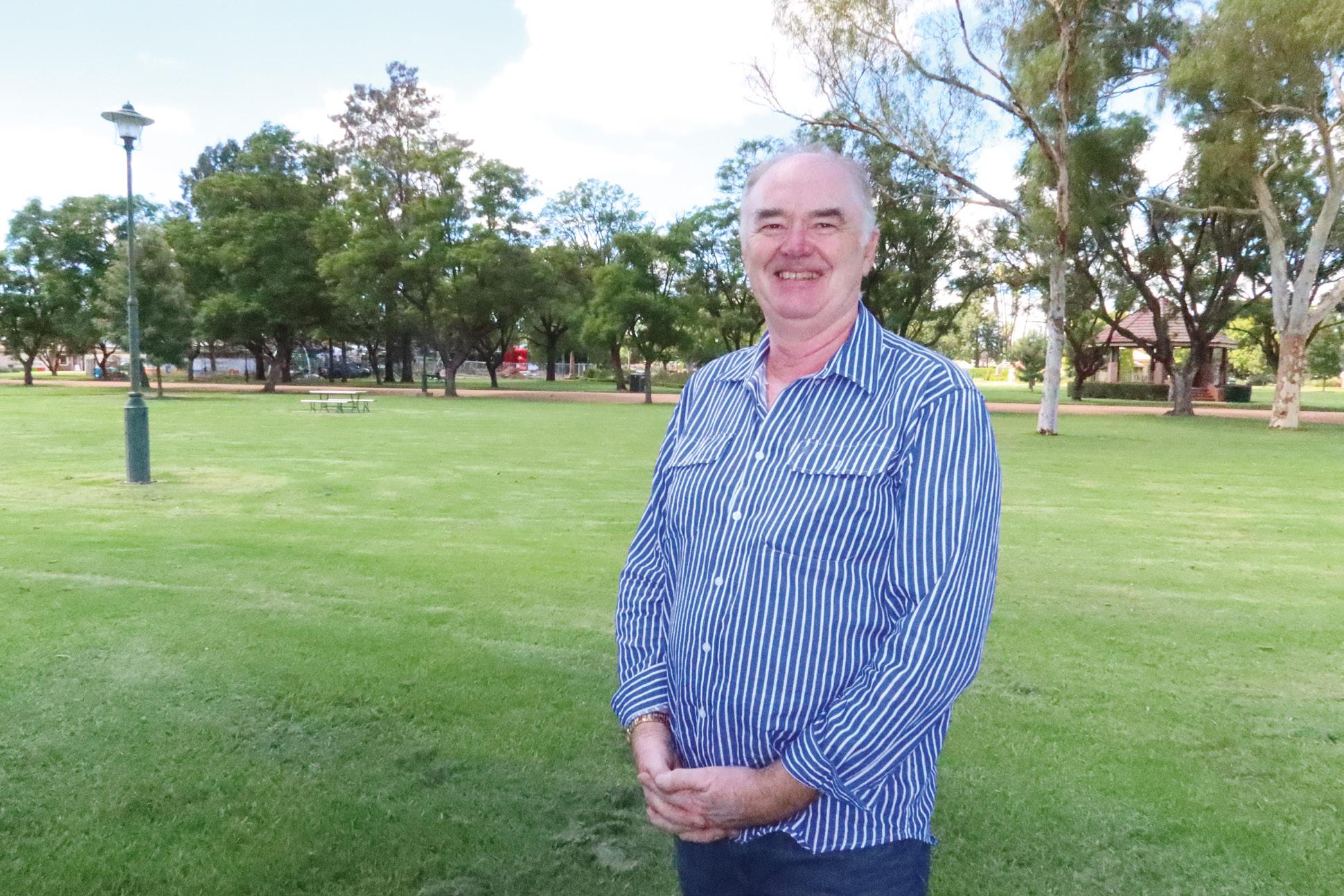
According to Justin Everitt, securing the workers is one thing, whereas housing them is another
The Grains Committee chair said key growing regions such as Moree were facing situations where job vacancies far outpaced rental vacancies�
“Rural livability is a huge aspect of finding a reliable agricultural workforce, and in the shortterm that’s about delivering more affordable housing in rural and regional areas,” Justin says.
Farm businesses are abnormally exposed to external factors such as climate variability, high energy and input costs, and labour availability – many of which have come to a head over the past year�
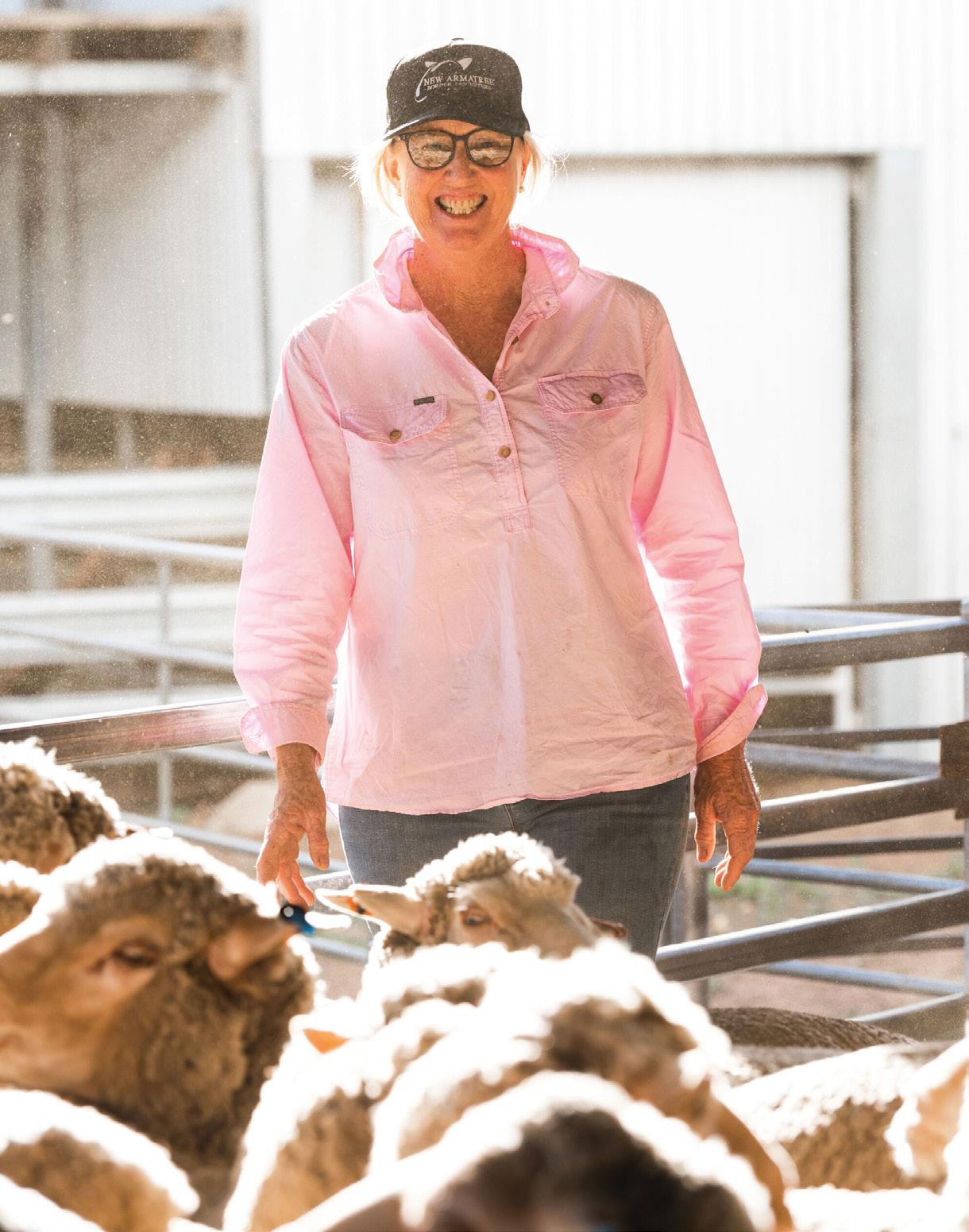
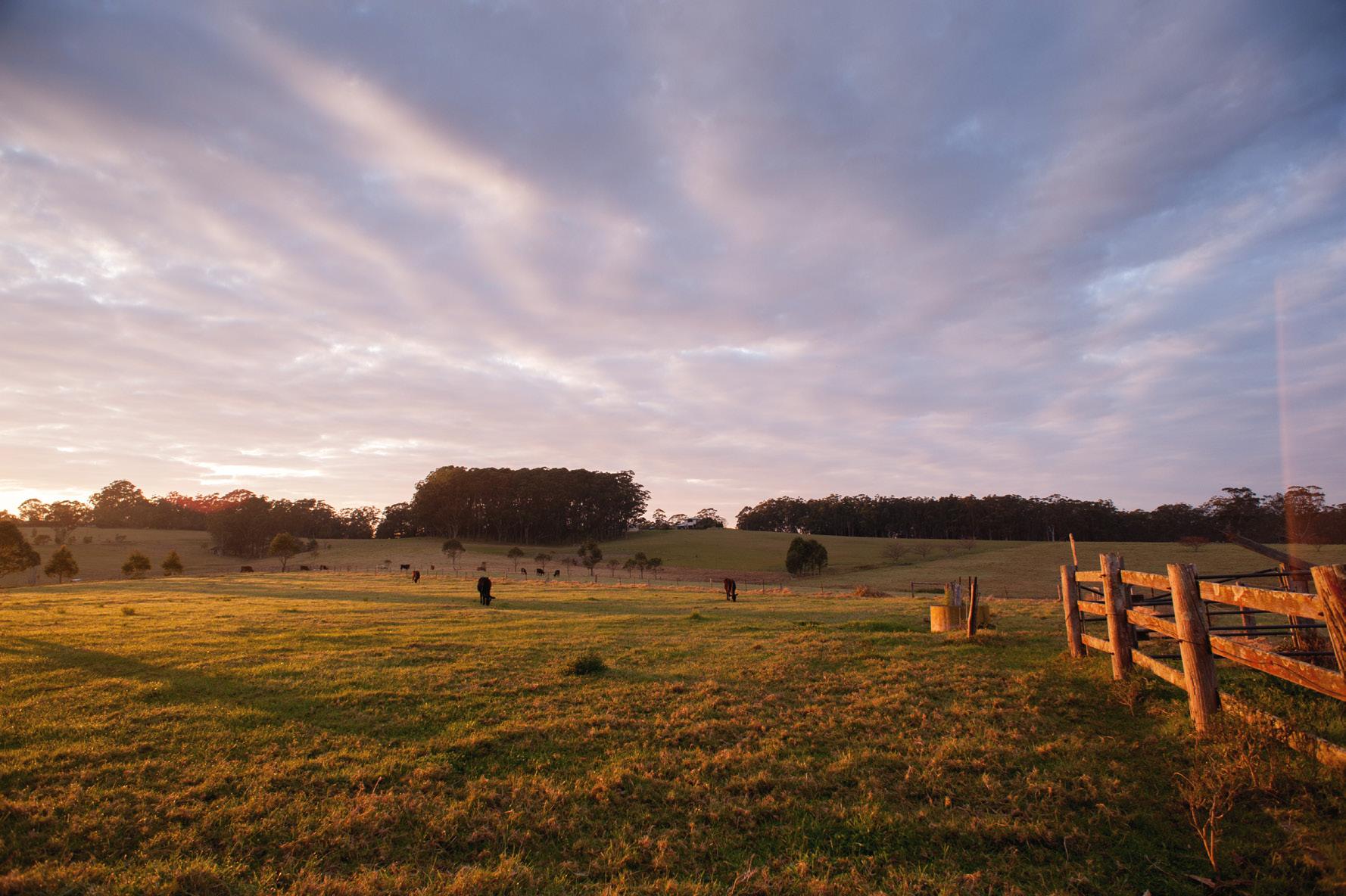
But according to BEAT Committee deputy chair Andrew Martel, these businesses will be increasingly impacted by shifting market trends such as consumer sentiment changes and a push to meet environmental, social and governance (ESG) credentials, especially by the finance sector�
“It’s critical that agriculture isn’t burdened with inefficient taxes or legislative requirements to meet climate and environmental targets,” Andrew says
“Instead, we need investment in research and development to find technological efficiencies and
practical solutions to climate change and emissions reduction.”
With its platform, NSW Farmers is calling for the establishment of a dedicated Climate and Emissions Reduction Innovation Fund to help find emissions reduction solutions on farms
Chair of the NSW Farmers Young Farmer Council, Martin Murray, said talking about the ongoing productivity of agriculture was redundant without addressing how the next generation of farmers would be fostered�
“Getting your foot on the farm property ladder is difficult and could be seen as a deterrent for industry entrants or those considering farming,” Martin says
“Strategies to help new young farmers enter agriculture, such as business capability initiatives, stamp duty rebates and low documentation loans through the Farm Innovation Fund, need to be explored.”
Water is key to farm productivity and the NSW Farmers Dairy Committee is calling for further changes to
coastal harvestable rights to maximise agricultural opportunity and build resilience for drier times�
Head of the committee, Colin Thompson, said an increase from 30 per cent to 40 per cent across intensive and extensive industries was needed
“A big part of farming is preparing for what’s around the corner, and this increase could be a game-changer for farmers down the road,” Colin says.
A longstanding advocacy priority for NSW Farmers has been to secure a land use planning strategy that recognises the need to protect the future use of strategic agricultural land
NSW Farmers led the call for the state’s first Agriculture Commissioner prior to the 2019 state election� Now the group is calling for this role to be made statutory, and for the establishment of an Agriculture Commission, with an immediate priority to get the state’s land use planning system fit for purpose
The renewable energy transition
is also placing pressure on farming land� Five Renewable Energy Zones are planned or underway across the state, as well as the linear infrastructure needed to connect these zones to the grid
Chair of the NSW Farmers’ Renewable Energy Transition Working Group, Reg Kidd, said enough productive agricultural land had already been lost to extractive industries and urban sprawl�
“Some regional areas are also undergoing change with urban sprawl and an uptick in boutique farming and agritourism ventures What we need to remember is that agriculture remains the economic dynamo and social heartbeat of most rural and regional towns, and the state cannot afford to compromise the future use of productive agricultural land,” Reg says.
“An effective planning strategy balancing agricultural production with a growing list of other land uses will be the most important legacy any state government can leave for agriculture and our nation’s food security.” l
From the outback to the coast, Aussie farmers & rural contractors trust the power and performance of THOR's premium range of robust hydraulic post drivers to meet their demanding workloads in often tough conditions.

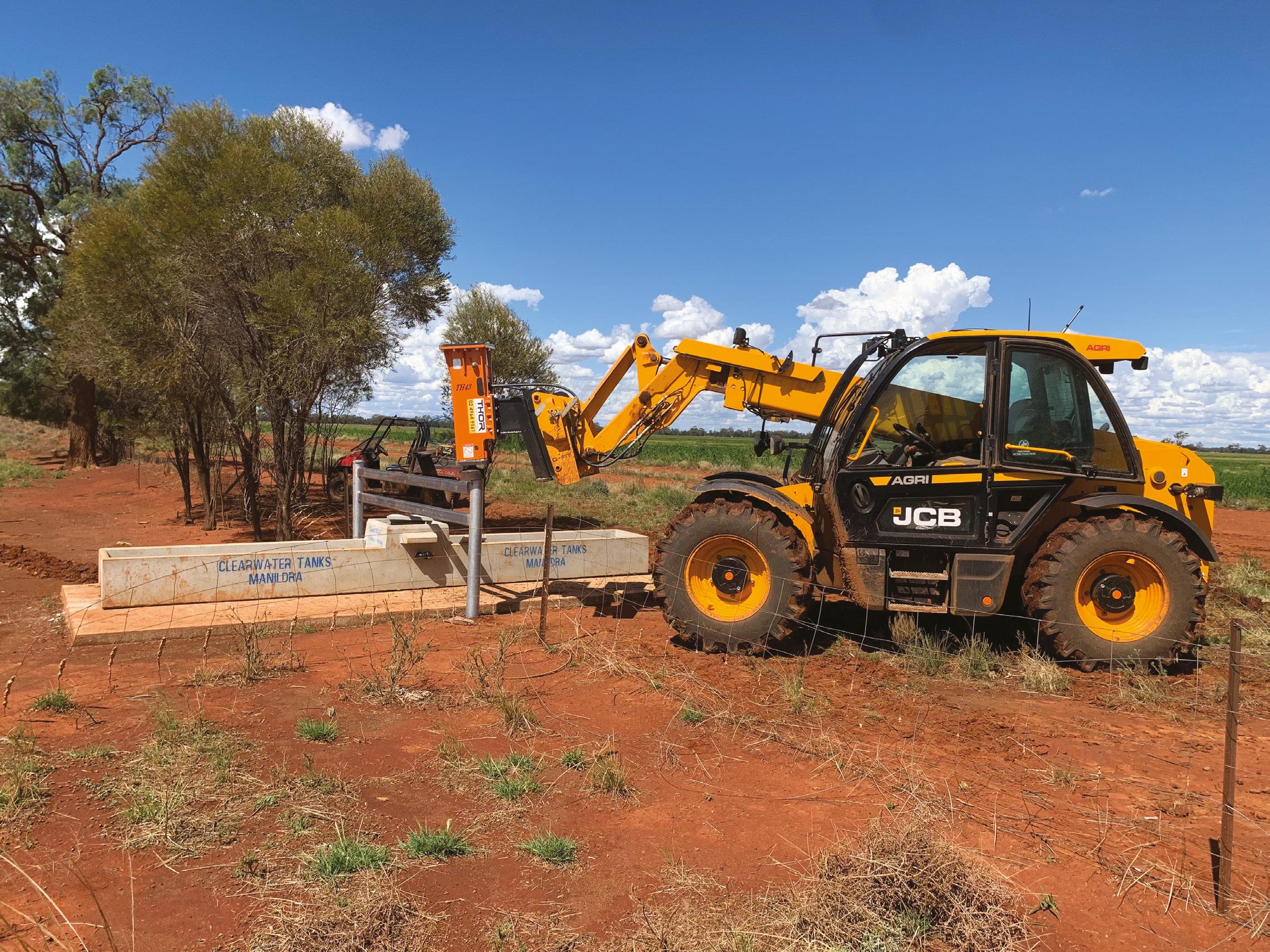
Premium Attachments Fair & Reasonable Price
Aussie Family Owned & Operated Shipping Australia-Wide
THOR has a comprehensive range of different model hydraulic post drivers to suit machines from 800 kgs – 35 tonnes including: • mini loaders • skid steers • excavators • tractors • loaders • telehandlers
Contact THOR today for an obligation free quote for a hydraulic post driver to suit your needs. Ph: 02 4964 9161 • info@thorrockbreakers.com.au www.thorrockbreakers.com.au
ROCK BREAKERS I POST DRIVERSThe opening of a new NSW Farmers branch in the Tweed region coincides with an increase in membership for Australia’s largest farm advocacy group.
Words MICHAEL BURTLocal planning issues, weed and pest management and improving cattle tick management will headline advocacy activities for the new NSW Farmers Far North Coast Branch
More than 30 local cattle, sugarcane and horticultural farmers attended the branch’s first meeting in Murwillumbah, heralding a new united voice for agriculture in the Tweed Valley and Byron Bay regions�
Newly elected chair, Craig Huf, said the creation of the new NSW Farmers branch provides the opportunity to improve farmer engagement with policy makers from all levels of government
“We identified our main areas of focus for the next 12 months, which are all really about raising the profile of agriculture and food production in the region,” he said.
Craig believes the Far North Coast region is littered with land planning challenges for farmers, including local environmental zones (e-zones) and a high density of lifestyle landowners�
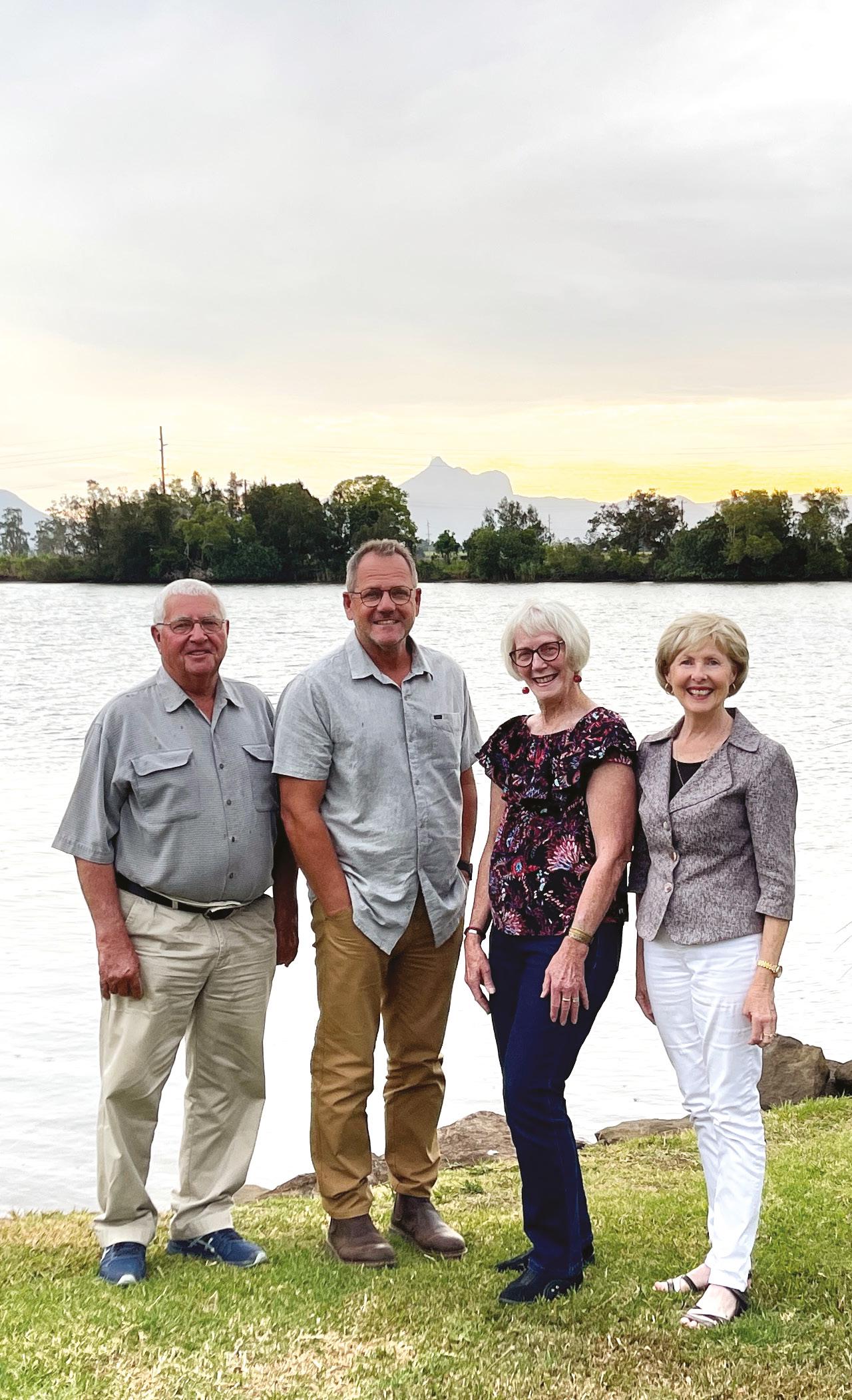
“Having a lot of lifestyle landowners is great for the region, but sometimes presents unique challenges� We want to look at how they interact and work alongside commercial farmers
“There is a great opportunity to improve consultation with policy makers when it comes to the impact of policy such as the imposition of e-zones as well as controlling pests and weeds.”
The Upper Burringbar cattle farmer said farmers should have a louder voice in the management of weeds like Camphor Laurel
“We are actually advocating for the continued support of commercialised harvesting of Camphor Laurel to have the best chance to get it eradicated�
“We also want to develop recommendations for the local government weed management policy that is relevant to our high rainfall region.”
Craig said having the backing of NSW Farmers will also enhance the plight of farmers in decision making for other government agencies and policy makers.
“There is a real need for genuine consultation with farmers in our region, and that includes what we see as failings with cattle tick control at the Queensland border


Top: Some members of the new NSW Farmers Far North Coast branch at their first meeting in Murwillumbah.
Above: The NSW Farmers Harden/ Boorowa branch executive, from left, Nikki Burton-Taylor, Elke Cleverdon, Christie de Mestre, Bronwyn Ryan and Wendy Bowman.
“Another example is working with the LLS on a Far North Coast weeds strategy and we want to be a part of that.”
NSW Farmers is celebrating six years of consecutive membership growth, driven in large part by women taking on leadership roles.
Bucking the downsizing trend among member-driven organisations, NSW Farmers branches are growing and an increasing number of leadership roles are being filled by female farmers.

NSW Farmers Regional Service Manager Catriona McAuliffe said one of her branches – at Harden – was entirely run by women
“They say if you want something done, get a country woman to do it, and our ladies are certainly getting things done,” Catriona said.
“It’s great to see more women step up and take a leadership role, and their voices are being heard.”
NSW Farmers Harden/ Boorowa Branch chair Bronwyn Ryan said more people were accepting of women working in agriculture, challenging the stereotype of “the old bloke in a ute”.
“My daughters grew up helping out around the farm, and now they’re both really passionate about agriculture and sharing that with the world,” Bronwyn said�
“More and more women are getting hands-on in the running of the family farm, and I think it’s a good thing because they’re not afraid to stand up for what they believe in
“I’m proud to have paved the way for my girls to take up their career in agriculture, and I think if you want to make a change you need to get involved.”
Over the past six years the NSW Farmers membership base has grown by almost 10 per cent despite – or perhaps because
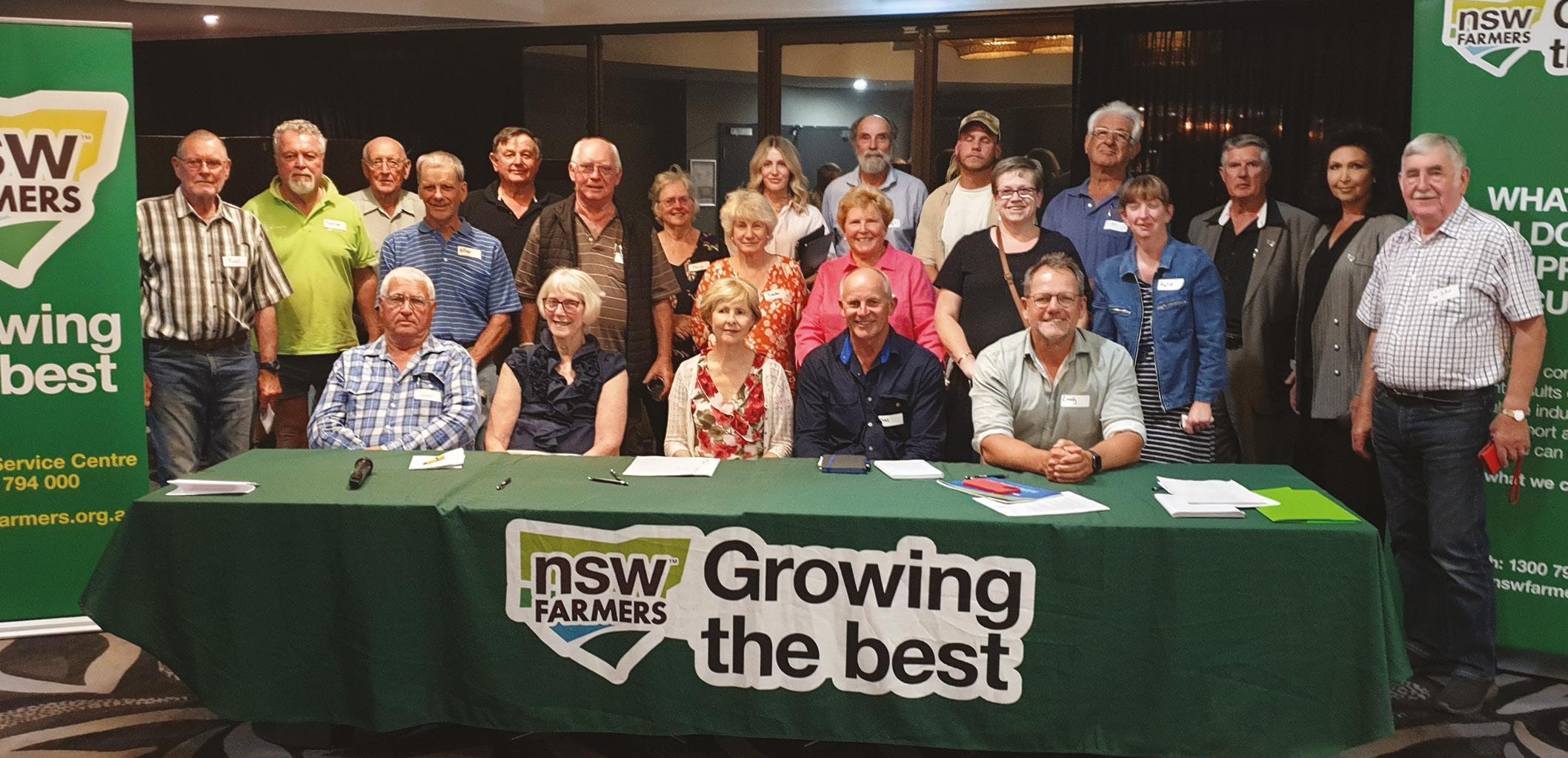
of – the challenges of drought, bushfires, COVID-19, mouse plagues and flooding
NSW Farmers Vice President Rebecca Reardon said one of the reasons women were increasingly getting involved was the focus not just on specific commodities, but the broader policy issues around rural communities such as health, education, telecommunications and business�
“Farmers recognise the need for a strong conduit between paddock and policy making, and our strong presence both in the regions and in front of decisionmakers really sets us apart,” Rebecca said “We are one of the only organisations of our kind with staff on the ground in the regions, and this has been driven by local grassroots engagement on important issues�
“I think a big part of our growth is that we pay attention to the big issues both now and into the future, as well as issues that affect our whole community This responsiveness I think is driving women to get more involved and have their voices heard.”
Find out how you can benefit as a member of NSW Farmers at nswfarmers.org.au/NSWFA/ JoinNow l
Making life easier and more productive involves thinking about the many farming tasks that involve lifting, lowering, pushing, pulling, carrying, holding or restraining things or animals.
Most farmers know that these tasks can lead to musculoskeletal disorders (MSDs) such as back, joint and bone injuries and degeneration, sprains and strains, nerve injuries, hernias and chronic pain.
Health and quality of life improves immensely when MSD hazards are effectively controlled on the farm.
SafeWork is now working with farm owners and workers throughout NSW to discuss ways you can control MSDs on your farm. Over morning tea, we will talk you through the best way to identify and fix MSD issues and share simple solutions from like-minded farmers.


Farmers like to say mud is better than dust, but the widespread and recurring flood events of 2022 have taken a toll on the mental wellbeing of many farming communities in NSW.
Words MICHAEL BURTLast year certainly earned a ‘back in 22’ status when it comes to recalling flood events For many rural communities, it was also the third soaking year in a row
More than 30 per cent of respondents to a NSW Farmers Flood Impacts survey experienced flooding for three years in a row, with more than three-quarters saying they had planted less than half of their usual winter crop this season
When asked, ‘Are you feeling OK,’ more than 20 per cent they had ‘had enough’
NSW Farmers President Xavier Martin said like the preceding drought, the widespread flooding that has occurred since 2020 has truly tested the stoic nature of farmers and rural communities
“Farmers are saying they’re a bit over it, frankly, and it’s not hard to see why,” Xavier said.
“We know these farms are homes, not just workplaces, and having to deal with the uncertainty, stress and anxiety of living through this ongoing cycle of natural disasters is challenging.
“When you consider farming has been a pretty expensive operation over the past year, and now so much of the food and fibre we have grown has been destroyed or damaged, it’s really tough from both a personal and a business standpoint�
“A lot of this flood damage cannot be insured against, and we’ll be feeling the impact well into next year in terms of missing the summer sowing window because the ground is still so wet.”
Xavier stressed the need for farmers to reach out to their family and friends� “With so many people reporting increased stress and mental health impacts, I’d urge everyone to keep in touch with neighbours
Wellbeing and health support is available, so don’t struggle through this on your own.”
MENTAL HEALTH SUPPORTED
EXPANDED IN CENTRAL WEST
Flood-affected residents in the Central West are being encouraged to access a range of expanded mental health support services to help them deal with the impact of devastating floods.
The NSW Government increased the number of mental health clinicians and workers deployed in the State’s Central West to provide support to communities�
“We understand it has been an incredibly stressful and upsetting time for people in our flood-affected towns and communities We are committed to providing whatever support we can to help people who are doing it tough,” NSW Premier Dominic Perrottet said�
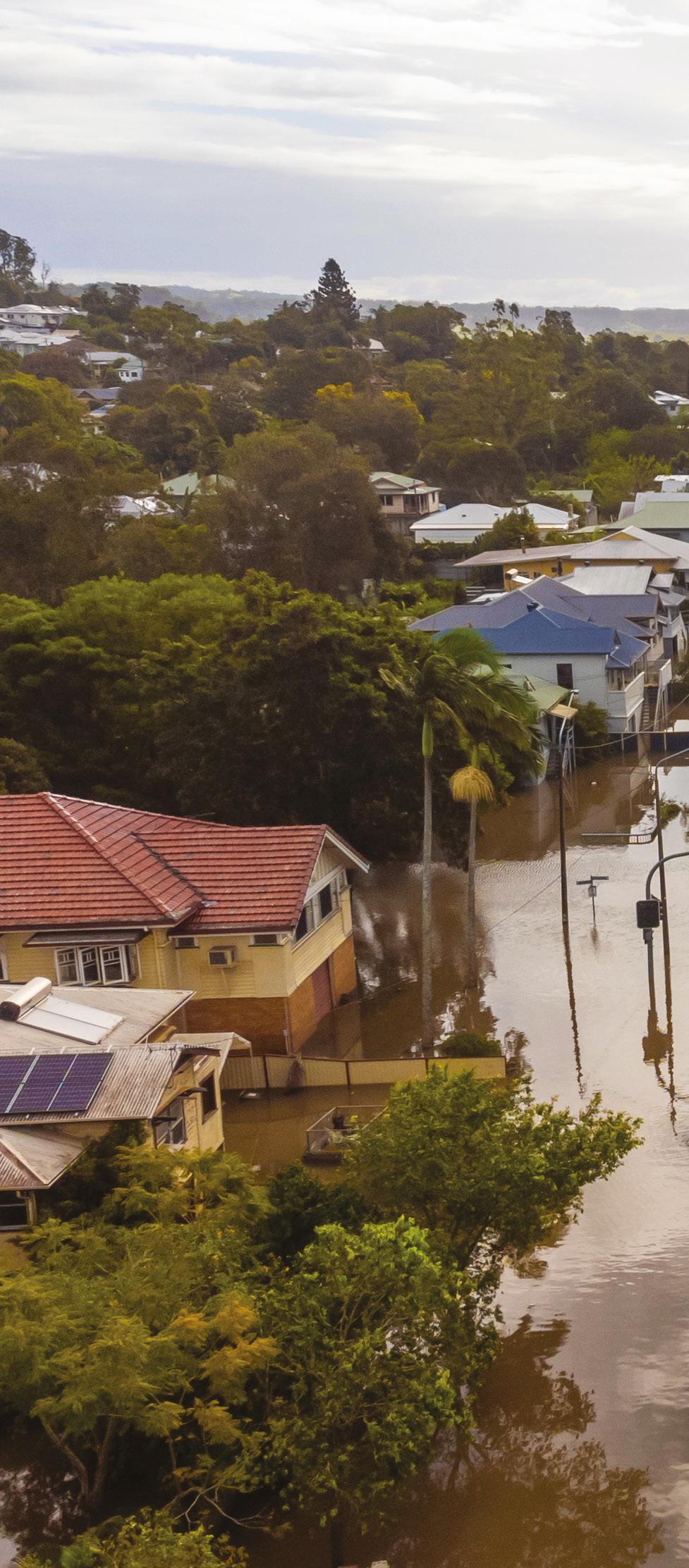
That included a funding boost for Lifeline Central West to increase its Rapid Response Program currently active on the ground, with six additional crisis counsellors, new vehicles and funding for fuel, and accommodation.
Mental health clinicians were also based at NSW Government Recovery Assistance Points, along with a range of other community-based mental health services, government
–XAVIER“We know these farms are homes, not just workplaces, and having to deal with the uncertainty, stress and anxiety of living through this ongoing cycle of natural disasters is challenging.”
MARTIN NSW Farmers President
When asked, ‘Are you feeling OK,’ more than 20 per cent of those surveyed said they had ‘had enough’.
(Above: Lismore during the recent floods)
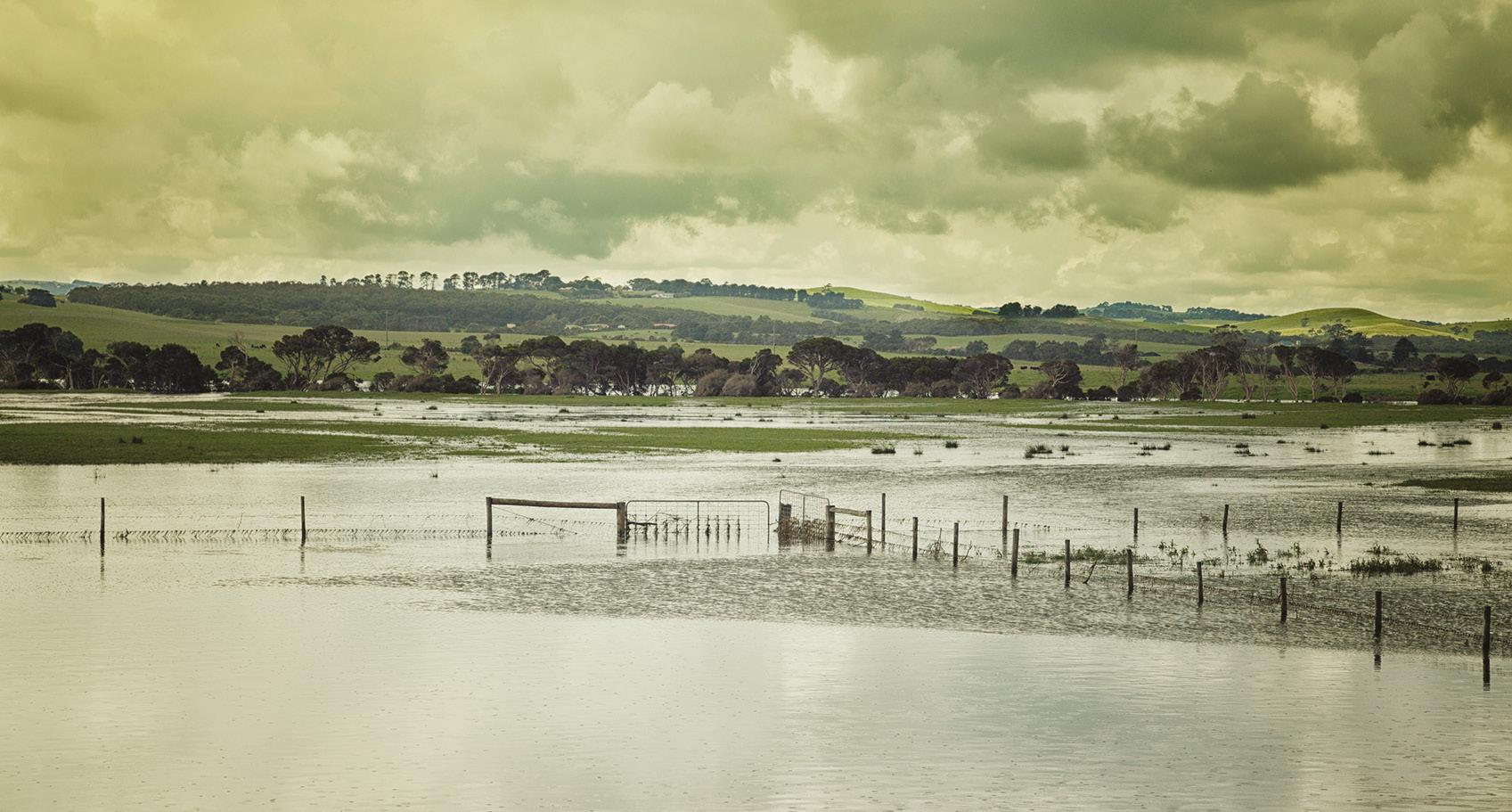

agencies and other organisations also providing support�
These mental health workers, including the District’s Rural Adversity Mental Health Program Coordinators, Response and Recovery Clinicians, and Aboriginal Mental Health teams, provided face-to-face care and help people access appropriate services for ongoing support.
Deputy Premier Paul Toole said the targeted mental health support is part of an ongoing, multi-agency effort to assist hard-hit communities
“I want to thank all of the dedicated staff from NSW Health, NSW Ambulance, St John’s Ambulance, Lifeline and the Red Cross, who have been working so hard to ensure mental health support is available wherever it’s needed,” Mr Toole said
“In areas like Eugowra, our mental health clinicians have undertaken house-by-house wellbeing visits, to identify people who may require additional support and provide that care as needed.”
Minister for Regional Health and Mental Health Bronnie Taylor said plans are underway to provide ongoing support to communities throughout the long clean up, rebuilding and recovery process
“Additional mental health support staff are already in place in Parkes, Orange, Molong and Eugowra, to ensure the communities receive the care they need through the different stages of recovery,” Mrs Taylor said.
A range of 24/7 mental health services are also available to the Western NSW community, including the WNSWLHD Mental Health Line on 1800 011 511� The Mental Health Line is staffed by local mental health clinicians who can provide support and assistance to find the most appropriate service for your needs People can also contact Lifeline on 13 11 14 or the Suicide Call Back Service on 1300 659 467
COORDINATING MENTAL HEALTH SUPPORT IN DENILIQUIN Industry associations, government agencies and health groups have joined forces to disseminate information on mental health support
services and events to farmers in the Deniliquin region�
The Deniliquin Regional Agriculture and Wellness Group is a voluntary group of businesses and agencies that service farm businesses and associated from a farm production, financial and personal wellbeing perspective�
The group was originally established by the Edward River Council during the last drought and has continued to meet on a regular basis since with the Ricegrowers Association providing in-kind support to coordinate the meetings Group chair and Deniliquin local Neil Bull said flooding and high rainfall events resulted in a disastrous end to 2022 for many local farmers�
“Things were looking pretty good last year for farmers and there was not much activity for the group to do, but that all changed in October and November with the impact of high rainfall and flooding
“The back end of the year was a tough time for local farmers� There were lots of crop losses and delays to planting this year’s rice crop and some were not planted at all.”
Neil, who is the Policy and Project Manager for Ricegrowers, said the group’s coordinated approach to assisting farmers to access mental health and financial support is based on successful outcomes during and after previous natural disasters�

“I was part of a group that was set up during the millennium drought and we found that incredibly valuable in having a coordinated approach to providing financial and mental health support services.”
He said the group’s model was used to drive the ongoing work of The Deniliquin Regional Agriculture and Wellness Group�
“There is some confusion out there about what support really is available, both in terms of financial and mental health A great outcome of the group’s work late last year was to pull together a clear list of support services for farmers.”
NSW Farmers is a member of the group, along with Murray LLS, RAHMP, Resilience NSW, Red Cross, Edward River Council and local community groups l
The back end of the year was a tough time for farmers. There were lots of crop losses and delays to planting.
Many people may be feeling anxious, worried or afraid within flood-affected communities. Looking after the mental health of ourselves, friends and family is an important part of staying well. Here are some tips from the Rural Adversity Mental Health Program (RAHMP).
• Spend time with family and friends.
• Try to get back to a routine but don’t push yourself and work too hard.
• Continue a healthy lifestyle (try to eat well, sleep and exercise).
• Take time out, but don’t isolate yourself.
• Write down your worries and concerns.
• Express your feelings in your own time and your own way.
• Accept help when it’s offered.
• Limit the amount of media coverage you see and hear.
• Know you won’t have all the answers.
• Try not to take big risks and make lifechanging decisions until you are ready.
• Understand you are not alone in your experience.
For more information on the Rural Advertisty Mental Health Program head to www.ramhp. com.au.

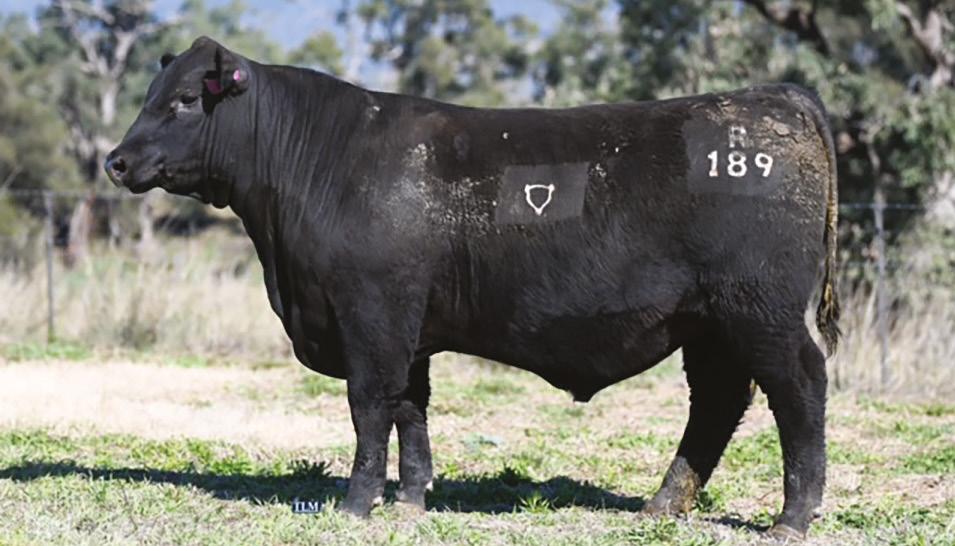

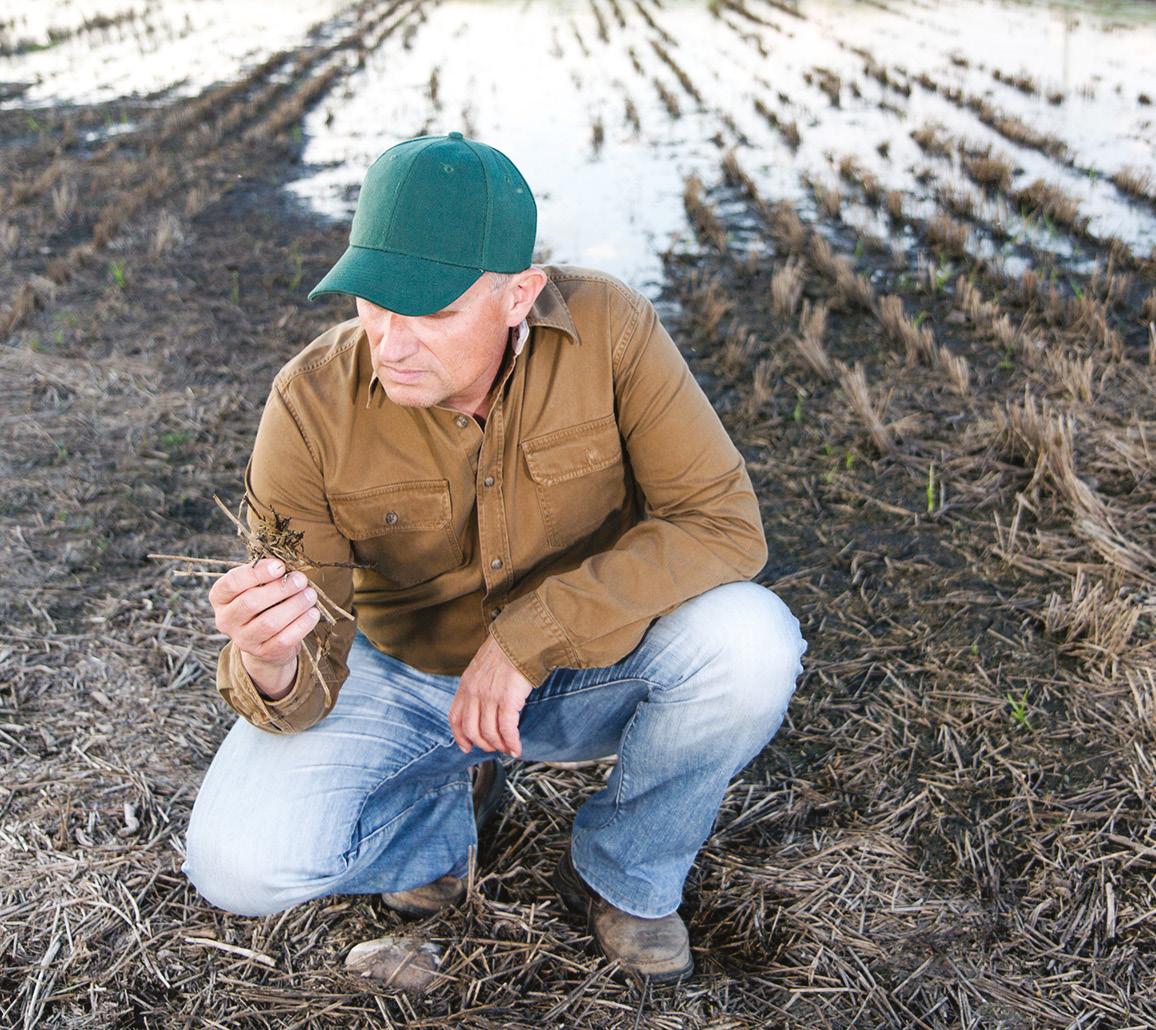
Local councils estimate successive floods and torrential rain has caused $2.5 billion in road damage across NSW. Where will the money come from?
Words MICHAEL BURT“It was an absolute nightmare,” said NSW
Farmers Member Tim Needham “The only two roads that lead into our farm were impassable for at least six weeks.”
Tim runs a small sheep farm in the Yass Valley and works in the construction industry
“I had to take four days off work because we could not get out. It was just too dangerous,” he said� “And there was no way of getting a vet out here if we had a problem with the sheep�
“Luckily, I have a Hilux with a lift kit and mud tyres to get out We still got stuck a few times though, and had to get pulled out by the neighbours.”
Tim decided to leave the Hilux on the ‘good’ side of Old Gap Road and walk a few hundred metres back across a destroyed section road to meet his wife in another vehicle�
“We did that for a few weeks,” he said. “I have to leave for work at 5am, so my wife had to get up with me to take me.”
Yass Valley Council repaired one of Tim’s access roads in early December, allowing his family and their neighbours safer access to town to get Christmas supplies�
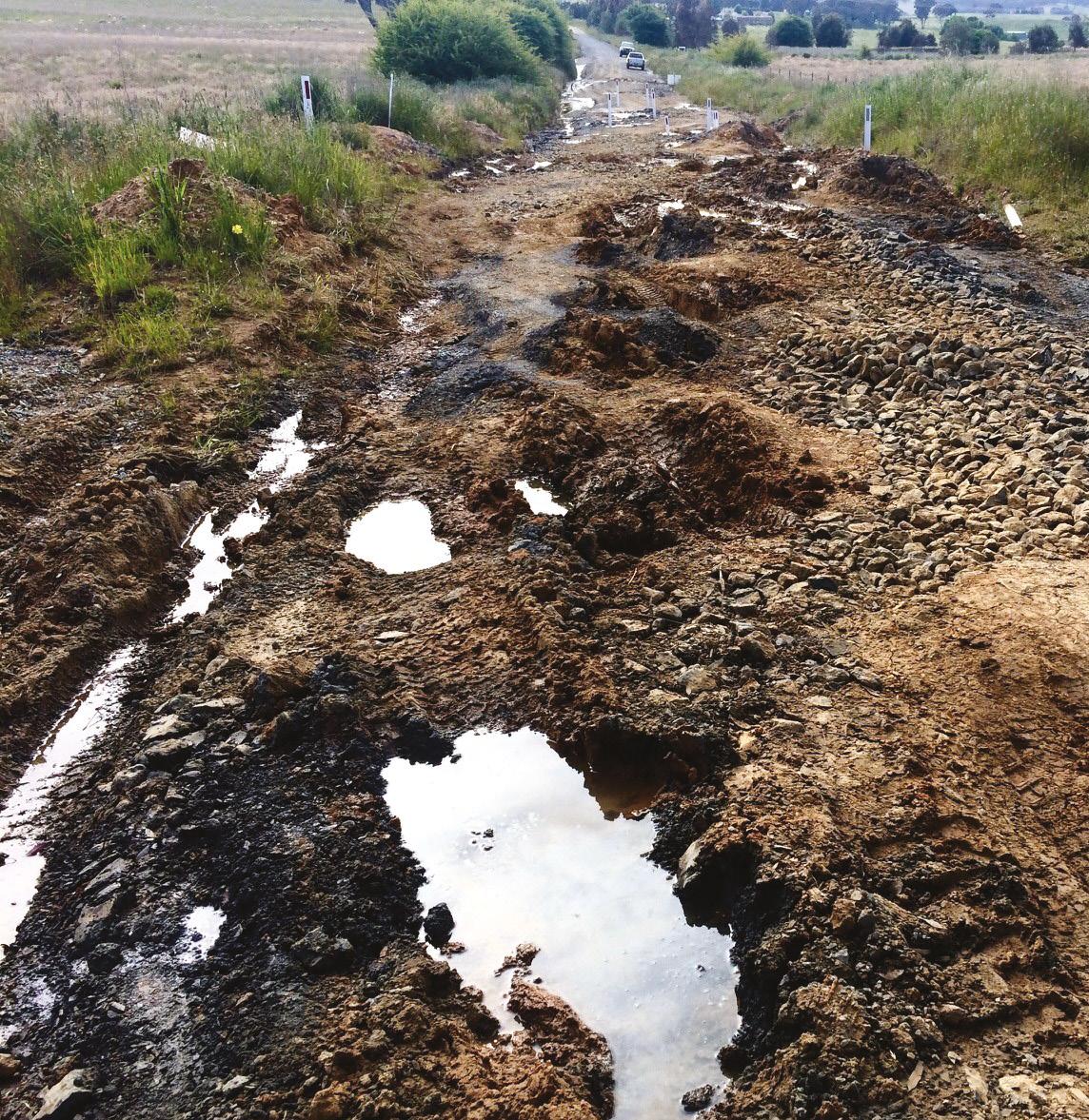
Tim’s situation was replicated all over NSW in 2022 as the local and regional roadwork collapsed under the weight of successive flooding and torrential rain
The NSW Government allocated $15 million in emergency funding to eight councils in Central and Western NSW for urgent road repairs It included deploying 200 people and heavy machinery from across the state to the Central West and Murrumbidgee to assist with the mammoth task of reconnecting the road network�
NSW Farmers Business, Economics and Trade Committee deputy chair Andrew Martel said the extra help to get road repairs underway was welcomed, and the total damage bill could be
enormous “It’s great to see these extra workers will be deployed to the worst affected areas, but there is simply so much damage out there that we could be looking at roadworks for many months to come,” Andrew said�
“Rural people are dismayed at how quickly the road network crumbled, and it’s pretty clear that we need to rebuild better so that we can avoid these sorts of headaches in the future
“We need to get rural communities and businesses up and running again, so we can do our part in the food and fibre supply chain.”
In 2022, the local and regional road network across NSW collapsed under the weight of successive flooding and torrential rain, leaving many farmers stranded.
“Rural people are dismayed at how quickly the road network crumbled, and it’s pretty clear that we need to rebuild better so that we can avoid these sorts of headaches in the future.”
–ANDREW MARTEL NSW Farmers Business, Economics and Trade Committee deputy chair.
Emergency funding for urgent road repairs was fast-tracked by the NSW Government, and Andrew thanked both the state and federal governments for their response�

“To their credit, the authorities are listening to communities and providing support,” Andrew said. “The problem is that there’s just so much work to be done
“Even if we had a limitless stream of money to fix these roads up, it’s unclear who would actually do the work�
“We need resilient communities and resilient roads, but to get there we may well need military engineering support to help get back on track.”
Local Government NSW (LGNSW) took the step of declaring a Statewide Roads Emergency to attract more state and federal government funding.
LGNSW estimates the damage bill will be $2�5 billion, with more than 10,000 kilometres of roads to repair
LGNSW President Cr Darriea Turley AM warned that without additional funding, the economic and social harm caused by this emergency would be long term
“More than 220 natural disaster areas were declared across NSW last year, leaving the road network in a state of disrepair,” Cr Turley said.
“Road repair funding pledged to date has

fallen well short of what is required so we declared a Statewide Roads Emergency to get help before the situation becomes even worse.”
As part of the Statewide Roads Emergency, LGNSW called for an acceleration and significant increase in funding for the $1 1 billion Fixing Local Roads and Fixing Country Bridges Statewide Roads Emergency program, and new funding to provide councils with plant machinery and skilled workers to expedite road repairs�
“Thankfully, both the state and federal governments did start listening to our concerns,” Cr Turley said�
She noted assistance from the NSW Government’s $50 million Fixing Local Roads Pothole Repair Round and the widening of eligibility for the federal government’s $1 million Local Government Recovery Grants
“While this is a welcome start, we all know that these announcements alone will do little to overcome the emergency we face, with conservative estimates putting the repair bill across the state at $2.5 billion,” Cr Turley said.
“The roads emergency is not confined to one particular region of the state, meaning we require funding for all councils – rural, regional and metropolitan – to help them rebuild their road networks�
“The wider rural communities supporting Australia’s food bowl are on their knees, waiting for the network to be repaired.” l
A high school in Orange and a tiny primary school in Hermidale are rebooting the importance of agriculture through paddock-to-plate education initiatives.
–
Words MICHAEL BURTSarah Eyb’s passion for teaching students about the importance of agriculture has been reignited at the Orange Anglican Grammar (OAG) School’s Agricultural Centre of Excellence (ACE).
The experienced agriculture teacher was contemplating a new career in the livestock industry, but a chance meeting with OAG Headmaster Rev Louis Stringer changed that plan
“They were looking for a new agriculture teacher and Louis asked if I knew anyone Then he said what would you do if you were the agriculture teacher here,” Sarah says.
“I told him what I would do, and he said, ‘Go home and write me a proposal then’� Louis happened to be thinking along the same lines in terms of teaching agriculture, so the planets aligned and ACE was born.”
That was two years ago and Sarah’s proposal was the inspiration behind the OAG’s ACE learning project and a new role as an agriculture teacher and ACE coordinator.
The unique project is a Prep to Year 12 program that embeds agriculture across National Curriculum outcomes utilising the school’s three-hectare farm and new ACE building.

The new building was officially opened in November last year, with 140 guests served a lunch menu created by the school’s food technology department using ingredients grown at the school
“The new ACE building caps off a whole precinct that also features a series of undercover yards for sheep and cattle� Integrated into that is a classroom which has cafe-style windows, so students can watch livestock demonstrations while working�
“We have vegetables growing in a garden as well as in the aquaponics system, a first cross flock of sheep producing prime lambs and four Flow Hives for honey
“There is also a two-acre regeneration paddock, which is now going into its third year That project has been a learning experience for me as well as the students.”
Sarah said the ACE program has resulted in more students taking up agriculture in their senior years�
“We had nine students in years 9 and 10 doing agriculture when I started here. This year I had 31.”
NSW is the only state where agriculture is part of compulsory food and design technology subjects in years 7 and 8, but Sarah believes the importance of farming is still lacking in many classrooms
“Ag is actually missing in a lot of schools in years 7 and 8 because the entire unit is filled with learning about food technology�
“Fortunately, we have a tremendous food tech teacher that puts food production and what we grow front and centre in the classroom Everything we grow goes through the school’s kitchen to deliver the food technology teaching program
“This involves the food tech students doing the harvest so that they understand the quality and quantity parameters of food� We very much work as a team� For example, year 7 students had to design a chicken burger using meat from chickens they have raised from one day old, vegetables and herbs grown here, and fresh eggs
“So it’s a full food technology project that also involves the agriculture behind the food.”
The ACE program also enables agriculture to be incorporated into maths teaching for the younger students, who need to measure, weigh and calculate yields�
In addition to aspirations for all things agriculture, Sarah has been able to utilise a vast array of industry contacts to further enhance the learning experience
“We are also in a community partnership with
The Agricultural Centre of Excellence (ACE) at Orange Anglican Grammar School aims to highlight the importance of teaching agriculture in the curriculum. From just 9 initial students, the program has now grown to 31 (pictured above).
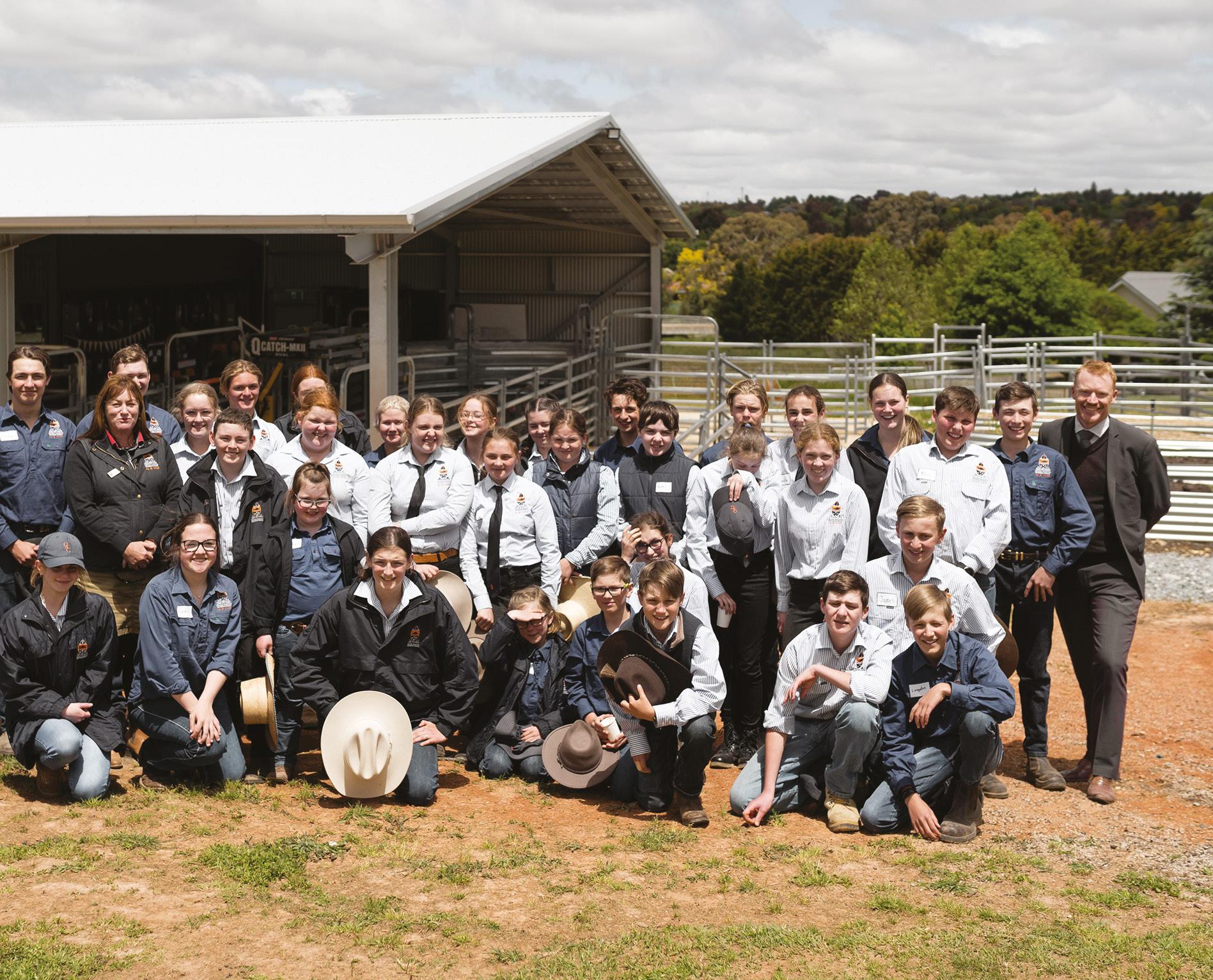


Landcare in growing and breeding dung beetles to identify winter active species that we can release in the Central West region� That has been great in teaching the kids about the importance of dung beetles for carbon retention, soil health and parasite reduction.
“The dung beetles are about the only thing we don’t eat from the ACE facility.”
Sarah has also linked up with the NSW Farmers Orange branch, who donated $1,000 towards equipping the ACE centre and a complimentary NSW Farmers membership�
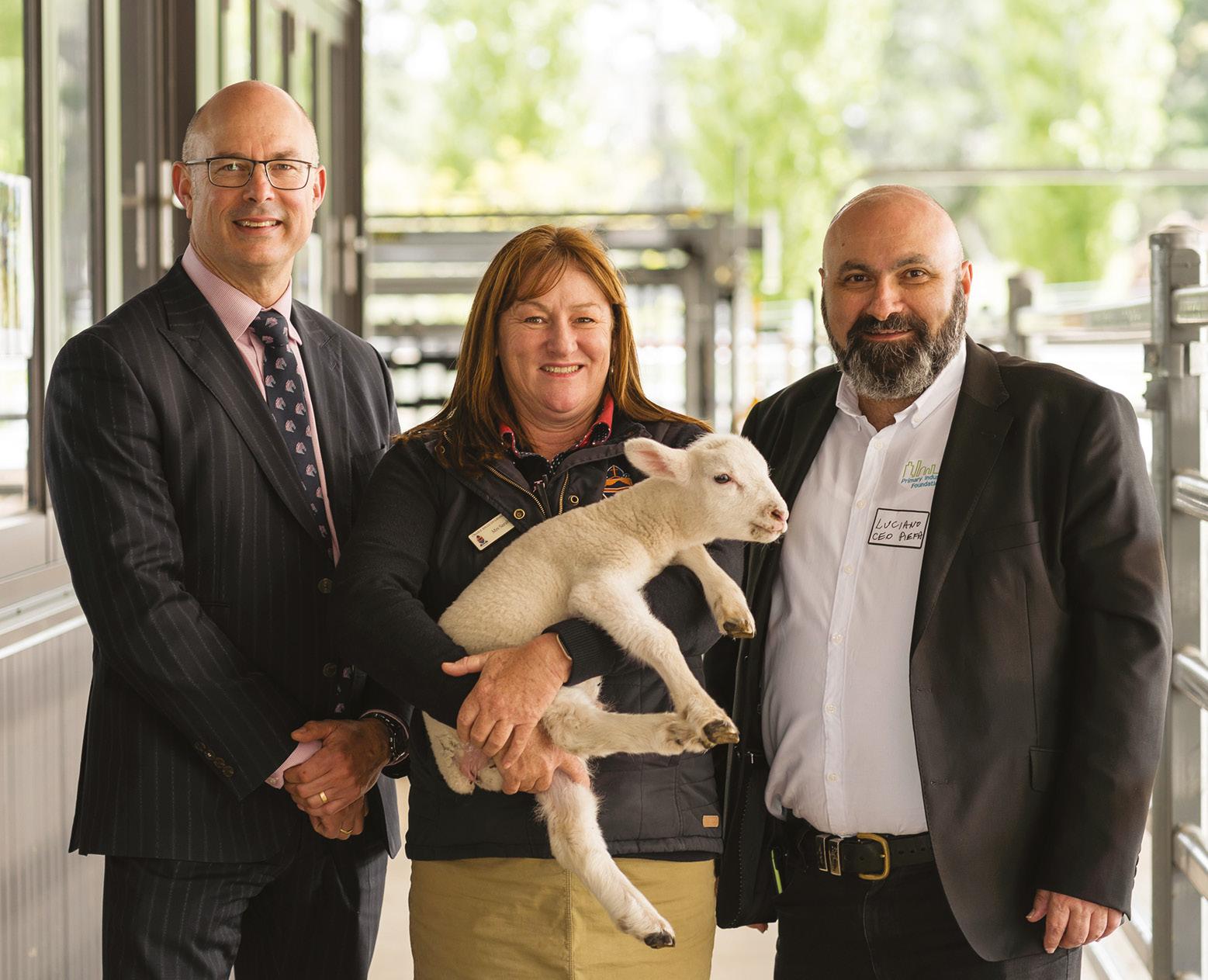

Seven students� 85 hectares� Three years� 170 tonnes of wheat A cropping project like no other
That’s a short summary of a massive achievement for the Hermidale Future Farmers (HFF) project at the tiny Hermidale Public School located about 200 kilometres northwest of Dubbo
The project’s centrepiece was an 85-hectare crop of wheat that was harvested on November 22, 2022, and sold for around $50,000 to fund future HFF crops and school excursions�
The land, which backs onto the school, was donated by farmers Craig and Sharon Crimmond for three years
“One of the student’s dads coordinated the harvest There were two headers going, two trucks, a chaser bin and field bin. It was all very exciting,” said principal Skye Dedman.
This page, top to bottom: On farm at school –OAG students at the ACE farm, as a part of the ACE learning project; (L-R) Principal Rev Louis Stringer, teacher Sarah Eyb and PIEFA CEO Luciano Mesiti.
Above, right: Happy harvest result. Hermidale farmer Darren Mudford helped out with the wheat harvest for the Hermidale Future Farmers team.
“The kids were able to watch the harvest in action, get up into the header at lunchtime and visit the grain receival to see the wheat being sampled and ground into flour.”
The wheat was taken to a local receival depo and sold by one of HFF’s sponsors Arrow Commodities
“The wheat came back as high protein, which was great, but the falling numbers did downgrade the quality a bit
“The kids also had a meeting with Arrow to help them to understand the logistical side of wheat marketing and exporting as part of learning about different types of wheat� We also had a focus on seed germination, the growing process and harvesting process.”
Skye said the project was the vision of classroom teacher Rebekah Harris, who first pitched the idea in 2020
“Rebekah has really been the driver and has done a fantastic job� I have just been nodding my head and saying ‘yes’ because they are all such good ideas�
“The school’s P&C are partners in the project and did all the initial fundraising, while we did the educational side As with small communities, everyone jumped in to support and help run merchandise stands and raise funds

“The money raised from the wheat crop will go to the P&C and it has been earmarked to fund the project this year, which will focus on the paddock to plate journey for wheat�
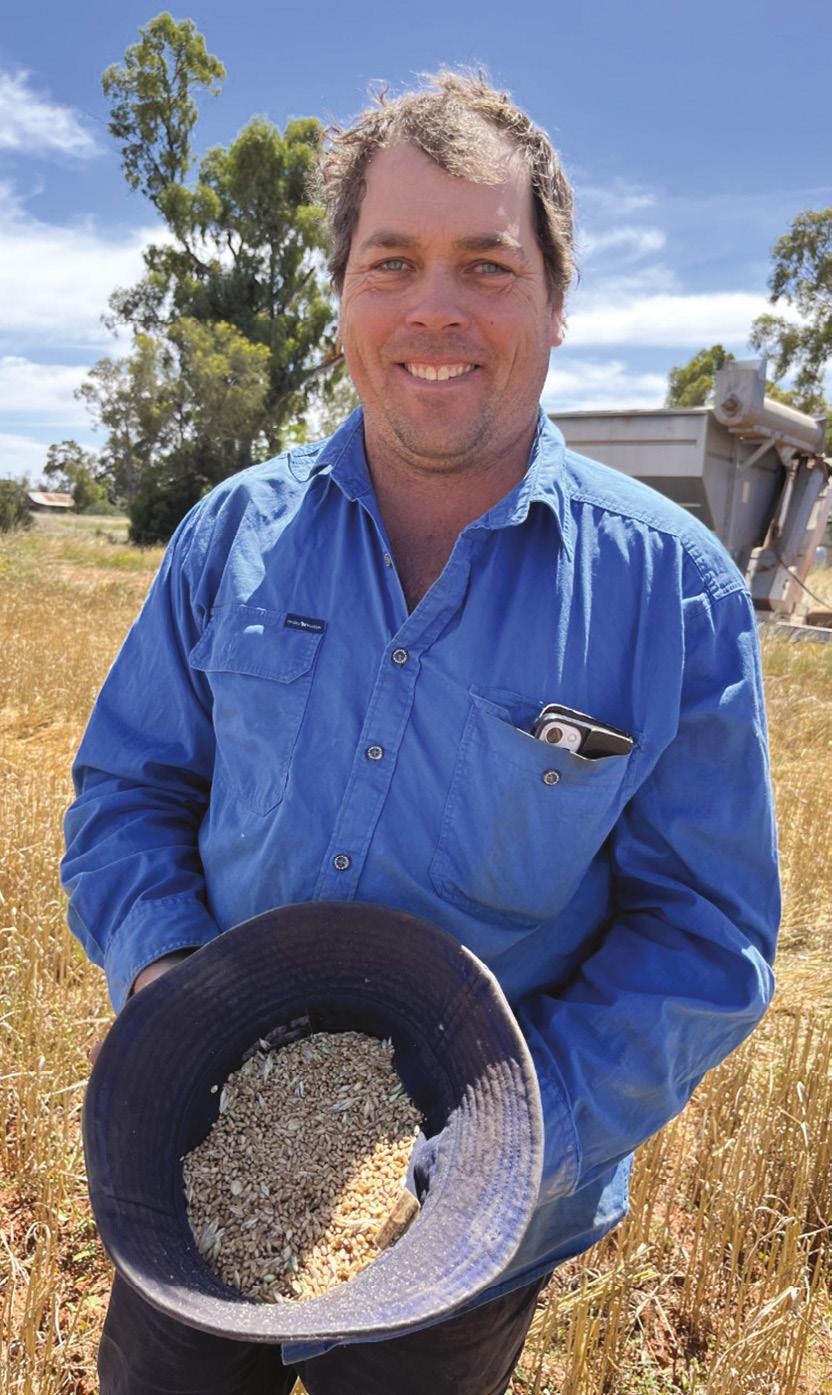
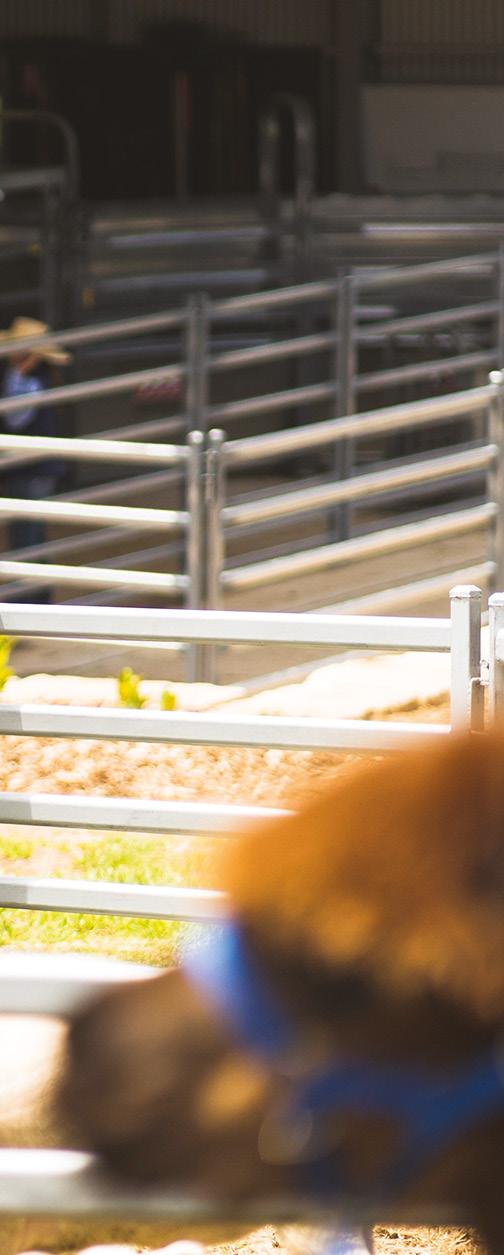
“That includes funding planting this year and we are looking at a school excursion down to Victoria via the Port of Newcastle and some rice farms in the Riverina.”
The HFF project is part of a bigger scheme called Growing Our Future, which complements learning about the food chain for wheat with educational tours focused on other agricultural commodities�
“As part of the educational side last year, we took the seven students to the Northern Territory,”
“We often bring out a map of the world and talk about the global markets where our wheat could end up. Our students can tell you what is happening in Ukraine and how it’s affecting the wheat market.”
Skye says� “The Northern Territory Farmers Association helped out and we got to see buffalo farms and fruit orchards
“It gives the students the opportunity to look at agriculture as a whole Our school’s motto is Reach for the Stars, so we talk about how the students are only at the start of what they could achieve anywhere in the world�
“We often bring out a map of the world and talk about the global markets where our wheat could end up� Our students can tell you what is happening in Ukraine and how it’s affecting the wheat market.”
Sarah said the number of Hermidale Future Farmers increased to 10 in late 2022
“It’s very exciting for a small school like ours when a new family arrives.”
Other sponsors of the project included Omni, Aeris Resources and Tritton Hermidale�
According to an extensive 2022 study by CQ University (CQU), agriculture is poorly understood in most Australian schools
In the largest ever survey of its kind, CQU’s Agri-tech Education and Extension research team surveyed more than 5,000 primary and secondary students across Australia about their knowledge of agriculture.

Four in five primary students and three in five secondary students surveyed believed commercial milking of dairy cows occurs by hand, rather than machine�
Research team leader Dr Amy Cosby said the study found many students regarded agriculture to be a low-tech industry
“Agriculture is in a period of rapid technological advancement, but modern farming practices are not being adequately portrayed to Australian students,” Dr Cosby says �
The study showed student awareness of agricultural careers was also limited, with many only able to recognise traditional roles such as a ‘farmer’ and ‘beekeeper’ as jobs
Dr Cosby said this was likely a contributing factor to the industry’s current skilled workforce shortage
“If students are not being shown an accurate vision of modern agriculture, they are unlikely to recognise that agricultural jobs can be highly skilled, well paid and possibly located outside rural areas,” Dr Cosby says.
NSW Minister for Education and Early Learning Sarah Mitchell agrees, and is pushing to ensure agriculture is a compulsory component in the Science and Technology syllabus in primary schools� “It is crucial that our kids know how milk is produced,” Minister Mitchell says�
“Given the crucial importance of agriculture now into the future, we have to make sure that all of our kids –including those in the city – learn about agriculture at school.”
“Too often, people living in capital cities buy food from the supermarket and clothes from the shops and give little thought to the food and fibre processes and production that led to those products appearing on the shelf.”
Minister Mitchell said the NSW government was undertaking a syllabus overhaul to ensure a new science and technology kindergarten to year 6 syllabus includes content on food and fibre production, which would be mandatory in schools by 2024�
“This is part of our once-in-ageneration Curriculum Reform, which is currently underway, and we are also looking at opportunities to strengthen this content.” l
a
“Given the crucial importance of agriculture now into the future, we have to make sure that all of our kids – including those in the city –learn about agriculture at school.”
–SARAH MITCHELL NSW Minister for Education and Early Learning








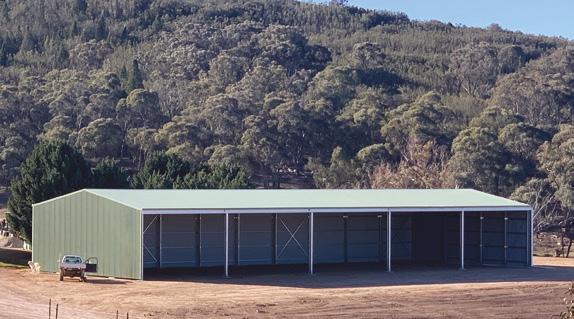

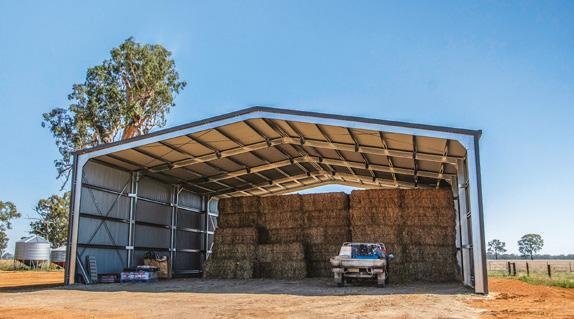
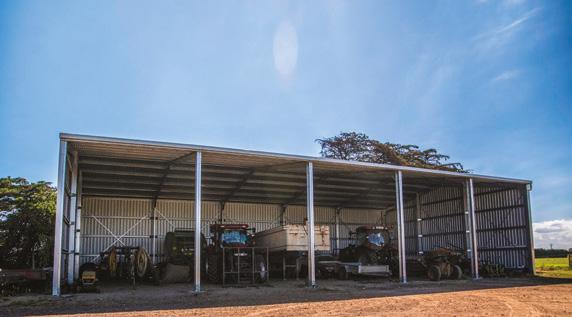

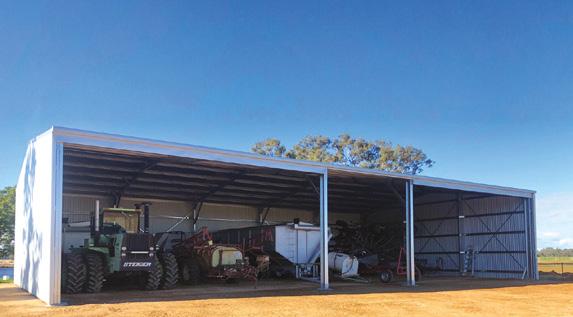


Rising food prices and food security concerns are growing issues in Australia. NSW Farmers’ Economist Brendan O’Keeffe explores food trends and pushes for a refresh of the decade-old National Food Plan.

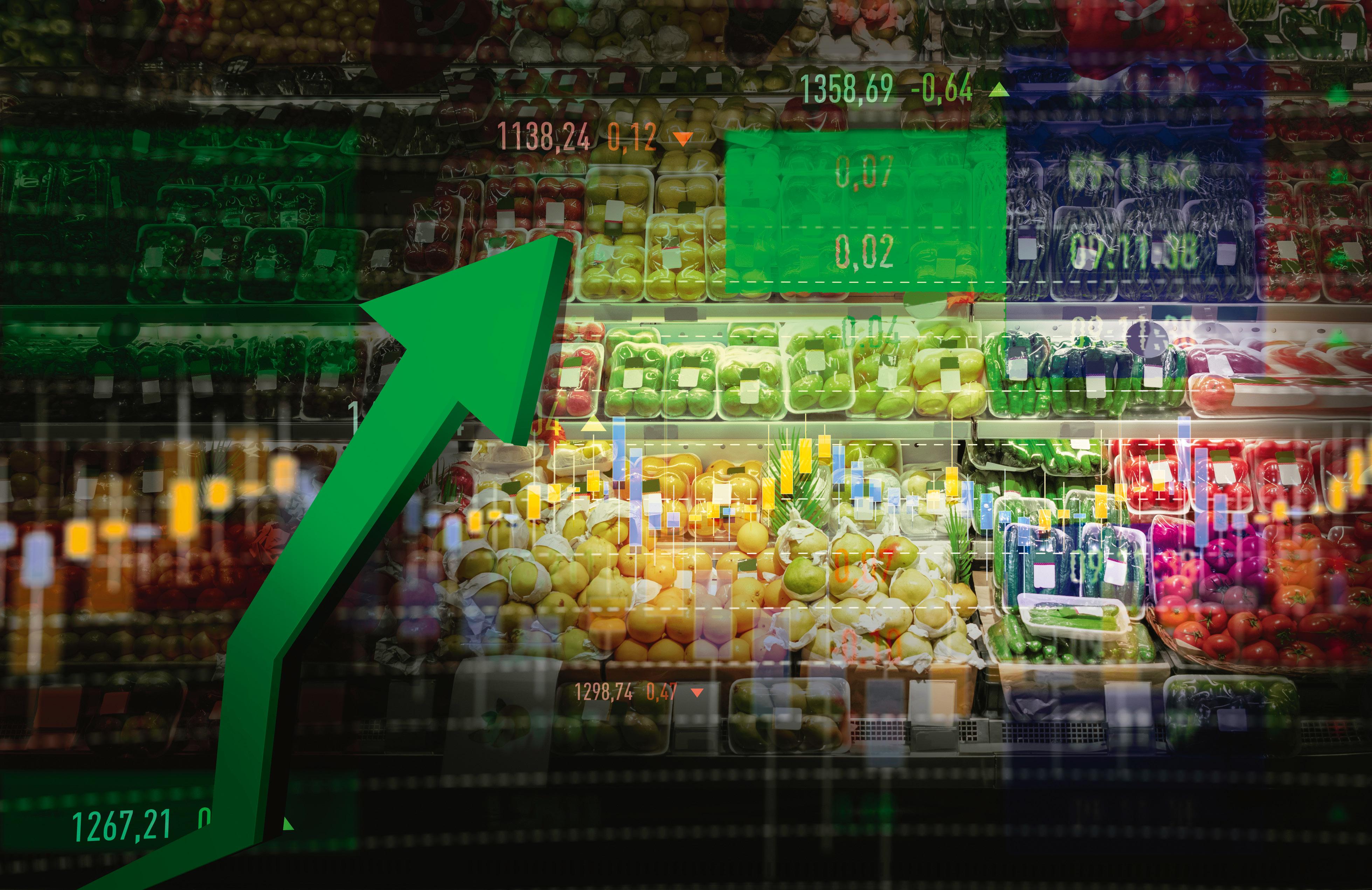
Agriculture is inextricably linked to the cost of living� Households in NSW spent $11,363 on food in 2020/21, which made up 9 6 per cent of the total household spending budget, an increase from 8 7 per cent in 2015/16� Nonetheless, attention is only paid to food prices when one-off events cause individual items, such as lettuce, to reach eye-watering heights, before subsiding into the background of political consciousness

This is in direct contrast to the cost of utilities, which accounted for only 3 1 per cent of household expenditure in 2020/21� However, it is the recent energy price increases which have led to acknowledging that a complete structural transformation of the sector is required, underlined by the $20 billion investment in transmission lines announced in the recent Federal Budget
Our food and agriculture system, however, remains on the policy periphery, despite its share of household expenditure being over three times that of utilities� For example, the National Food Plan is almost a decade old and
has only been gathering dust rather than guiding strategic interventions� There is no national climate change policy for agriculture� There is no sustainable funding source for biosecurity There is no lead agency responsible for addressing problems in our food system
The list goes on As food is a necessity, its price and any associated increases have important implications for the welfare of society and the broader economy� Food affordability is a function of food prices and household incomes Wage growth was 2 6 per cent over the year to June 2022, while food prices over the same period increased by 5 9 per cent (with a further increase to 9 per cent over the year to September)� With food prices increasing at a faster rate than income, food is becoming more expensive and difficult for families – especially those experiencing disadvantage – to afford The top cause of food insecurity in FoodBank’s 2022 Hunger Report was the rising cost of food and groceries
There are also broader economic implications� As food is a necessity, it needs to be purchased regardless of income levels� Therefore, as food gets more expensive, it takes up a higher proportion of the household budget, leaving less money to spend on other more discretionary items and to save Food prices have not historically been a contentious issue in Australia, with an abundance of land leading to high per capita levels of food production, and deregulation resulting in both productivity gains and low prices from increased competition Figure 1 compares the food and non-alcoholic beverage consumer price index (CPI) to the global Food Price Index compiled by the International Monetary Fund (IMF) It shows how food prices in Australia were immune from spikes that occurred from 2008 to 2015, and even during the beginning of the pandemic� The uptick in 2021-22, however, indicates that the situation may be changing
Data on a more localised level is also enlightening Figure 2 shows how local prices for food and non-alcoholic beverages have decoupled from the CPI since 2000 and continues to be at a higher price level� Ideally, we would want the opposite to occur; a resilient food and agribusiness sector which provides affordable food to consumers regardless of external shocks
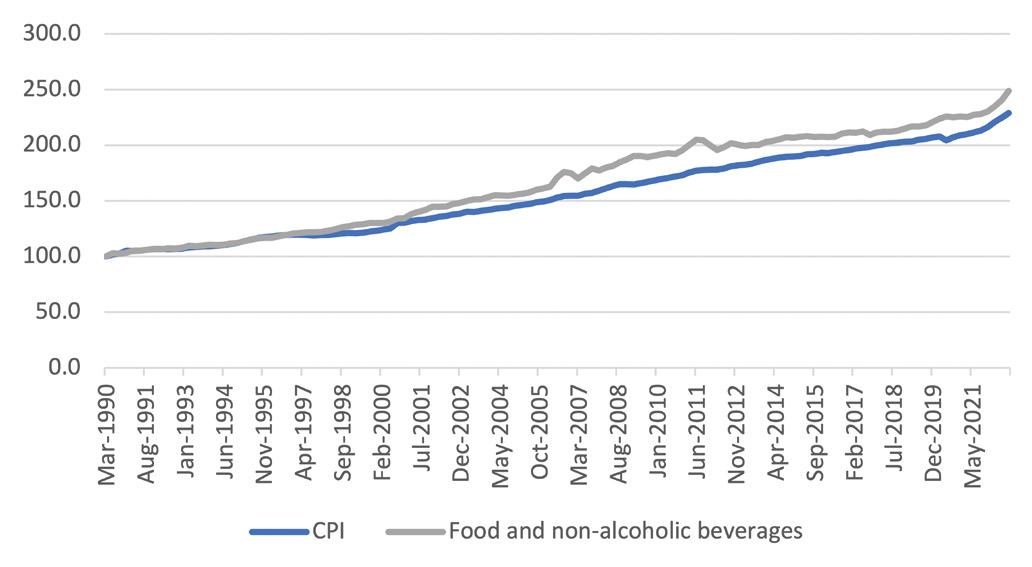
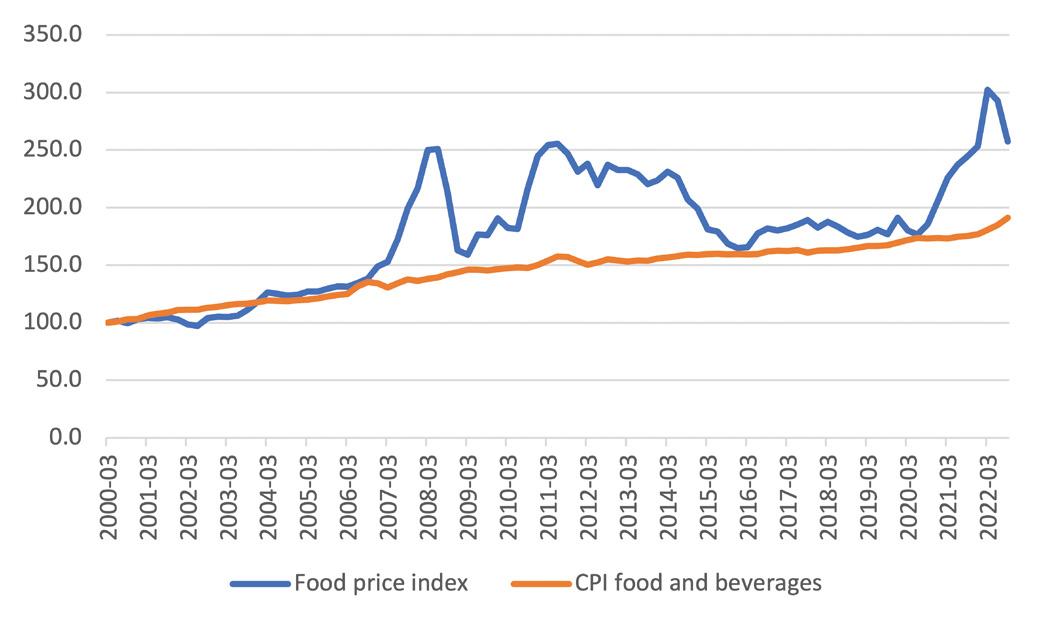
To achieve this and build on the gains already made by the sector, Australia needs a renewed National Food Plan which is evidence-based, embedded in government activities, reported against, subject to monitoring and evaluation, and clearly articulates the importance of the agricultural industry as a foundation of food security in Australia – and globally
GUIDANCE FROM CANADA AND THE UK Canada and the UK are two countries that have already started on this important journey, and which Australia should look to for guidance�
The Food Policy for Canada has the following overarching goal: “all people in Canada are able to access a sufficient amount of safe, nutritious and culturally diverse food Canada’s food system is resilient and innovative, sustains our environment and supports our economy”.
This statement recognises the two sides of food security: the first part addresses consumption while the second is concerned about production levels, including environmental services�
These are two fundamental elements of the policy which should be adopted by any Australian policy The Canadian Food Policy Advisory Council (CFPAC) provides advice on the nature of food challenges and solutions to address them while also aiming to build trust among key food system stakeholders to support the ability to collaborate across sectors� Reporting on results is a crucial way to measure and track progress towards outcomes and support evidence-based decision making�
The six long-term outcomes being tracked by the CFPAC are: vibrant communities, increased connections within food systems, improved foodrelated health outcomes, strong indigenous food systems, sustainable food practices and inclusive economic growth Only one of these outcomes, however, directly addresses the goal of a ‘resilient and innovative’ production system�
As a further example of leadership in this field, the UK Government Food Strategy, released in June 2022, more explicitly addresses supply issues which have implications for food production and, by extension, food security For example, it includes a commitment of £390 million (A$695 million) to develop new farming systems through agtech and innovation, and working with the Migratory Advisory Commission to review occupation shortages in the agricultural sector�
While these two policies provide some guidance, experiences in the energy and waste sectors closer to home show the dangers of short-term planning of essential public services In terms of energy, Amanda Mackenzie from the Climate Council stated last month, “Unfortunately, we’ve had very little action in the electricity system from the federal government in the last 10 years which means we’re not as set up as we could have been for a smoother transition.” Australia has now run out of time to replace old, expensive and polluting coal-fired power plants, with the result being retail electricity prices expected to soar by up to 35 per cent as the system struggles with the energy transition and a global supply crisis
The fragile domestic waste industry was exposed when China stopped accepting the world’s waste in 2017� This led to a complete breakdown of the system, with the double-edged sword of costs to councils – and therefore ratepayers – skyrocketing, and recyclable materials being sent to landfill
These two crises, however, have led to meaningful action The NSW Electricity Infrastructure Roadmap is expected to attract $32 billion of private investment into the energy sector while the National Partnerships on Recycling Infrastructure aims to fill critical infrastructure gaps in Australia’s waste management system with over $1 billion of investment� Food insecurity is increasing in Australia, and it is time to strategically invest to solve structural issues in the system rather than waiting for a crisis to occur to make significant change
While meaningful action in the agricultural sector in respect of bolstering food security remains slow, there is some good news� On October 26, the federal Minister for Agriculture referred the House Standing Committee on Agriculture to commence an inquiry into food security in Australia Hopefully this is the first step towards the creation and implementation of a national food strategy
There is also an inquiry happening into food production and supply by the NSW Legislative Assembly Committee on Environment and Planning� The final report was released on November 1 2022 and the government response to this report is due on May 1, 2023� The overall findings of this inquiry were that:
• The approach to the food system is siloed and disjointed
• Various government agencies are responsible for separate policies
• There is no overarching government plan or strategy to address issues with food security and food supply�
• There is no lead agency that is responsible for addressing problems in our food system�
The overall recommendation to deal with these issues is that the NSW Government should develop a comprehensive Food System Plan for NSW, with clear objectives and measurable targets It is also pleasing
There are two sides to food insecurity: consumption and production levels, including environmental services. The National Partnerships on Recycling Infrastructure aims to fill critical gaps in our waste management system with over $1 billion of investment.
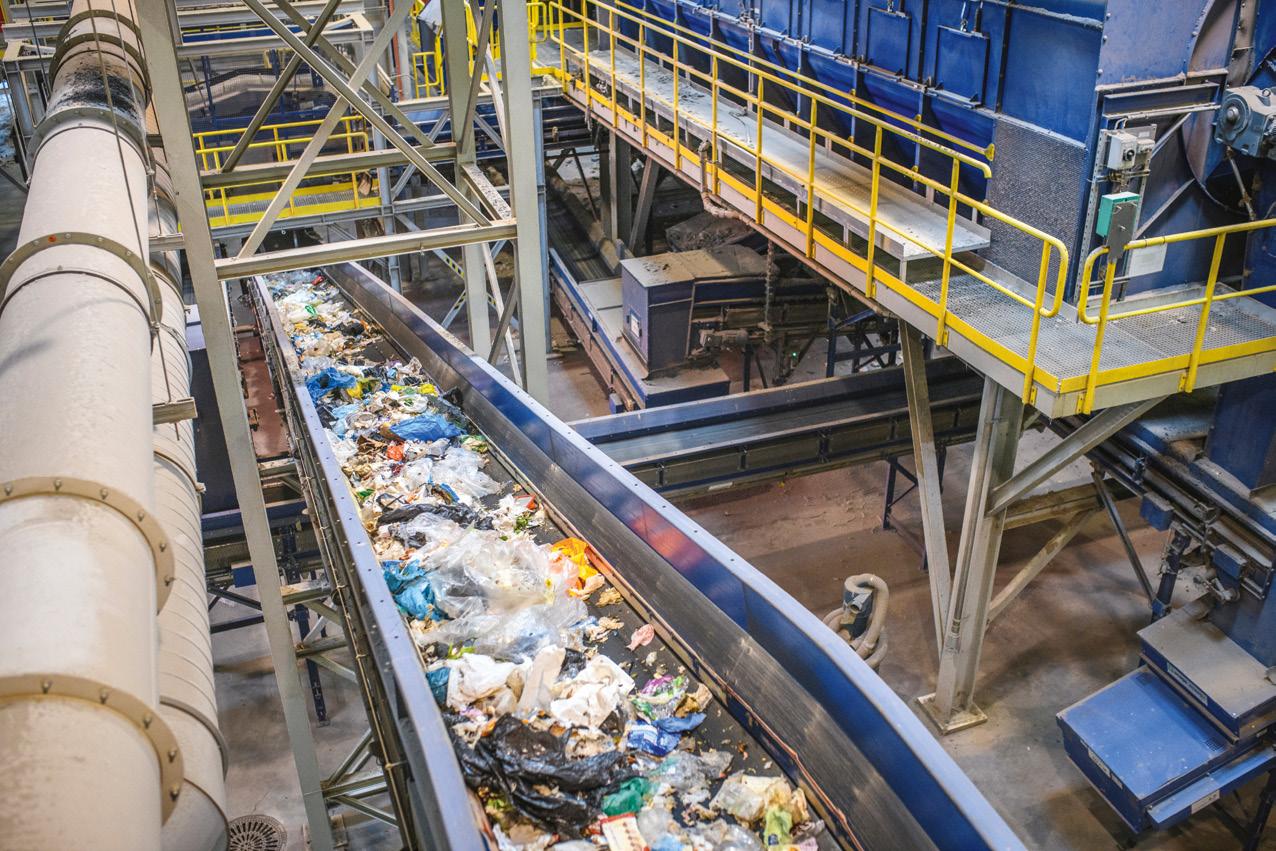
to see that similar to Canada’s Food Policy Advisory Council, it recommends the creation of a Food System and Security Council to implement the plan and act as a single coordinating body�
There is also the recognition of agriculture’s role in food security, with several specific recommendations targeting systemic supply issues including:
• The adoption of policies to limit the ability of major retailers to impose aesthetic standards for produce, leading to significant food waste
• The creation of land use offices in food production regions to help businesses adapt to and benefit from the renewable energy transition�
• The requirement for consultation with experts and stakeholders from industry and regional communities to develop a long-term food workforce strategy
• The requirement to set up a Help Harvest NSW network to help employers coordinate and promote work opportunities mapped to supply and demand cycles in specific regional areas�
While these are welcome initiatives, one noticeable gap is the need to support farmers adopting sustainable farming practices� The only action taken at this stage is on the demand side, through a sustainability labelling system for packaged food Action already being taken by the NSW and Australian governments in this space remains slow and disjointed
More needs to be done, and quickly, to ensure that sustainability is recognised as a core requirement
for the food system which will lead to increased investment and coordinated action�
A National Food Plan will ensure that the difficulties faced by Australia’s primary producers and agribusinesses nationally are alleviated� The reality is that agriculture is the very foundation of food security, with important contributions to climate change, biosecurity, health and environmental sustainability Indeed, a coordinated and considered National Food Plan will ensure the sustainable delivery of safe, healthy, affordable food – regardless of where people live or how much they earn� l
The top cause of food insecurity in Australia was the rising cost of food and groceries, yet attention is usually only paid to food prices during one-off price hikes.

Kincoppal-Rose Bay is known for its vibrant and welcoming boarding community.
KRB offers a range of scholarships and bursaries including a number of means-tested full boarding and tuition scholarships.
Applications for KRB scholarships for students entering Years 7, 9, 10 and 11 in 2024 are open until Monday 13 February 2023.
Visit www.krb.nsw.edu.au for more information and to apply.

We are not just a rural
WFI has a commercial insurance offering for your business and the ability to package domestic, rural and commercial insurance cover into one easy-to-manage policy.
A dedicated WFI Area Manager can assist when you need it most – they are there if you ever need to make a claim, and will support you throughout the process.
• Leading insurer with over 100 years of experience.
• Over 80 Area Managers across Australia.
• Flexible insurance options tailored to suit your needs.
• NSW Farmers members have access to a rebate off their NSW Farmers Membership fees.

• Choose to deal with your WFI Area Manager face to face. Contact
Our partnership with the NSW Farmers Association ensures that members benefit by offering a membership rebate and joint events so that we can come together and support one another.
WFI provides options that are designed for farmers, adapting to climate and industry demands.

WFI understands that personal service matters.
“I’ve always stuck by the ‘Boots on the ground’ approach – it’s the best way to do business.”
“The best part of the role is having the opportunity to go on to farms and be face to face with my customers while reviewing their Insurance needs – ensuring they are adequately covered.”
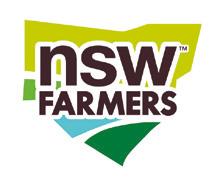




“I take pride in listening, and understanding our clients’ businesses, whether rural or commercial, in order to build positive relationships and ensure their insurance requirements are met.”
“Having an extensive background in the industry, I find it very fulfilling that I can add value and provide comfort to customers throughout their insurance journey – from sale to claim.”


“I enjoy working with my customers, providing old fashioned face-to-face professional service.”

“As a local, I can relate to those on the land, and am passionate about providing insurance solutions to meet our farming customers’ diverse needs.”Cindy Gilchrist Ricky Roberts James Shelton Mackenna Powell Connie MacMillan
If you’d asked a room of farmers a decade ago, or even a few years ago, if they would turn to Instagram to grow their business, there would not be many hands raised in the air. But things are changing. More and more farmers are seeing the benefits of being Insta-known. –
Words IAN LLOYD NEUBAUERLast Spring, farmers in the Central West were up in arms after thousands of influencers trespassed on their properties to snap selfies in canola fields for their Instagram pages, causing thousands of dollars worth of damage.
But blaming Instagram is like blaming your television set for bad news. It’s a tool that can be used for good or evil. To see the other side of the coin, we spoke to three influencers from the bush who have successfully harnessed the collective power of Instagram to help build their businesses and personal brands.

“I was on ‘Farmer Wants a Wife’ in 2019 and that’s where most of my followers came from. Before that I thought Instagram was just a photo-based version of Facebook,” says Neil, who runs a 2,000acre sheep and cattle farm near Rosemont in the Southern Tablelands of NSW. “But once I started marketing myself there I realised Instagram is a fantastic business tool if used properly. Because in the same way you can choose who you follow, you can also choose who you market to.


“When you have a relatively small number of followers as I do, the pay-off is not often in cash. It’s usually a product-based sort of thing. I have a deal with a clothing label. I market their products and in return, I sort of get free access to their clothing,” he explains.
“I also have dealings with the Australian Wool Network and AWI (Australian Wool Innovation) and make sure they are tagged in all my posts. Covid-19 kind of threw a spanner into our collaboration but I am hoping to make it happen again soon. Wool is my passion and if there is one thing I hope I can drive through Instagram it’s wool and wool products in Australia,” says Neil.
Some may ask, does everything on Instagram need to be flowery?
“It depends on your market, but basically, for me, it’s a yes. My followers don’t want to know about the hard stuff about farming or the boring day-to-day chores. They want to see cute little lambs jumping up and down in perfectly green paddocks,” he says.
Profession:
Handle:
Profession:
Urban gardenerHandle: @urbanveggiepatch
Followers: 145,000
FROM PATCH TO PLATE“I started Urban Veggie Patch six years ago – an online store that sells seeds, flowers, tubers, fruit, vegetables and gardening tools. Our best-selling product is an illustrated garden planner that helps people plan their gardens,” Lee says, who lives in Blacksmiths, a suburb of Lake Macquarie.
“Instagram has definitely been my most powerful marketing tool. As I learned more and more about urban gardening, I started sharing knowledge and my following just grew organically. There is great PR (public relations) value in having people following your ‘journey’ – it creates a platform to launch and grow a business because people love stories.”
Lee uses her garden planner as an example. “Posting photos are great as they show off the product, but the real cut-through I get is from creating videos – what Instagram calls ‘reels’ – that show people how to use it in everyday life.
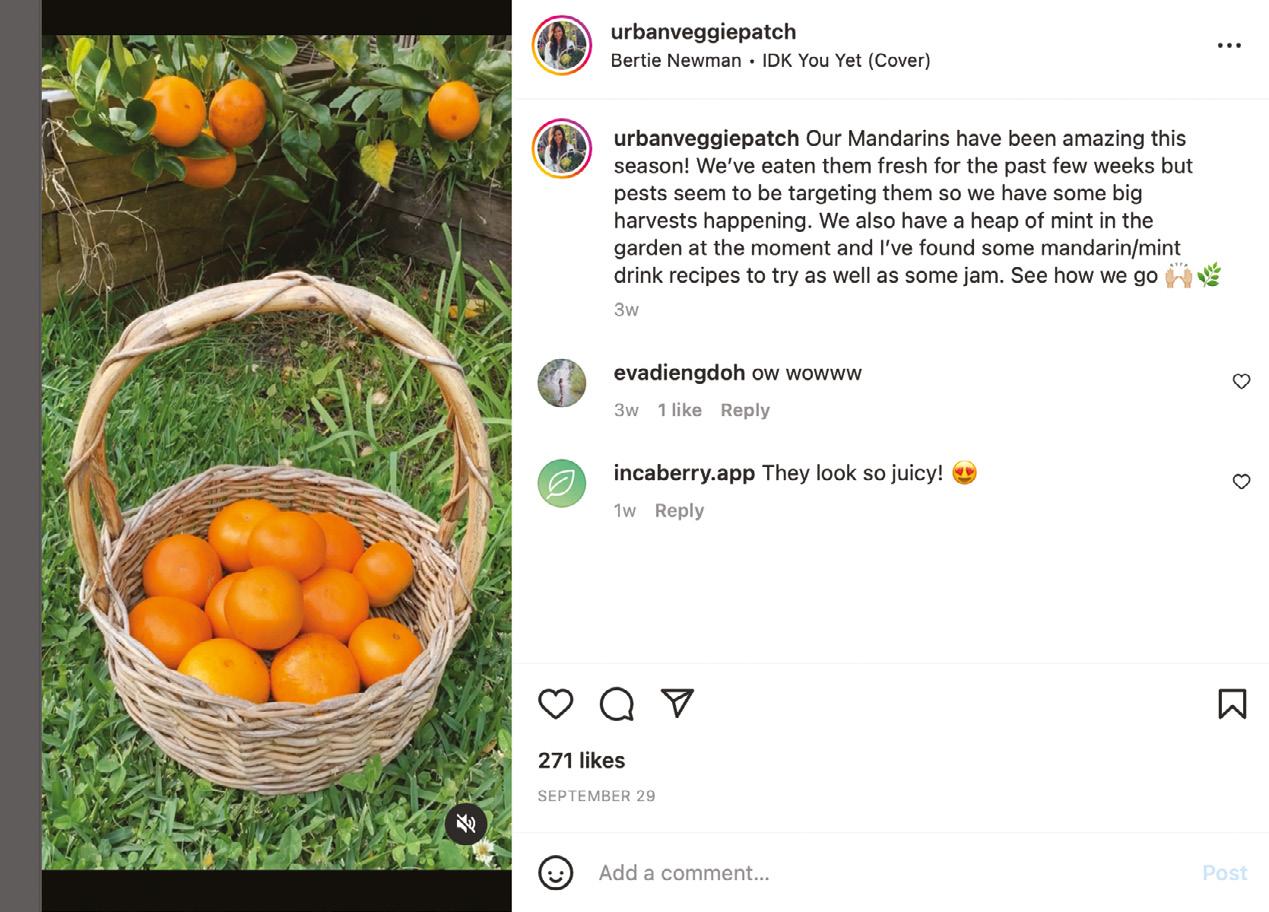


“In one reel we recently posted, my business partner shows how she draws her gardening bed in the planner,” Lee explains. “You don’t need any big equipment to make reels. I use my iPhone – it’s one of the latest models and comes with some pretty good in-built editing tools – but there are also some apps you can buy such as Splice, that will help you.”
Lee points out that Instagram is an ever-changing product, so things can move quickly.
“When I started using Instagram, photos were the thing. So I would post a nice photo with written information – a caption – and I felt that was what got people in and had them learning. Then Instagram started promoting the reel format and I had to make the change towards video, but I still add written captions as it allows me to give my followers more specific information.”
So, how does Lee think you can get started?
“Firstly, sign up for an Instagram business account instead of a regular account. You can use it to link your website and products, so when you promote a specific product you can add a link that people click on and it takes them directly to that product on your online store,” she says.
“I have been doing this for a long time and I understand how it all works. But if you are new to Instagram I do see how there is value in hiring someone who is well-versed in social media to get you started.”
Name: Emme Williams
Profession: Veterinary study
Handle: @eemmewilliams
Followers: 14,700
THE COW WHISPEREREmme Williams is a finalyear veterinary student at Charles Sturt University in Wagga Wagga and the 2022 recipient of the NSW Farmers John White Memorial Tertiary Scholarship.
“I started using Instagram because I like the idea of sharing what it’s like to be a vet, how the crops are going and why living and working in the country is so incredible,” she says.
“Instagram is also a great tool to connect and it’s helped me make friends with many different people who I’d otherwise never meet. I also follow other students who share stories about how they are getting through vet school and veterinarians who share stories about their work.”
Emme explains that all of her followers are organic – they came about naturally. “I didn’t do any ‘business’ marketing. It’s just continued to grow over the years because I share stuff that appeals, like riding my horse around our amazing property, though I also share other stuff,” she says.

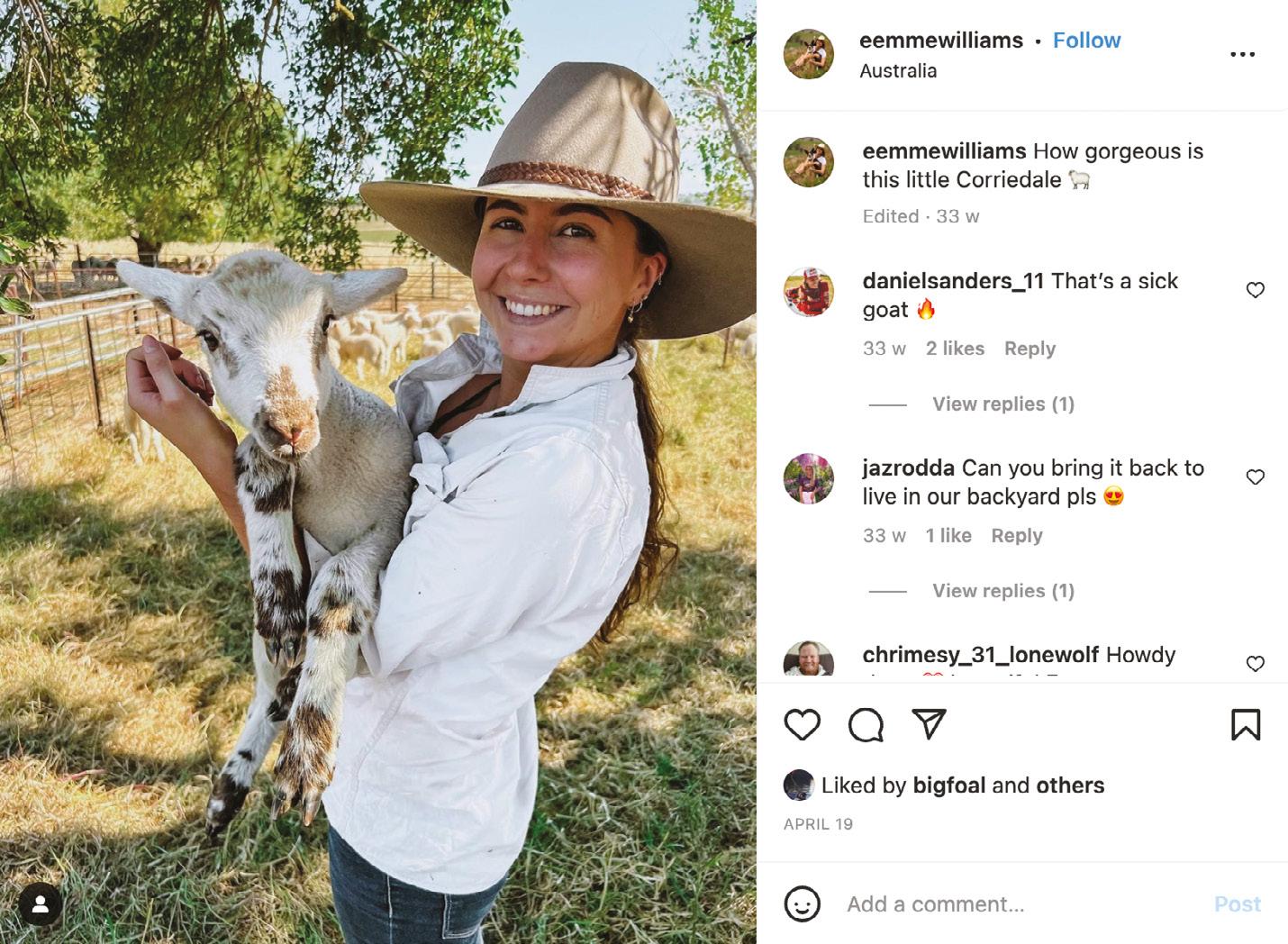
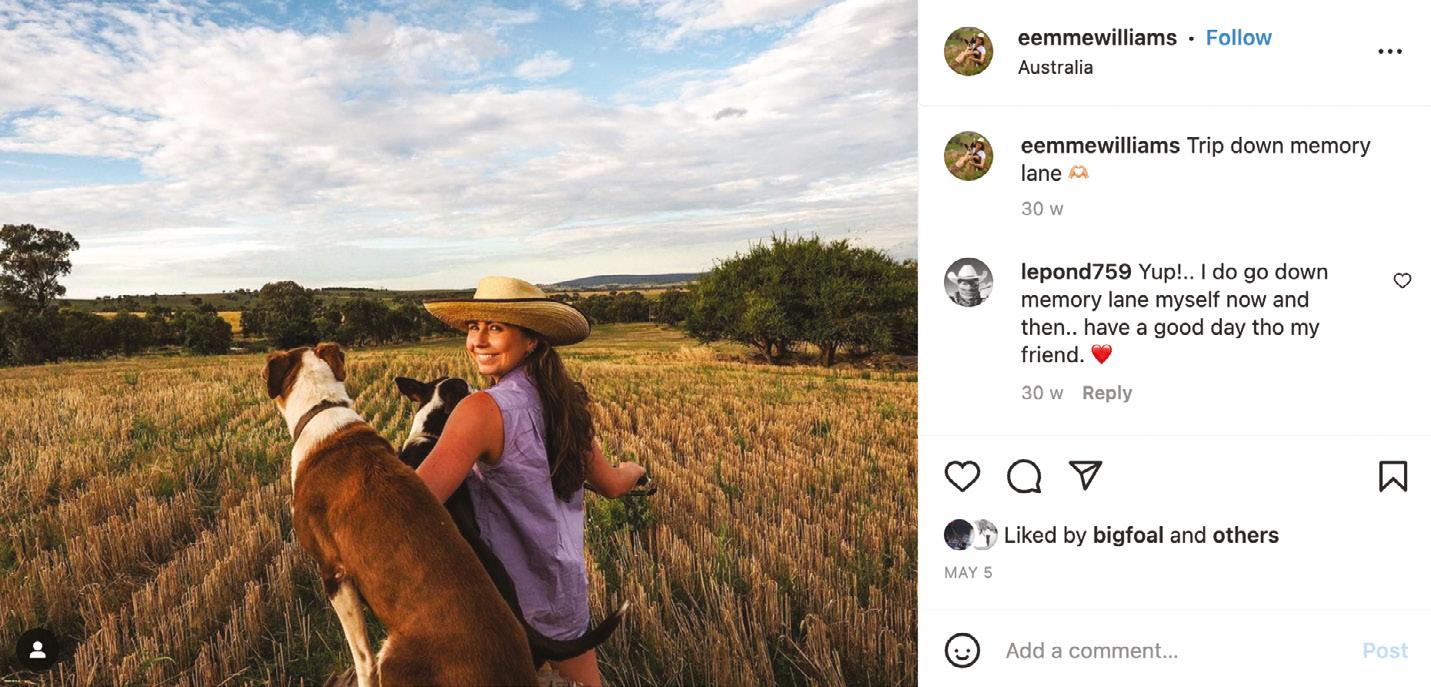
“One of the most popular photos I ever posted was of a cow caesarean where I was up to my shoulders in blood. People were shocked but not in a good way, because that’s what real life is like on a farm. My content is reliable and honest.”
Emme doesn’t have her own business to promote on Instagram, but she works with companies such as Eukanuba – a dog food brand. “So I post images of my dogs eating it and show how much they love it and in return, I get dog food and a cash payment. I only work with companies whose products I use and whose ethics align with mine.”
Emme says that Instagram has so many benefits but she warns that it can also be a big time-waster. “I use timers to set time limits on how long I spend on it and other forms of social media, and I only give myself 20 minutes a day. When that bell rings, I know it’s time to get off my butt and do some work instead of just staring at a screen all day.” l
A popular apple cider is set to help restore Batlow’s apple industry after scorching fires destroyed orchards in 2022. –
Words SUE WALLACE Photography MATT BEAVER
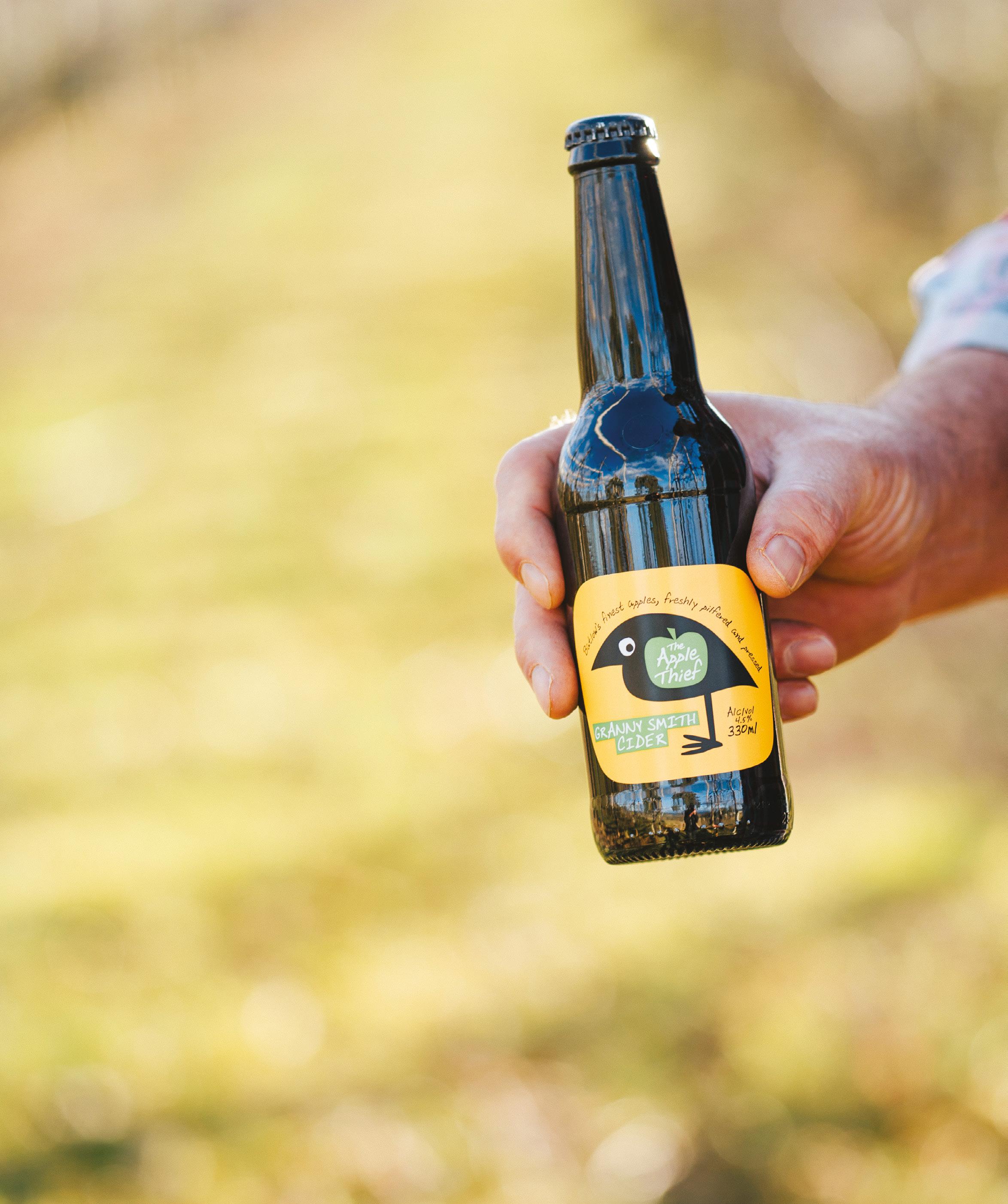
Dave Purcell, the creator of the awardwinning The Apple Thief ciders, has many fond memories of playing among the apple trees on the family farm at Batlow and later earning pocket money picking fruit.
It’s a lifestyle that Dave, a thirdgeneration apple grower, and partner Mel Dickson want to replicate for their sons, Jack, six and Sam, two.

They have returned to the NSW Snowy Valleys town of Batlow which has a population of about 1,700 and brought their successful cider business with them.

Dave is passionate about restoring and renewing the apple industry in the Batlow area which is still recovering from the devastating 2020 bushfires that wiped out many orchards and farmland.
According to Dave, the community has been gradually finding its feet again and is optimistic about the future.
He is determined that the local apple and orchard industry will bounce back bigger and better than ever, and Batlow will be again known as a tourist and ‘foodie’ destination.
“I grew up in the family orchards, in this town and these mountains, so it was an easy decision to come home to this community – I believe in my apples and I believe in Batlow,” Dave says.
He hopes that by bringing The Apple Thief business to Batlow, other businesses will be encouraged to invest in the Snowy Valleys region and in turn accelerate tourism in the area, increasing the demand for accommodation, dining and local produce.
After a decade of living in the Southern Highlands and commuting to Batlow to craft the next batch of The Apple Thief cider, the couple have taken over the former Wilgro Orchards on Batlow Road, where the next chapter in Dave’s story is taking shape.
Dave says the name and branding was inspired by the finest fruit which often sits right at the top of the tree, ripening to perfection and enticing local birds (the apple thieves).
There are big plans underway for a new The Apple Thief Cider House café, bar and immersive orchard experience to open in October 2023.
“The new cidery means that the in-demand line up of varietal ciders produced by The Apple Thief can be crushed, brewed, bottled and distributed in house,” says Dave.
“We are still a boutique producer, but this means we’ll be creating and supporting local jobs for local people – it’s what’s needed here as we regrow.”
The Apple Thief Cidery and Cider House project has been funded under the Bushfire Local Economic Recovery Fund, co-funded by the Australian and NSW Governments.

Dave and Mel have opened a temporary Cider House in the old Wilgro farm shop on their 40-hectare property, that includes 10 hectares of apple trees.
“Our little shop celebrates all things cider, but we’ll also be doing lots with Batlow’s famous fruit and other local and regional produce as well as offering light meals, great coffee and cakes,” says Mel.
The rustic store also offers tastings and sales of The Apple Thief ciders, along with a growing selection of locally produced, jams, honey, fruit and
“The new cidery means that the in-demand line up of varietal ciders produced by The Apple Thief can be crushed, brewed, bottled and distributed in house.”
–DAVE PURCELL
Creator of the award-winning The Apple Thief ciders
gifts. It is open from Thursday through to Sunday, from 8am to 4pm.
The range of bottled and varietal ciders, including Pink Lady, Granny Smith, Braeburn Gala and William Pear as well as non-alcoholic Pink Lady Cider can be ordered online or from the Cider House.
It seemed a natural progression for Dave to immerse himself in the apple industry and he was a worthy recipient of the Young Industry Leader by Horticulture NSW award which involved travelling to Denmark and Holland to research the industry.

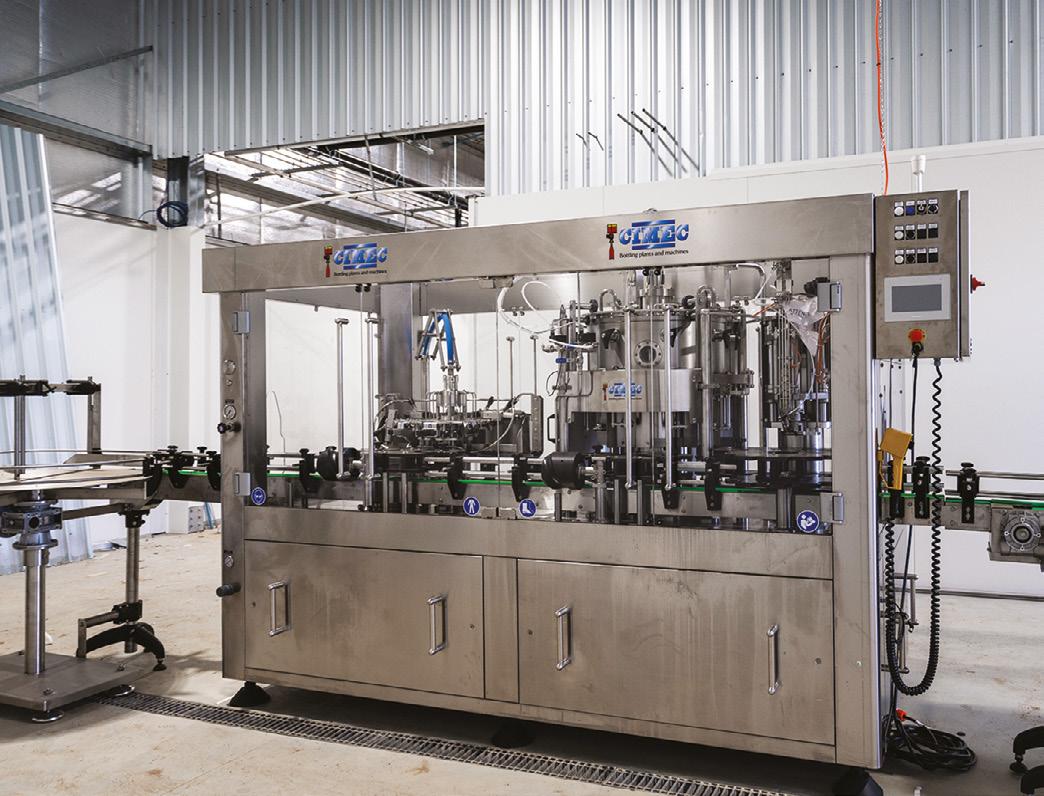
“I was very interested to see what was going on and I learnt a lot from my experiences. I was disheartened by the quality of cider back home and sick of watching waste fruit lying around or drying on the tree,” he says.
“It was often cheaper to leave fruit on the trees rather than sending it for processing and there was always a lot of wind damage.
“I wanted to find ways to value add to the orchard and produce excellent cider, so on my return I started making trial batches in the Southern Highlands as a hobby which grew and developed into the brand The Apple Thief.”
Dave Purcell hopes that in bringing The Apple Thief business to Batlow, other businesses will be encouraged to invest in the region and boost tourism to the area, which was badly affected by bushfires in 2022.

Dave says the name and branding was inspired by all fruit growers’ experience that the finest fruit often sits right at the top of the tree where it ripens to perfection in the sun.
“It also means the local apple thieves – birds –can spot it from miles around, so in honour of these birds, who love our fruit as much as we do we adopted a cheeky, thieving bird as our mascot. Fortunately, there’s always enough fruit to share and to create our award-winning ciders,” Dave says.
“People seem to like the story behind The Apple Thief Cider and it’s pretty catchy branding.”
It has also prompted some great marketing lines such as “so good it’s criminal; steal a taste; no ordinary line-up and lift one at the bar.”
Dave says he owes a lot to his parents Louise and Lloyd Purcell, who farmed cattle and sheep and planted an orchard of stone fruits and apple trees and his late grandfather, who taught him so much about the apple industry.
In the early days, he used fruit from his family’s own orchards but as the demand increased, he purchased produce from friends and family, supporting local growers throughout the Batlow region.
“I wanted to find ways to value add to the orchard and produce excellent cider, so on my return I started making trial batches in the Southern Highlands as a hobby which grew and developed into the brand The Apple Thief.”
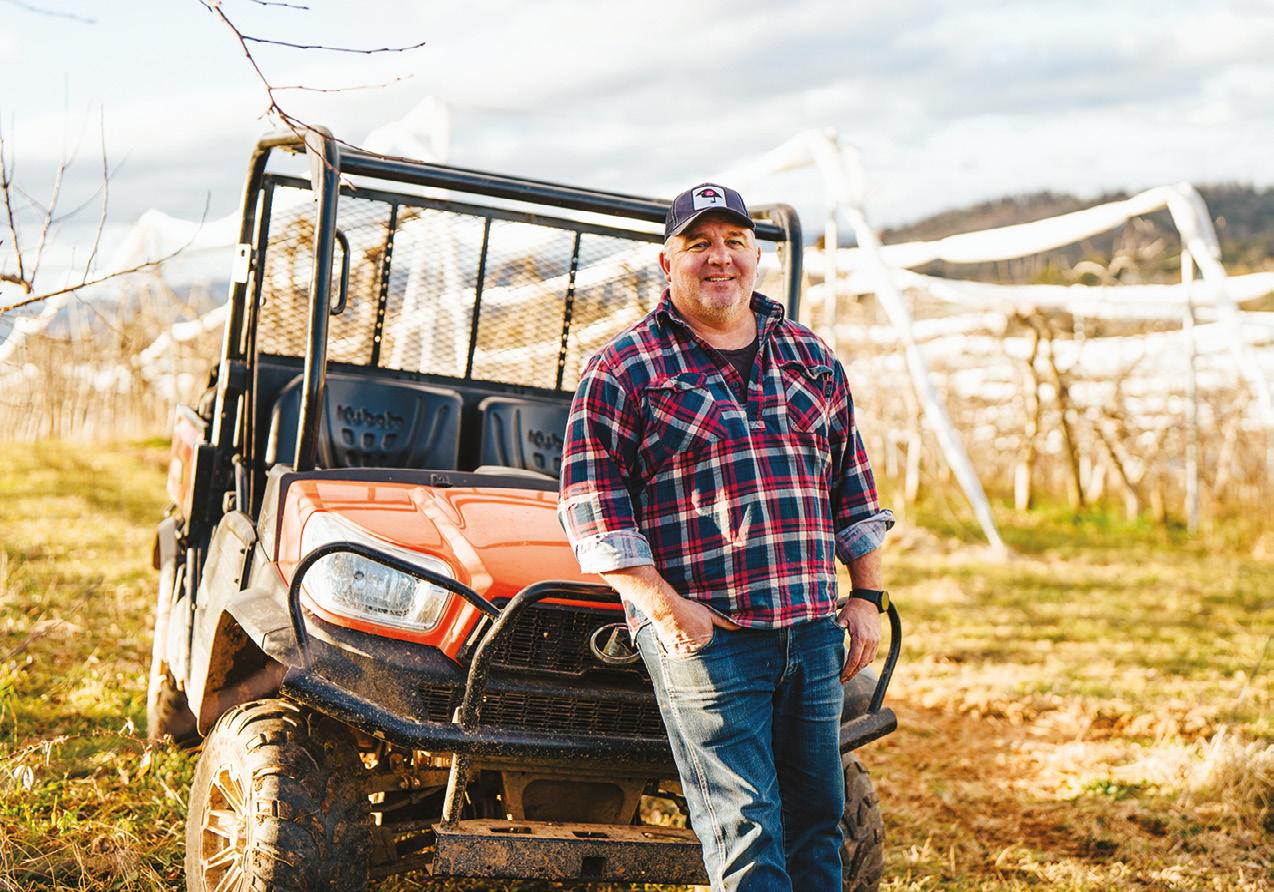

Dave (left) has won many awards for The Apple Thief Cider, including the Silver Medal for Branding at the World Cider Awards and several top awards at the Royal Easter Show in Sydney.
The move back to Batlow has also consolidated everything in one place for the business, while previously it was shipped to three different sites including Melbourne and Geelong for bottling and canning.
“We used to pay so much in freight as we weren’t centralised and this move means the fruit comes straight off the tree into production, reducing the carbon footprint and waste product,” he says.

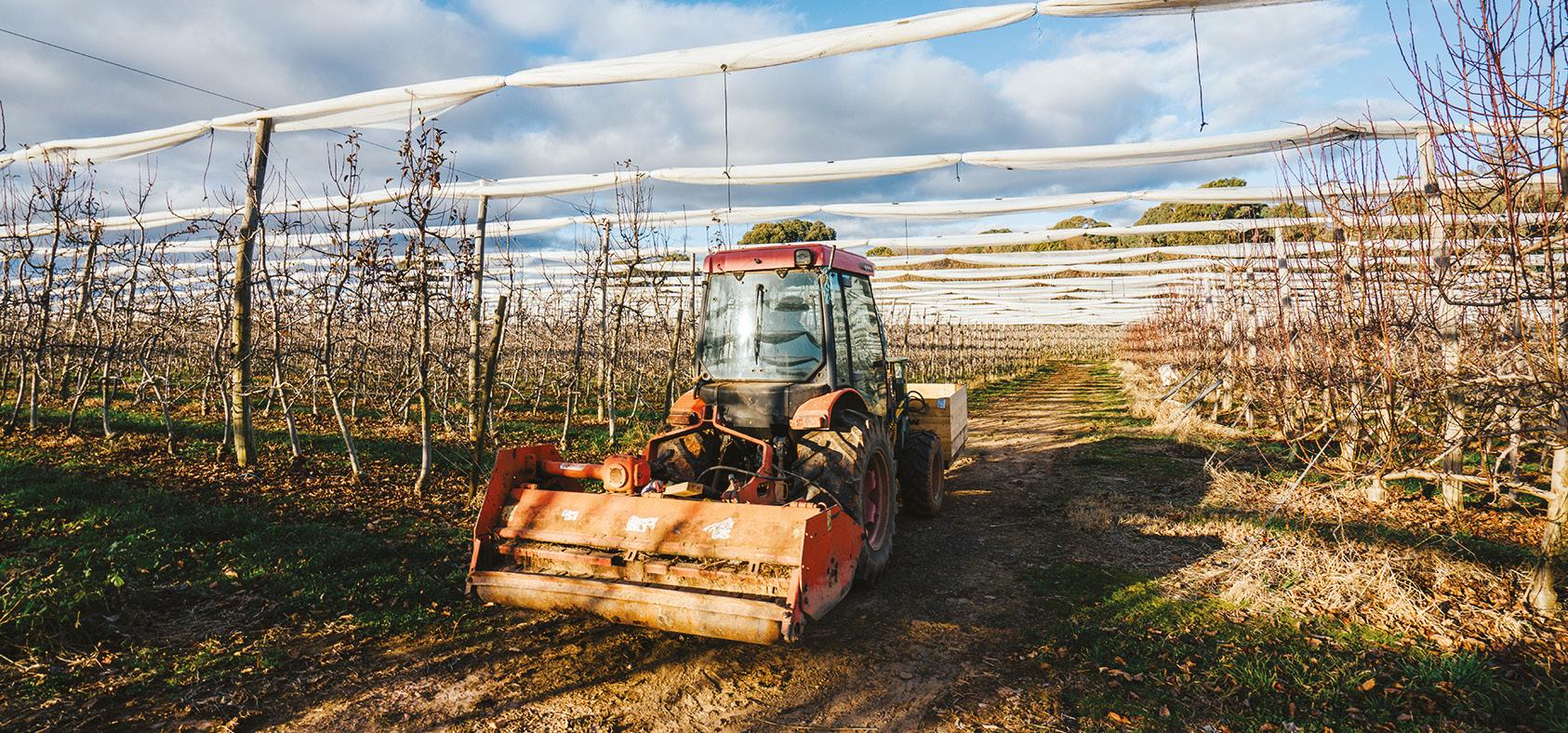
The Apple Thief Cider has won lots of awards including the Silver Medal for Branding at the World Cider Awards and several top awards at the Royal Easter Show in Sydney.
“Cider is going through a boom time and is in high demand and the non-alcoholic Pink Lady cider has a big following too,” Dave says.
“The cocktail and mocktail trends have seen the no-alcohol cider warmly welcomed by mixologists and bar owners.”
These days it’s not only red delicious apples grown in the Batlow region but new varieties and
Dave is looking forward to experimenting with cider production.
Apples have been a key part of Batlow’s economy and history for more than 120 years. With an elevation of around 800 metres above sea level, deep rich soils and generally consistent rainfall, the sub-alpine location and climate provides a sweet spot for growing the tastiest and juiciest apples around, according to Dave.
Hot days and cold nights produce crisp apples perfect for premium juice and cider and that’s what Dave believes sets his cider apart from other brands.
Always optimistic, Dave says exciting times are ahead and he can’t wait for the new cidery to open.
“I’m on the hunt for old and rare apples that could be great for cider as well as the apples, there’s so much other good produce around the area, so who knows what we’ll be dreaming up,” says Dave.
But he always follows one rule when it comes to making his cider – don’t mess with it too much. It’s paid off. l
 BEST IN SHOW
BEST IN SHOW
At the start of 2019, Sri Lanka had proudly achieved upper-middle income status. Two million people had been pulled out of hunger since the end of the 26-year-long civil war and the economy was booming with healthy tourism, agricultural, apparel and textile sectors.
Today, Sri Lanka’s economy is in freefall and inflation is out of control. Food costs 80 per cent more than it did a year ago. Nine out of 10 Sri Lankan families are skipping meals, according to the UN World Food Program, and half a million people have sunk back into poverty.
It’s a long and sad story. It starts when terrorists set off a bomb in April 2019 in the capital Colombo, killing 290 people and kneecapping tourism, which until then had accounted for 12 per cent of the GDP and employed 400,000 people.
A few weeks later, disgraced former President Gotabaya Rajapaksa won a landslide election on the back of outrage over the attacks and a populist agenda that included the biggest tax cuts in Sri Lankan history, as well as grandiose promises to provide Sri Lankans with chemical-free food.
The tax cuts went ahead in the same year, forcing a government that was already billions of dollars in the red to borrow more money at higher and higher rates of interest. Then Covid-19 happened and Sri Lanka’s tourism industry, which had only started to recover from the 2019 terror attack, vanished.
Nevertheless, with all this upheaval going on, Rajapaksa announced a nationwide ban on the import and use of synthetic fertilisers and pesticides in April. Six weeks later it went into play despite research by Verité Research, a think tank in Colombo, that showed only 20 per cent of the nation’s two million farmers had access to suitable organic fertiliser alternatives and knew how to properly use them.

To understand the gravity of Rajapaksa’s decision, one first needs to understand the great transformative effect synthetic fertilisers have had on the world.
Until the early 1900s, nine out of 10 workers tilled the soil to survive. There was no other way. That all changed after German scientists figured out how to synthesise ammonia, the basis for synthetic fertiliser, from thin air.
Synthetic fertilisers helped send crop yields to the moon and gave birth to modern food systems. Hundreds of millions of workers shifted from farming to manufacturing and service industries that offered higher incomes and a better quality of life than farming. In turn, this mass urbanisation gave birth to the middle class and all its trappings, including things like modern food systems, universal education and healthcare.
But like the combustion engine, light bulb and other great transformative technologies, ammonia synthesis proved a double-edged sword. Manufacturing the chemical consumes 2 per cent of the world’s energy while its application accounts for 1.8 per cent of carbon dioxide emissions. >
In 2019, yields for tea, Sri Lanka’s richest and biggest export, fell by 18 per cent. This was the direct result of a 2019 ban on synthetic fertilisers which left farmers without accesss to, or knowledge of, organic alternatives.

But the cost of suddenly banning synthetic fertilisers in a country dependent on them and replacing them entirely with organic manure is quite calculable. In an open letter to Rajapaksa dated June 30 and signed by 30 of Sri Lanka’s most prominent scientists and agronomical experts, they warned the move would reduce yields of crops bred for responsiveness to synthetic fertilisers to 50 per cent, down by 20 per cent. “There is special concern about the potential impact on rice and tea, one a staple food and the other a very important foreign exchange earner of the country,” the letter said.
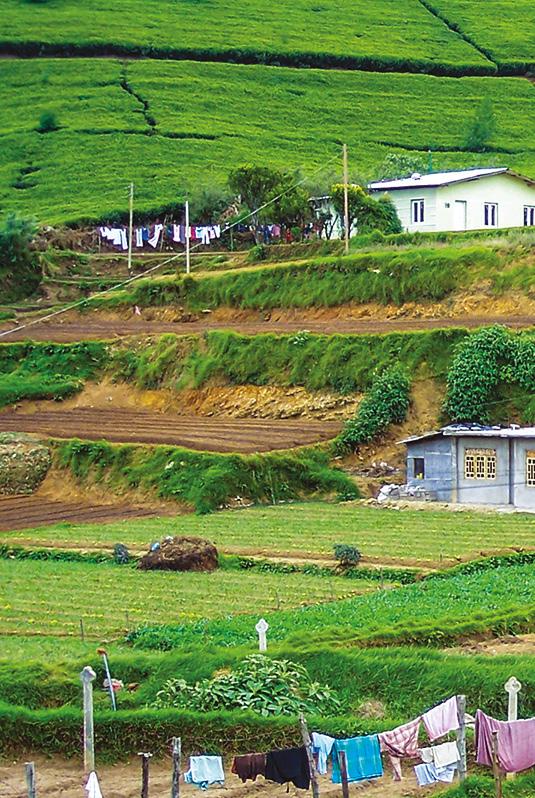
Data released by Sri Lanka’s Central Bank in October of last year showed those calculations were correct. Within six months, rice production dropped by 20 per cent. A one-time rice exporter, Sri Lanka suddenly had to find half a billion dollars to import rice every year. Yields for tea, Sri Lanka’s biggest and richest export, fell 18 per cent, an annual loss of another half a billion dollars.


Sri Lanka is a country whose name is synonymous with tea growers. Tea was the island’s biggest export in 2019, bringing in more than $1.5 billion per year in foreign currency.

There were tens of thousands of tea growers but only one was organically certified: Hethersett Estate, a 10-hectare property set in the country’s lush southern highlands that has produced “tea of the finest pedigree” since 1873. The estate also has an old-fashioned luxury hotel, the Heritage Tea Factory, where wealthy tourists pay to spend an hour or so picking tea in beautiful green rolling hills before retiring to a drawing room with period furniture to sip tea and eat cucumber sandwiches. Even now, in the worst economic downturn in the country’s history, Hethersett Estate is in the black. Its longevity shows how organic farming can work – but only as a niche within a larger agrochemical food system.
Globally, organic farming plays a significant role in two key agricultural niches that lie at opposite ends of the world’s economy.
Organic farming plays a significant role in two polar opposite agricultural niches. The first is the 700 million subsistence farmers who rely on organic fertilisers, while the second is affluent customers whose consumption of organic products is an expensive lifestyle choice.
The first are the 700 million-odd subsistence farmers who use organic fertilisers and kitchen waste simply because they can’t afford or get access to synthetic fertilisers.
The second and growing market includes more affluent consumers of organically certified produce as a lifestyle choice tied up with information about its health and environmental benefits.
The size of the global organic food market was valued at USD 178.4 billion in 2021 and is expected to be worth around USD 497.3 billion by 2030.
The Australian organic food industry is also on the rise. According to the Australian Organic Market Report 2021, that estimated the retail value of the organic market to be at least $2.3 billion. Australia has seen a compound annual growth rate of 13 per cent since 2012, with the number of certified organic operations increasing by 38 per cent since 2011.
Consumer demand for organic food is growing at a rate of 20 to 30 per cent per year. It is estimated that more than 6 out of every 10 Australian households now buy organic foods on occasion. Popular products include fruit and vegetables, beef, non-alcoholic drinks, nuts and ready-to-eat foods.
“Sri Lanka is a country whose name is synonymous with tea growers. Tea was the island’s biggest export in 2019, bringing in more than $1.5 billion per year in foreign currency.”
The Verité Research survey found that 64 per cent of Sri Lankan farmers supported a transition to organic farming. But they expected government support to ease the effects of the switch for at least two years, and they never expected a ban on synthetic fertilisers would be applied with only six weeks’ notice. During the 2019 electoral campaign, Rajapaksa spoke of phasing out synthetic fertilisers incrementally over 10 years.
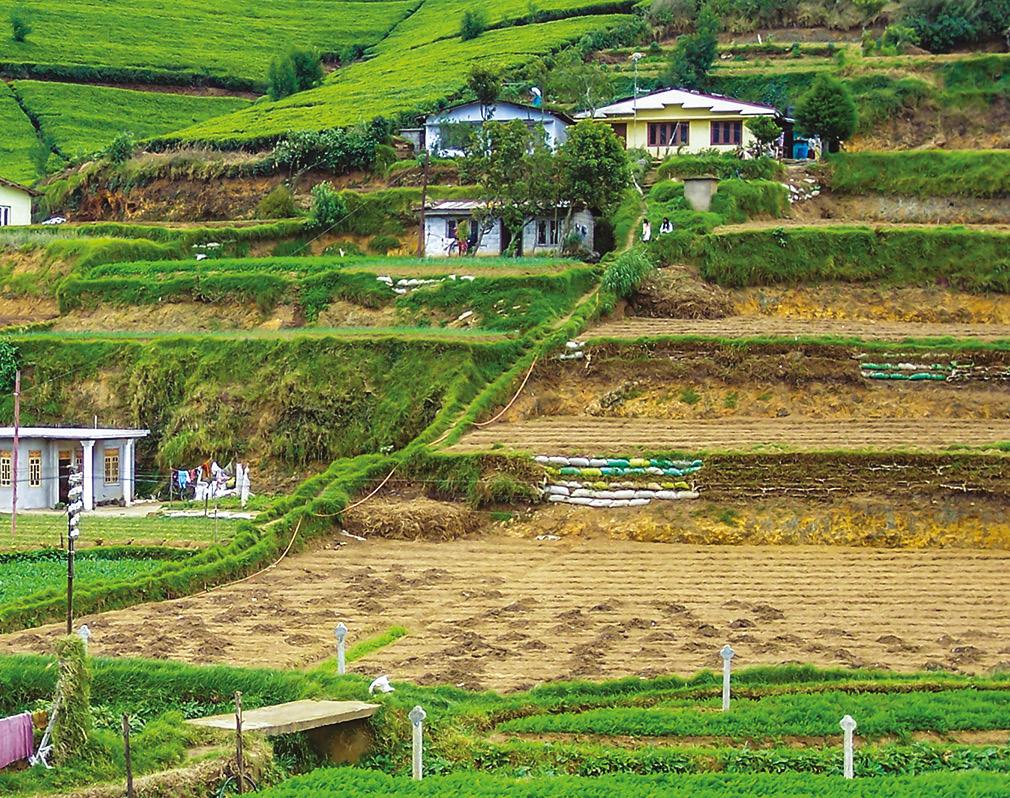
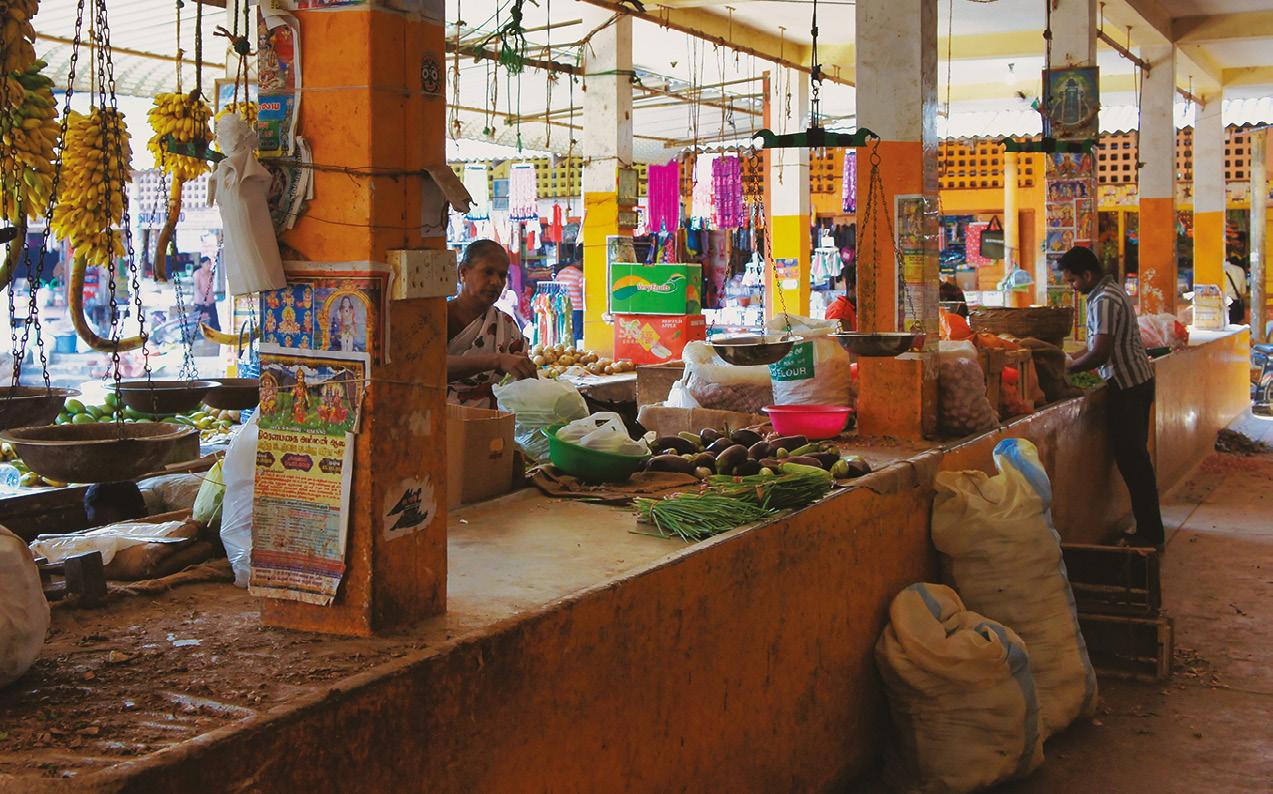
So why did the former president rush the ban through? Critics say it was to help patch holes in the budget he had created through his lavish tax cuts with the half a billion dollars the government was spending on subsidies for synthetic fertilisers.
By July, Sri Lankans had had enough of Rajapaksa. They stormed his mansion, forcing him to flee to Singapore. A human rights group is trying to have him arrested now for economic mismanagement and war crimes linked to the Sri Lankan civil war that ended in 2009. The former charges are more relevant but the latter have more teeth and could be Rajapaksa’s final undoing.
A new government has been named and is working
In July, fed up Sri Lankans stormed the president’s mansion, forcing him to flee. A new government is now working to clean up the mess left behind, which importantly includes reversing the ban on synthetic fertilisers. But it will a long, slow road to economic recovery.

to clean up the mess that’s been left behind. India has extended a line of credit of $75 million so the country can start buying synthetic fertilisers again. Farmers are receiving small cash handouts to compensate them for their losses last year. Soldiers have been gangpressed to work on farms and government employees now have four extra days off per year to grow their own food at home. Every little bit will help. But with a mess this big, Sri Lanka is going to need a long time to recover. l

“The size of the global organic food market was valued at USD 178.4 billion in 2021 and is expected to be worth around USD 497.3 billion by 2030.”
First Nations people have understood the value of Australian tea tree oil for thousands of years. Our Diggers used it to treat their wounds and infections during World War II. Now, producers work to share its anti-microbial, anti-fungal and anti-inflammatory properties with the world. –
 Words BEVERLEY HADGRAFT
Words BEVERLEY HADGRAFT
Northern NSW is home to 140 producers of pure Australian tea tree oil, such as NSW Farmers member Claude Cassegrain (above) and Phil Prather (right), the President of the Australian Tea Tree Industry Association. (Photo on opening page, and above left, by Gethin Coles)

The coastal littoral zone of northern NSW is some of the most beautiful country in the world. It’s also home to most of the 140 producers of pure Australian tea tree oil.
Between them they distil around 1,000 metric tonnes per year from their 5,000 hectares. Small and niche they may be, but they’re also amongst the most proactive farmers in Australia – with good reason.
“If you get into this industry, you have to be prepared to invest,” says Phil Prather, President of the Australian Tea Tree Industry Association (ATTIA).
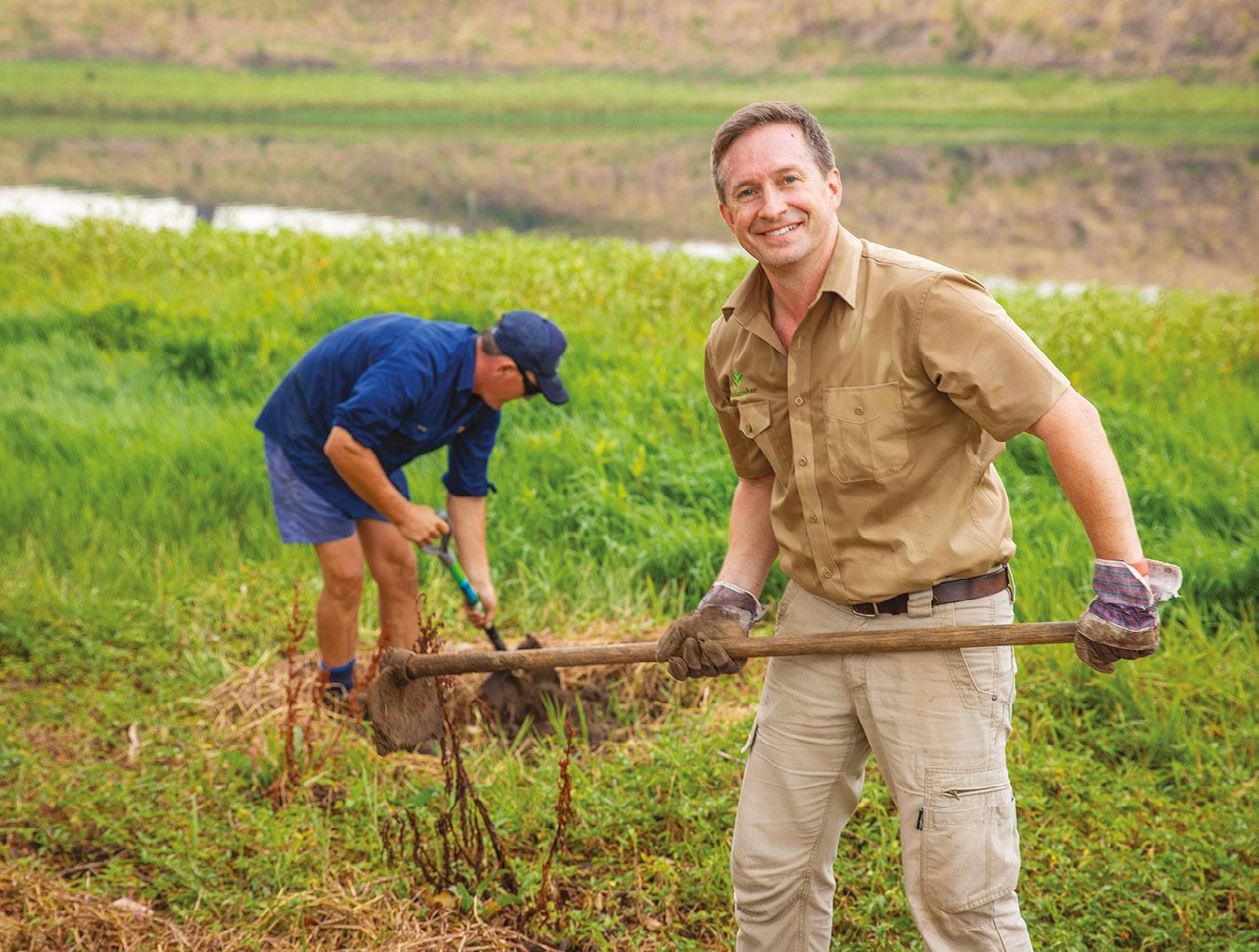
Since 2009, members have, via a voluntary levy, invested in research, marketing and quality control initiatives with one of their first concerns to deal with imposters. That’s important because, at best, adulterated or fake products will prove ineffective. At worst, they could injure people.
ATTIA’s first response was to introduce a quality control (QC) program and logo, a bit like the Woolmark.
“No other essential oil in the world has its own QC program,” says Phil. “It governs every aspect of production including seed selection, land development, harvesting, distillation, packaging and the documentation that ensures growers can answer any quality issues down the track.”
ATTIA even goes as far as buying ‘tea tree oil’ off shelves all over the world and bringing it back to Southern Cross University for testing. Much of it isn’t even tea tree at all – it’s pine or eucalyptus.
ATTIA needs to stay on top of that because pure and genuine tea tree has unique anti-microbial, antifungal, anti-inflammatory properties which make it quasi-medical. Indeed, it if wasn’t for the challenges
of how regulatory bodies work, it would be wellqualified as a medical product.
The problem is that these regulatory bodies like one active ingredient, one function and one result. Tea tree is a natural composition of at least 149 compounds.
Mind you, that hasn’t stopped others producing poor research – another expense for ATTIA which then has to debunk it, a recent example being the claim that it caused endocrine disruption.
Members are constantly updated on findings with research databases and newsletters but it must be frustrating to have time and money sucked out of positive research projects such as the indications that tea tree may have a role in treating non-melanoma skin cancers, herpes simplex and scabies.
It was even tricky to promote its anti-viral properties in the fight against Covid-19. Everyone knew the bench wipes and hand washes worked well and there’s a gel-based formulation that slowly disperses tea tree into the air.
“You don’t really smell it, but it cleanses the room and studies from Griffith University found it highly effective against viruses,” says Phil.
“However, as soon as you say you’re killing something, it becomes a biocide or anti-microbial and that’s when the regulatory authorities want to get involved.”
It sounds very difficult, and the recent floods haven’t helped. Tea tree plants love water but not that much. Why do the tea tree producers persist?
“It’s a fantastic industry. We love it,” says Phil. “My background is in medical devices. I’ve got a familiarity with medical information and regulatory bodies and we will get there. We just have to ensure we put all the right pieces in place.”
Claude Cassegrain, is the founder of Cassegrain Tea Tree Oil (CaTTO) near Port Macquarie owned by his children.
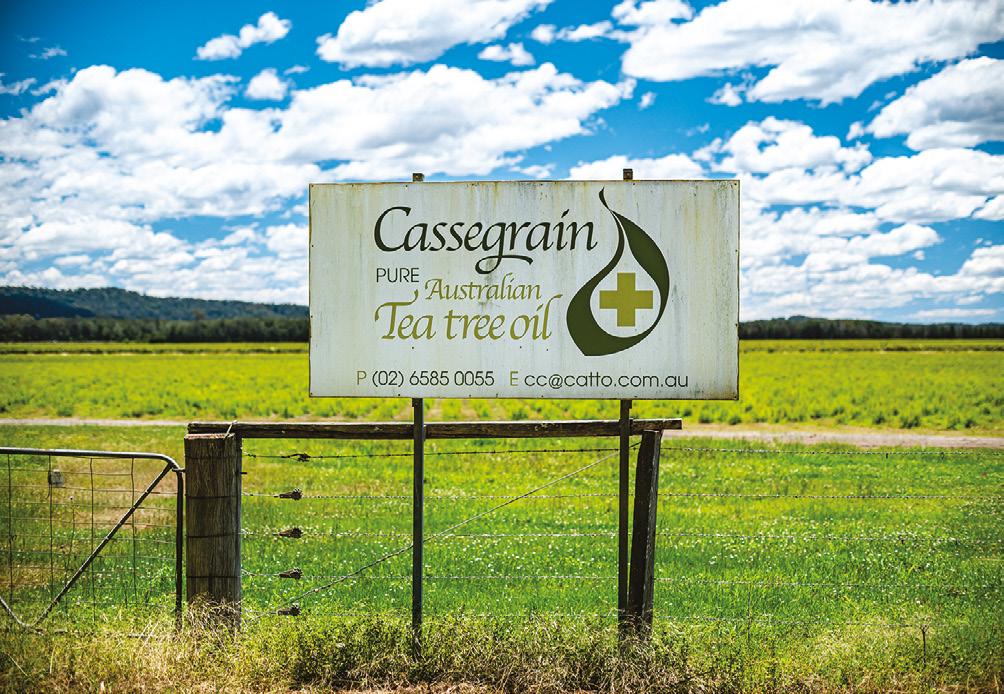
“I originally purchased this property for the Mid North Coast Councils to build a regional airport. When that proposal was abandoned in 1993, I had to find an alternative use for the property,” Claude says.
“It had Melaleuca alternifolia tea trees growing in the wild and I’d been allowing bush harvesters to continue harvesting the naturally growing trees. Having been exposed to tea tree oil, I decided to develop a tea tree plantation on the 630 hectare property.
“Fourteen million trees were planted on 400 ha and we have a land bank of 200 hectares to be developed as the market needs dictate.
“In 2000, we opened a distillery but found the market and price for tea tree oil had collapsed. I believe this was caused by a number of factors including an oversupply and tea tree oil being made available without proper labelling and instructions.
“This resulted in some instances of consumer protection intervention, specifically in Germany – then our largest export market for tea tree oil.
“We mothballed our plantation but, in a way, this was a good thing as it encouraged me and other growers to get behind the Australian Tea Tree Industry Association to introduce quality assurance, sustainable farming practises, traceability and a Code of Practise.

Clockwise from top left: Phil and Dee-Ann Prather from Down Under Enterprises; The team at Cassegrain Kalara tea plantation (Image: Gethin Coles); the Cassegrain plantation is 630 hectares with 14,000,000 trees. (Image: Gethin Coles.)
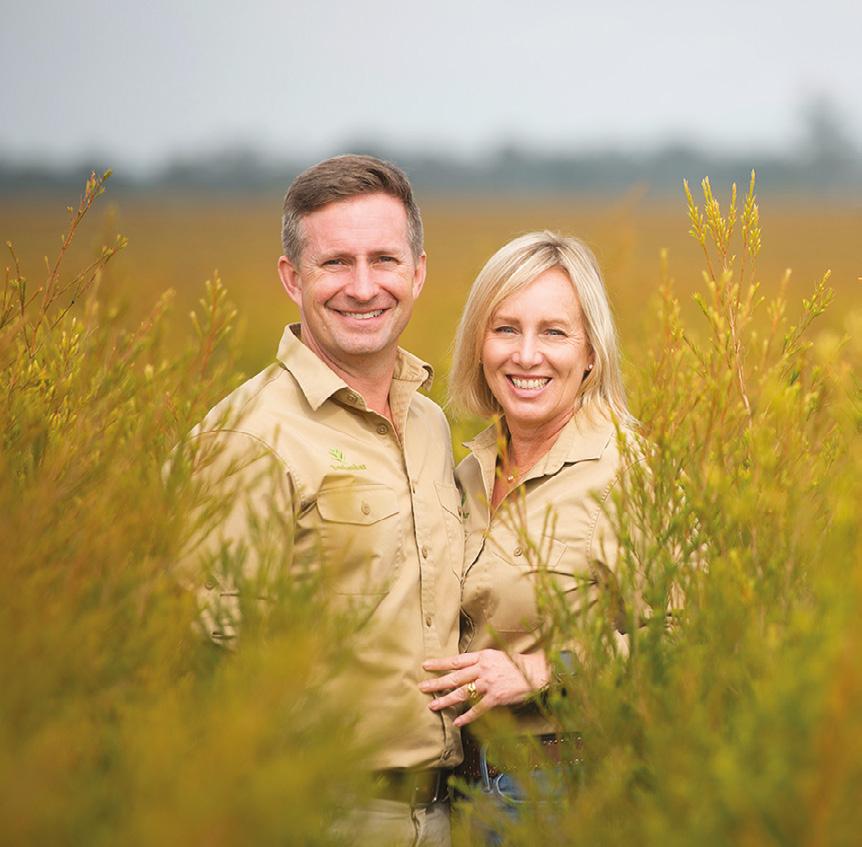
“We still have a lot to do but we’ve evolved from a cottage industry to one conforming to the highest standards required by the cosmetic, wellness and pharmaceutical consumer product industries.
“With the assistance of AusTrade, CaTTO now has a loyal base of customers and exports to countries around the globe including North and South America, the EU, Asia and the Middle East.
“Our annual record was distilling 120,000 kilos. We’re the most southern plantation in Australia and record every batch we distil – where it came from, time of harvest and cook so we have traceability and good quality control.
“We have a few projects underway to improve that quality further, including a high quality seedling trial on our plantation under the supervision of Dr Mervyn Shepherd from Southern Cross University.”
Morgan Dowsett owns Kimulli Plantation near Woodburn.
PHIL“My parents Stephen and Adele bought this tea tree farm in 1995, and at the time, it looked like a tremendous opportunity,” he says. “Prices were sky high at $80 a kilo, but five years later they crashed to around $8 a kilo.”
“At present we produce north of 30 tons of oil a year, but also market on behalf of local growers so in excess of 120 tons globally to customers around the world, usually on a repeat business under contract.”
–
PRATHER President of the Australian Tea Tree Industry Association
Morgan was living overseas back then, working in theatres all over the world, but he ended up back on the farm when his father died suddenly in 2018.
“Mum had breast cancer at the time and they’d both put so much effort into it, I promised her I’d keep the place going,” he says.
“I knew little about farming, but I got in touch with my Dad’s contacts, including Peter Entwistle –the main agronomist for tea tree in Australia, and he guided me.”
Morgan had always enjoyed sciences and he soon realised why his father had given up an international career in commodities, to be a farmer and work with tea tree oil.
“I also realised I was walking in his shoes in a way that was a grieving process for me and really made me appreciate him,” Morgan says. “The more I got into it, the more I loved it too.”
When Morgan’s mother died in 2020, he and his sister Naomi took it over as a family business.
“We now want to take it to another level and create a name and brand behind the plantation,” he says. “To learn as much as I can, I’m now on the board of directors for ATTIA. One of the things I hope to do is organise a tea tree festival in nearby Coraki which used to be the capital of tea tree.”
The idea is to invite local plantations and people who sell tea tree oil products, so the two sides of the supply chain can build rapport and help marketing. “We can share our stories so they can explain how they source their tea trea and build up the notion of a terroir, as they do in wine,” Morgan explains.
“I helped establish the New York International Fringe Festival so setting up a festival in Coraki shouldn’t be too hard. It’s a uniquely Australian story and there’s a lot of interest in agritourism.
“I made a big jump in my life taking on this plantation but we’ve got 62.5 hectares planted now, producing around 10 tons of oil a year. I’ve learned to drive a tractor, spray, slash… I can do pretty much everything now. I should even have some free time to return to theatre work soon as well!”
Phil and Dee-Ann Prather operate Down Under Enterprises in the Northern Rivers.
“We’ve owned our farm since 2016 but my wife DeeAnn is a sixth-generation farmer and her family has been involved in tea tree farming for more than 25 years,” he says. “They were in horticulture before that. We came back to Australia from America to help them and loved the industry so much we bought our own place, now one of the most modern tea tree farms in the industry.”
The couple have over 5.5 kms of irrigation pipes around 18 inches in diameter on their farm, which means they can move a lot of water around quickly and remotely. Although it did get hit by floods, it’s designed so water will also flow off.
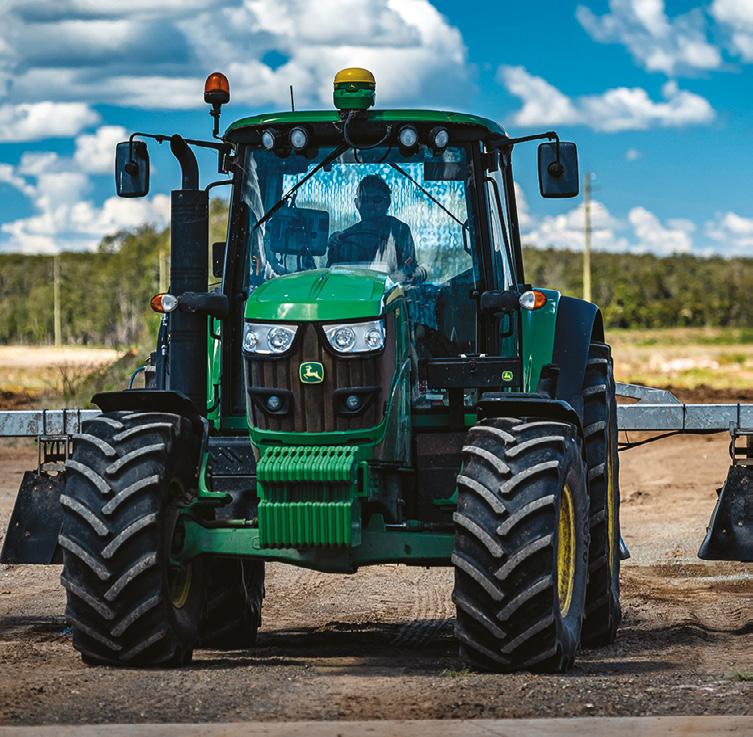
“At present we produce north of 30 tons of oil a year, but also market on behalf of local growers so in
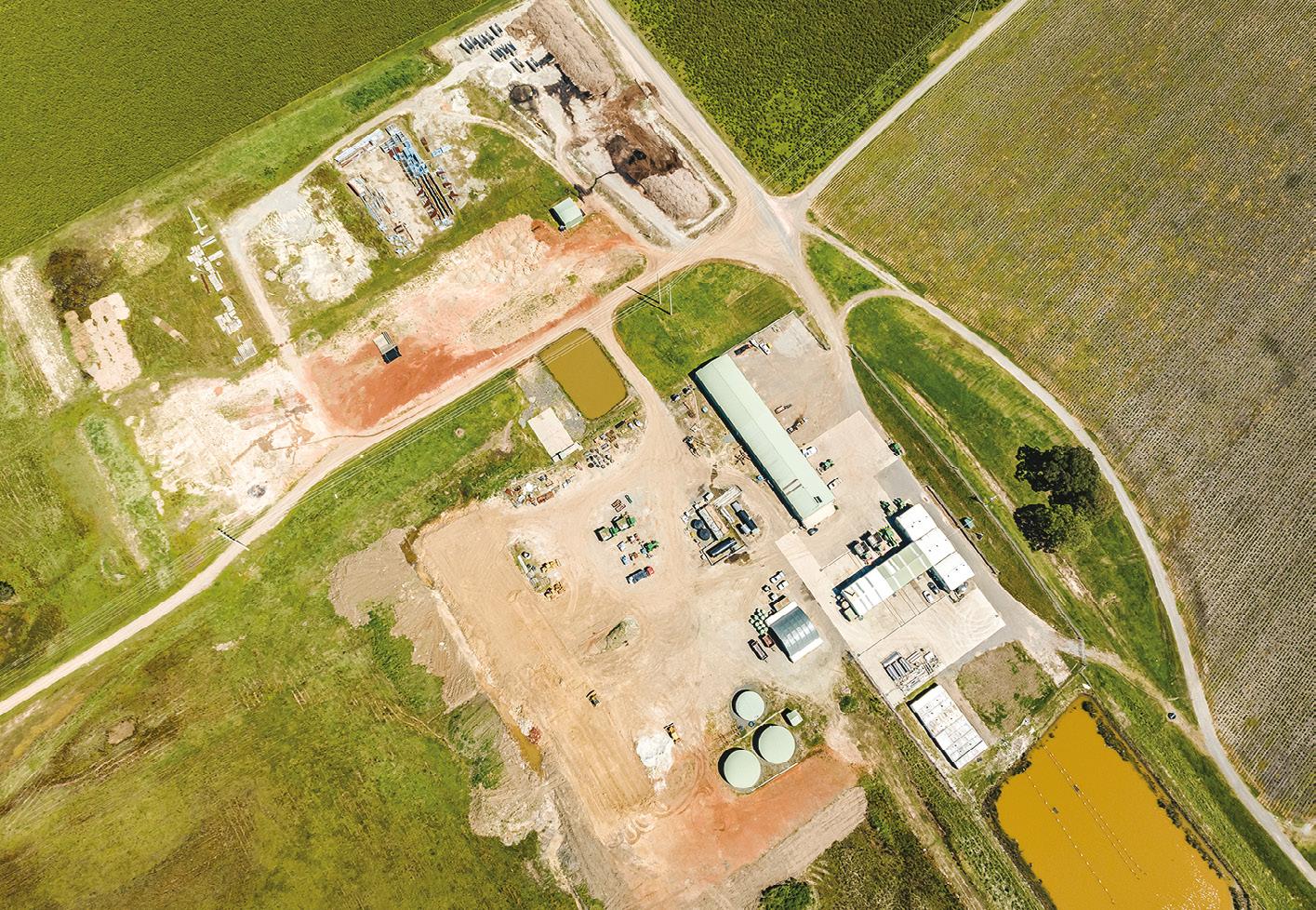
Below: Morgan Dowsett took over the family tea tree farm with his sister after the death of their father in 2018. Having previously worked in theatres and events, he aims to take the business to another level, as well as organise a tea tree festival in Coraki. At work on Cassegrain Kalara (Image: Gethin Coles, and Cassegrain Kalara from above (Image: Gethin Coles.)
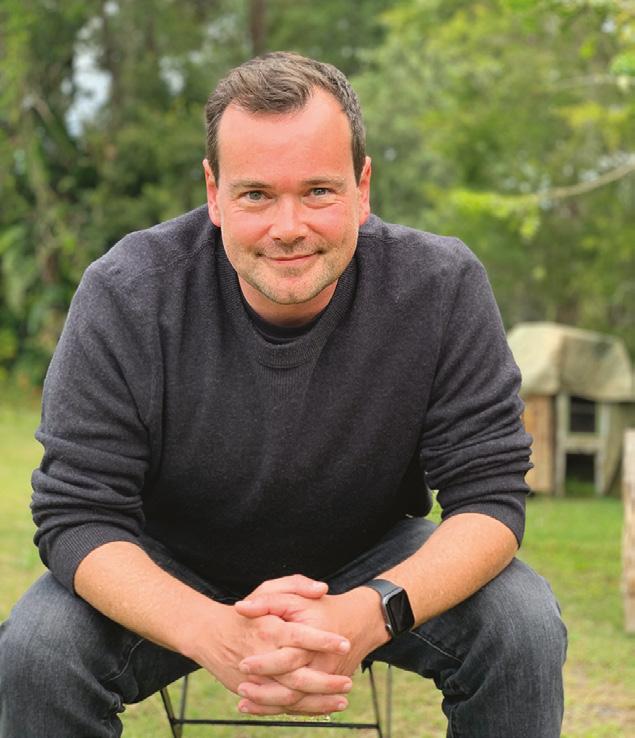
excess of 120 tons globally to customers around the world, usually on a repeat business under contract,” Phil explains.
“More recently we’ve branched into other Australian essential oils including lemon and lavender-scented tea tree as well as lemon and anise myrtle. They’re also anti-bacterial, anti-fungal and anti-inflammatory.
“As far as I am aware, what makes us unique is our intense focus on traceability and sustainability,” he says.
They’ve attained platinum status with EcoVardis – an independent sustainability auditor which puts them in the top one per cent of over 100,000 companies on that platform globally.
“Consumers are holding companies to account on their sustainability footprint,” Phil says. “Increasingly, manufacturers are putting focus on the provenance of their product ingredients. They are analysing their supply chain, making sure it is clean and sustainable. These types of customers, with shared values, are the ones we want to be working with” l
Strawberries and cream are just one part of the recipe for creating a viable small farm business at one of the few strawberry farms in NSW.
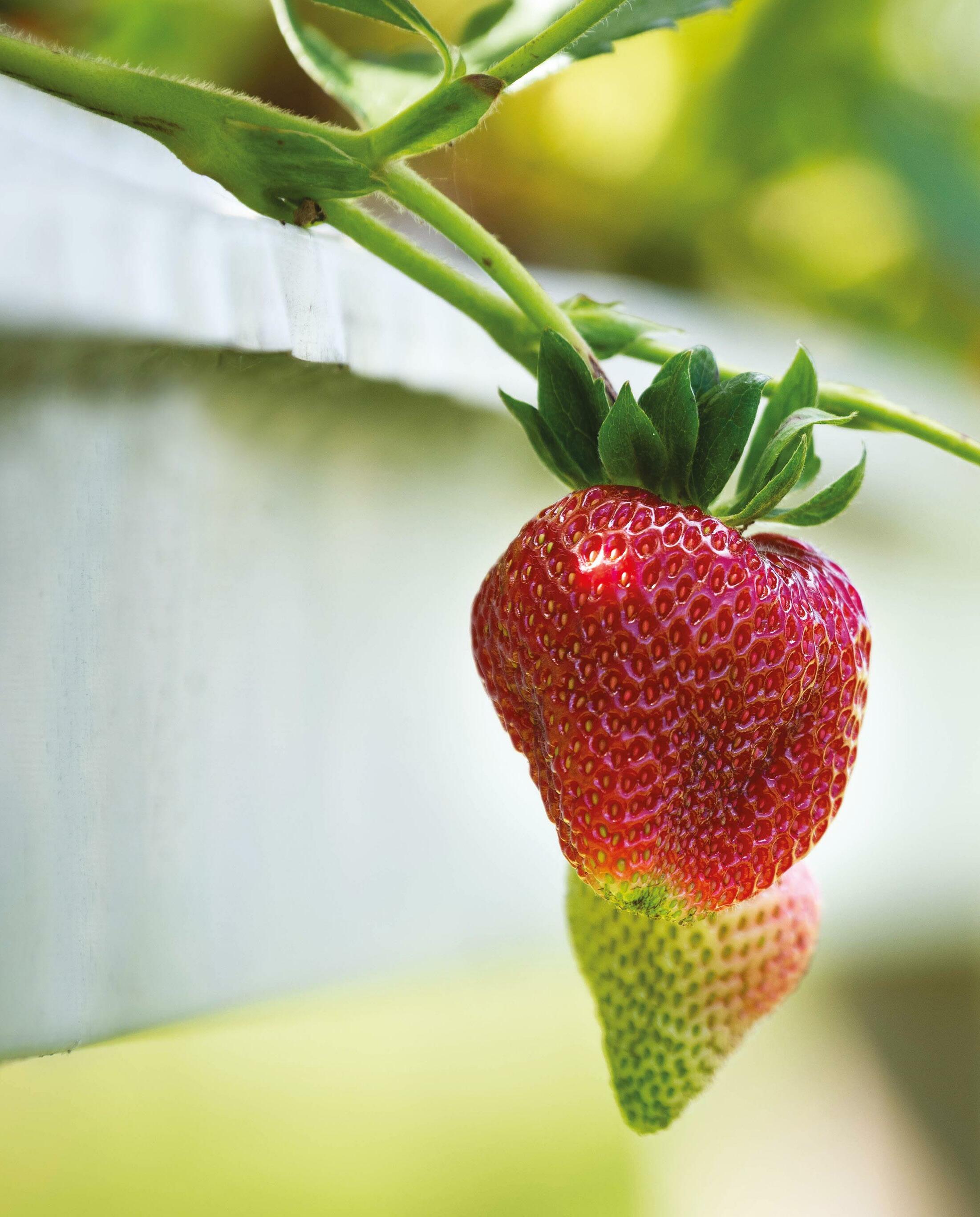
–
Words MICHAEL BURT Photography RACHAEL LENEHANMichael and Kylie Cashen (above) have grown Bidgee Strawberries and Cream into a diverse and thriving small business with 25,000 strawberry plants producing 25 tonnes of fruit each year.
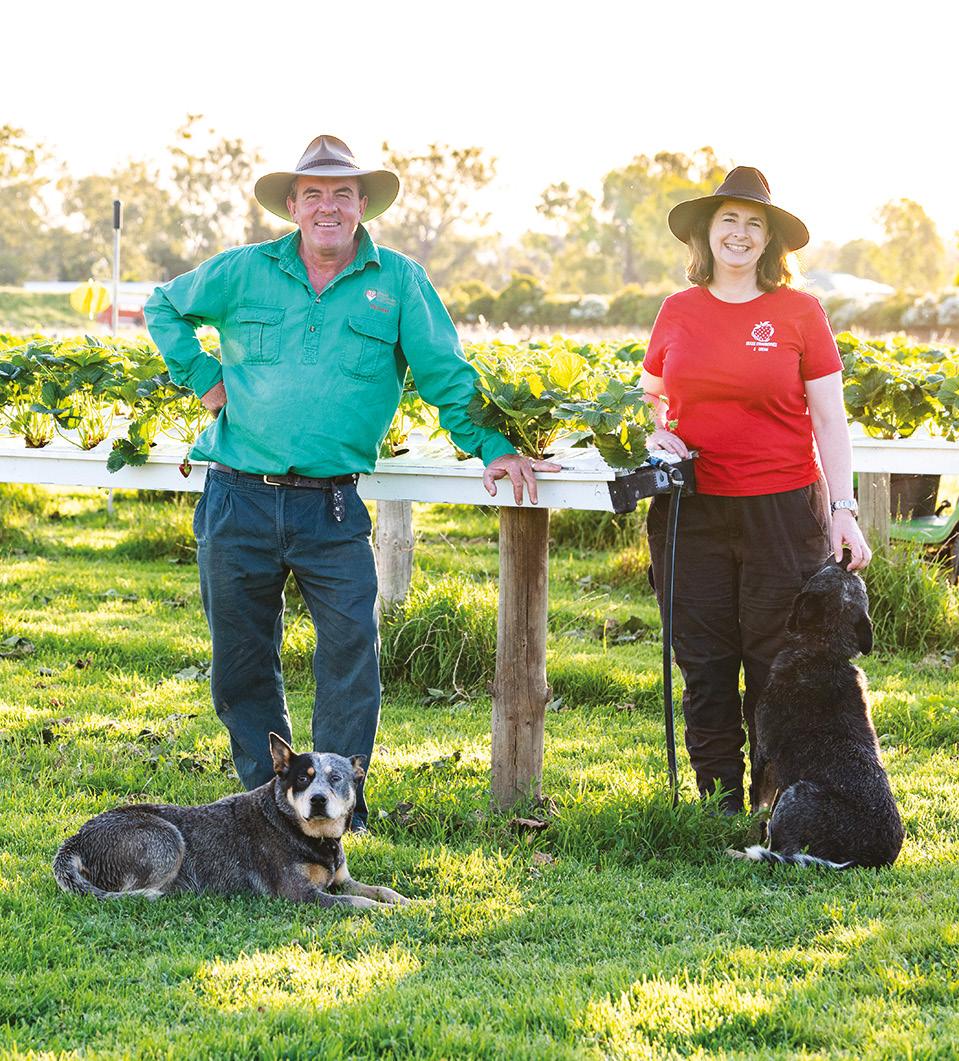
The sweet and succulent strawberry is a treat too great to resist for most Australians. Add some cream or melted chocolate and it’s near impossible to say no to this humble fruit. Its widespread popularity is one of the reasons why Michael and Kylie Cashen ventured into strawberry production on their 14-hectare farm on the outskirts of Wagga Wagga.
“Our small farm started about 10 years ago with a small herd of cattle that basically made enough money to pay the rates,” Michael says. “We started to plan how to get more value out of the land and take advantage of its close location to Wagga Wagga.
“We looked at all the different options and strawberries came out on top. You get a crop in your first year, it’s a reasonable return and it’s a crop that lends itself to value-adding.”
Growing strawberries also fitted Michael and Kylie’s skill set. The husband and wife met as students at
Hawkesbury Agricultural College where Michael was studying horticulture and Kylie was into food technology.
“Neither of us knew much about growing strawberries six years ago, but we quickly learned and knew the importance of enlisting an expert consultant to assist with plant nutrition and management,” Michael says.

“Kylie is the value-adder and has used the food technology skills to drive the diversification into ice cream, sorbets and other strawberrybased products.”
Michael and Kylie’s Bidgee Strawberries and Cream farm has since morphed into a diverse small business based on 25,000 strawberry plants producing around 25 tonnes of fruit between November and May each year.
Almost all the strawberries are sold on farm as fresh pre-picked, pickyour-own or used to make ice cream, sorbets, jams, pies and chocolate-coated strawberries. A small amount is sold to two gin distilleries and local cafés.
The humble strawberry has been a big success story for small farmers across the country, with its evergreen popularity and ability to value-add. The strawberries are grown in an outdoor hydroponic system using a fibrous coconut growing medium in long plastic troughs that sit about one metre above the ground.

“We started off selling the strawberries five years ago in a tent under a tree with a hired cool room. Then we bought a shipping container and a cooling unit, before building a shed to house it all,” Michael says.
“We started off selling them at $12 for a large punnet and have gradually increased that to $18 a punnet over five years for pre-picked strawberries. The pick-your-own experience costs $25.”
Michael and Kylie then took the brave step of opening a farm café in 2021 amid Covid restrictions.
“That enabled us to a lot more value-adding and provide a venue for coffee and milkshakes when the weather was not so good.
“We did not fair too badly during the whole Covid period because pick-your-own was one of the few activities that families could do.
“The customer base is largely young families and tourists, but more recently we have ventured into hosting events and activities like school visits.”
The Cashens recently became members of the
• 500g fresh strawberries
• 1/2 cup sugar (adjust to suit your preferred sweetness)
• 1/4 cup water
• 1/2 cup strawberry flavoured Greek yoghurt

• Rinse strawberries and remove the calyx (green bits on top)
• Place in a glass bowl
• Add sugar and water
• Microwave on high for two minutes and stir
• Cool for one minute
• Check the strawberries for softness. Cook for another one to two minutes if required
• Allow strawberries to cool
• Scoop half a cup of strawberry flavoured Greek yoghurt into a bowl
• Pour a tablespoon of strawberries and their juice on top. Enjoy!
NSW Farmers Wagga Wagga branch, enabling them to link up with the Kids To Farms project and host educational tours.
Michael says the addition of the café and the agritourism angle of hosting of functions and events is making the business more viable.
“The café has helped a lot in getting the average spend per customer increased. Our losses are getting less, and we can see a return in investment for the café. We now want to get the site to a stage where we can host more events and functions.”
The farm employs up to 10 casual staff per week during the harvest season and does benefit from its proximity to Wagga Wagga in terms of sourcing labour. Daughters Lawanna, 24, and Brooklyn, 21 are an integral part of the business, assisting with the café, business management and marketing.
“It is a labour-intensive crop and business, so that cost is one of the key challenges to the viability of the farm.”
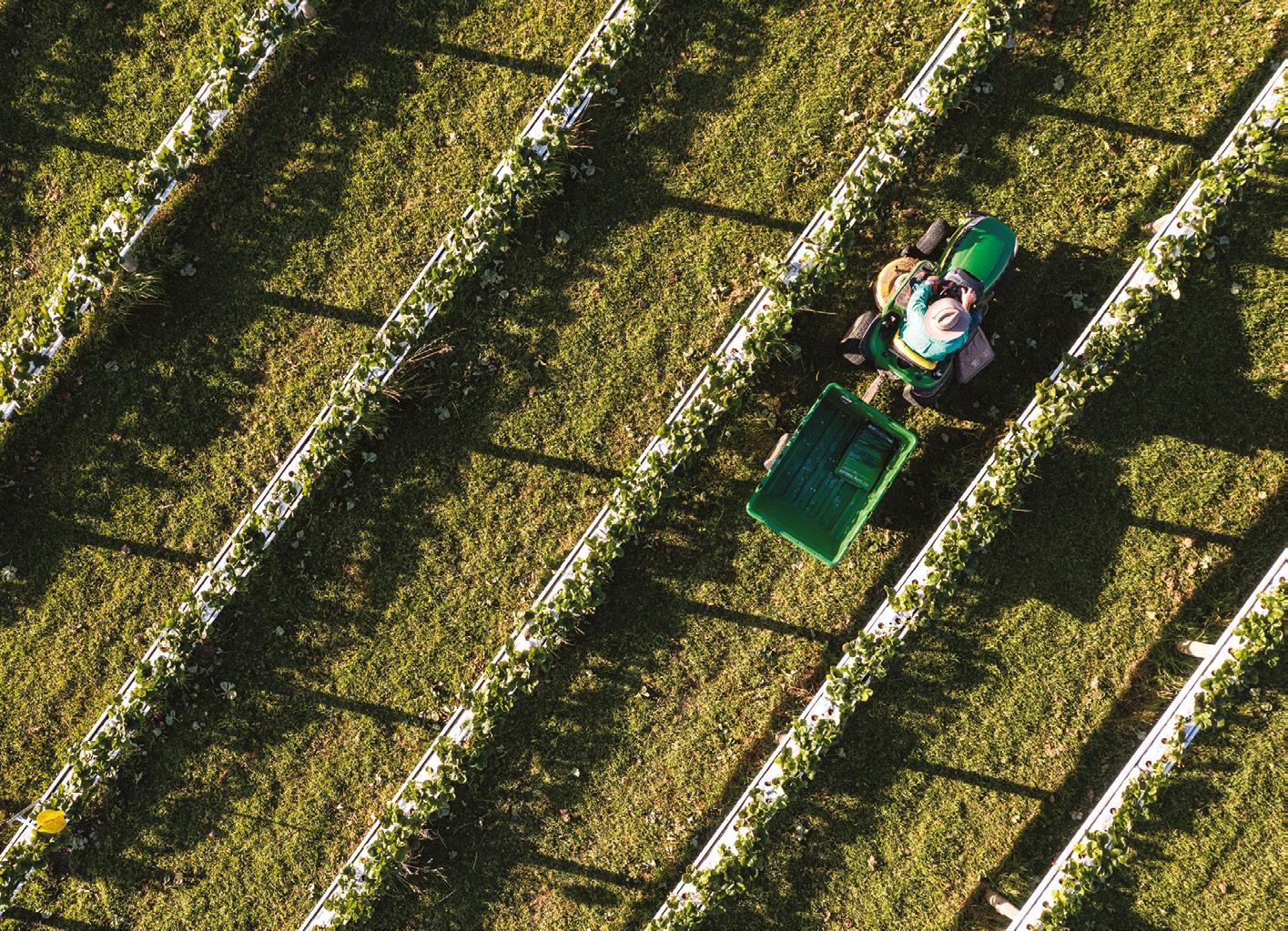
grant, can apply for a Rural Landholder Grant of up to $10,000.” The grant programs are intended to assist with the cost of clean-up and reinstatement of the farm business and can also have positive flow on effects for regional communities.
“While these programs provide direct financial relief for floodimpacted farmers, in turn, they can also help rural communities to not only survive, but thrive well into the future,” said Mr Budworth.
Producers and landholders in NSW communities impacted by the latest widespread flood events are encouraged to consider applying for financial assistance to support recovery. Chief Executive of the NSW Rural Assistance Authority (RAA), Darren Budworth said the NSW and Australian governments have jointly funded a range of programs, designed to assist producers on their recovery journey.
“Special Disaster Grants of up to $75,000 are now available to NSW producers, to help them get the farm business back in operation as quickly as possible,” said Mr Budworth.
“In addition, smaller-scale producers and landholders, including oyster farmers, who do not qualify for the primary producer
“By using grant funds on local trades, engaging local contractors for repair works and purchasing products from local suppliers, you’ll be supporting rural businesses, who can then go on to support events, sport teams and charities in the community.”
Producers and landholders who are unsure of which financial assistance programs they may be eligible for are encouraged to contact their local Rural Financial Counselling Service, the Department of Primary Industries’ Rural Recovery Support Service or the NSW RAA to speak with a recovery specialist.
Phone: 1800 678 593
Email: rural.assist@raa.nsw.gov.au
Primary producers may be eligible for a $25,000 up-front payment, with a further $50,000 available, with submission of valid tax invoices for the full $75,000 on offer.
This grant could assist you with costs associated with flood clean-up and getting your business back up and running. This may include:
• Immediate clean-up
• Repairs to infrastructure
• Replacing livestock (including oyster spat)
• Repair or replacement costs of agricultural equipment
Scan the QR code to check eligibility and apply.

For information on the Primary Producer Grant call 1800 678 593 For further support visit nsw.gov.au/floods
If you need an interpreter, please call 13 14 50 and ask them to contact us.
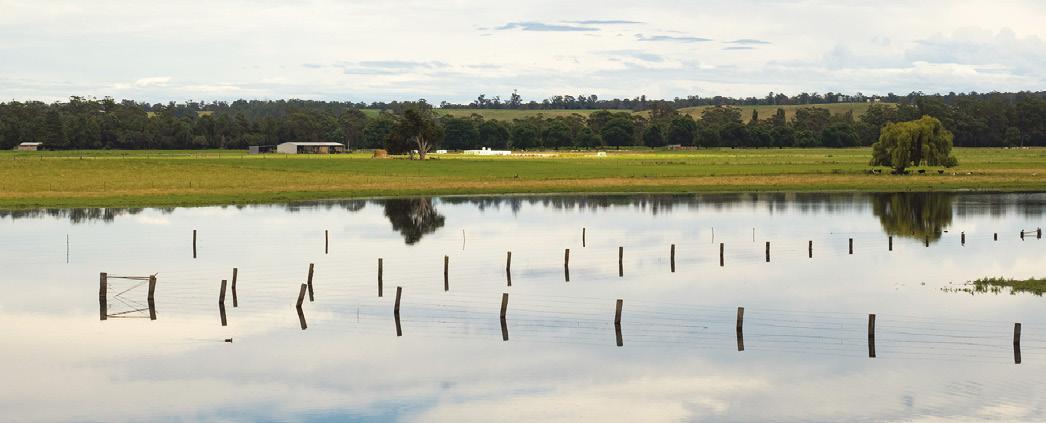
The strawberries are grown in an outdoor hydroponic system using a fibrous coconut growing medium in long plastic troughs that sit about one metre above the ground.

Above: Bidgee
Strawberries and Cream offers strawberries sold pre-picked on farm, as a pick-your-own experience, as well as products including ice cream, sorbets, jams, pies and choc-coated strawberries.
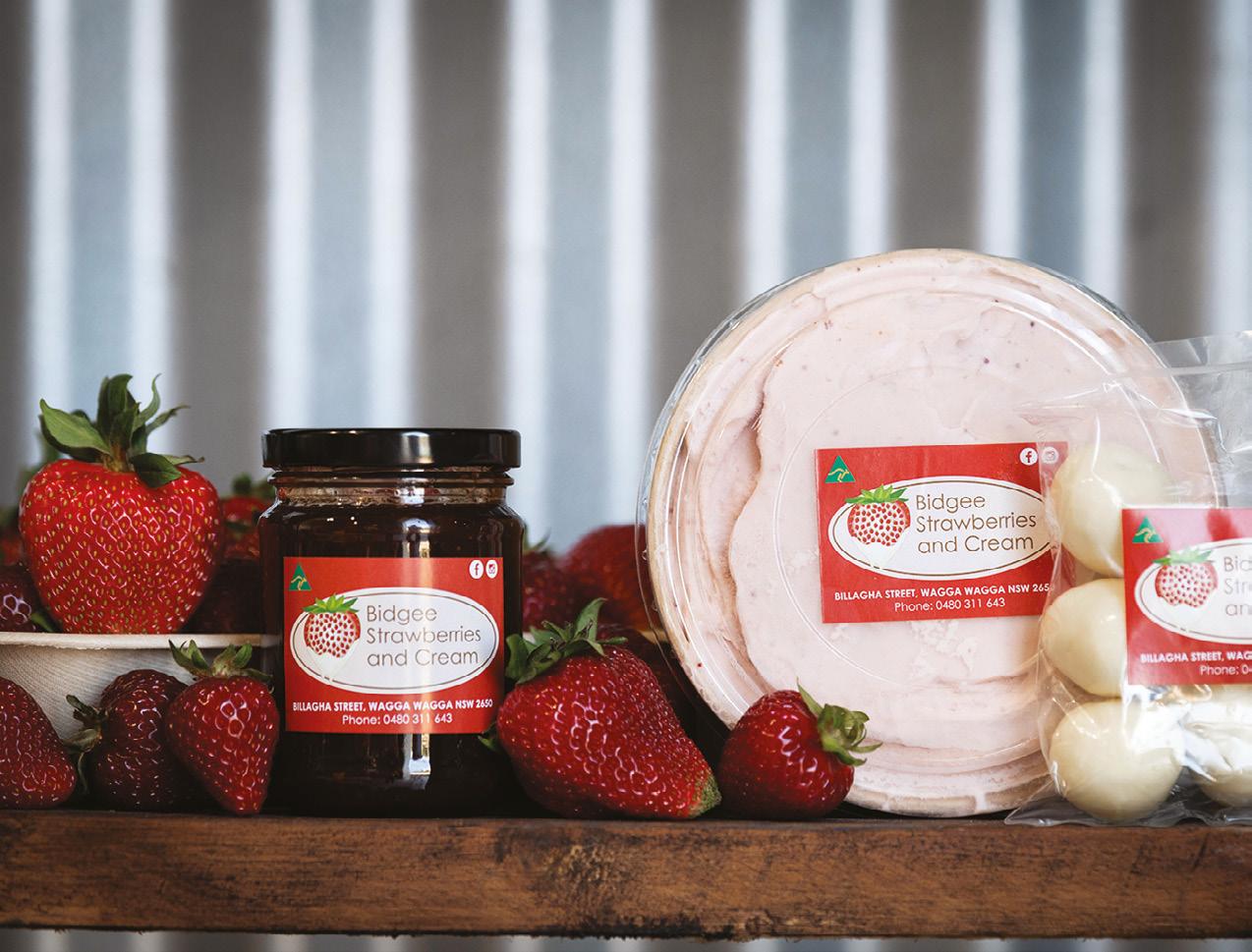
They drink town water and are fed a tailored fertiliser mix twice a day through a drip fertigation system. The plants, the growing medium and drip irrigation lines are all replaced every two years.

Michael said wastewater is collected in a concrete well and irrigated onto pastures for a flock of 110 Damara sheep.
“There is an opportunity to do more with the wastewater down the track. It can’t be reused on the strawberries due to disease issues, but it could be used to diversify into green leafy vegetables. I’ve actually been looking into rhubarb, because it goes with strawberries and can be value-added with things like pies.”

Growing their crop a metre above ground has also provided some immunity from the direct impact of recent major flooding in the nearby Murrumbidgee River. Michael said the long visit from La Niña has impacted yields, with high rainfall leading to some crop damage.

“We looked at all the different options and strawberries came out on top. You get a crop in your first year, it’s a reasonable return and it’s a crop that lends itself to value-adding.”
• The strawberry is not actually a berry at all, from a botanical point of view. Technically, it is an ‘aggregate accessory fruit’, meaning that the fleshy part is derived not from the plant’s ovaries but from the receptacle that holds the ovaries.
• It is one of more than 20 species of flowering plants belonging to the rose family (Rosaceae) that has edible fruit.
• NSW grows less than 1 per cent of Australia’s strawberry crop. Southern Queensland is the major growing region, producing almost 60 per cent of the nation’s crop between May and October.
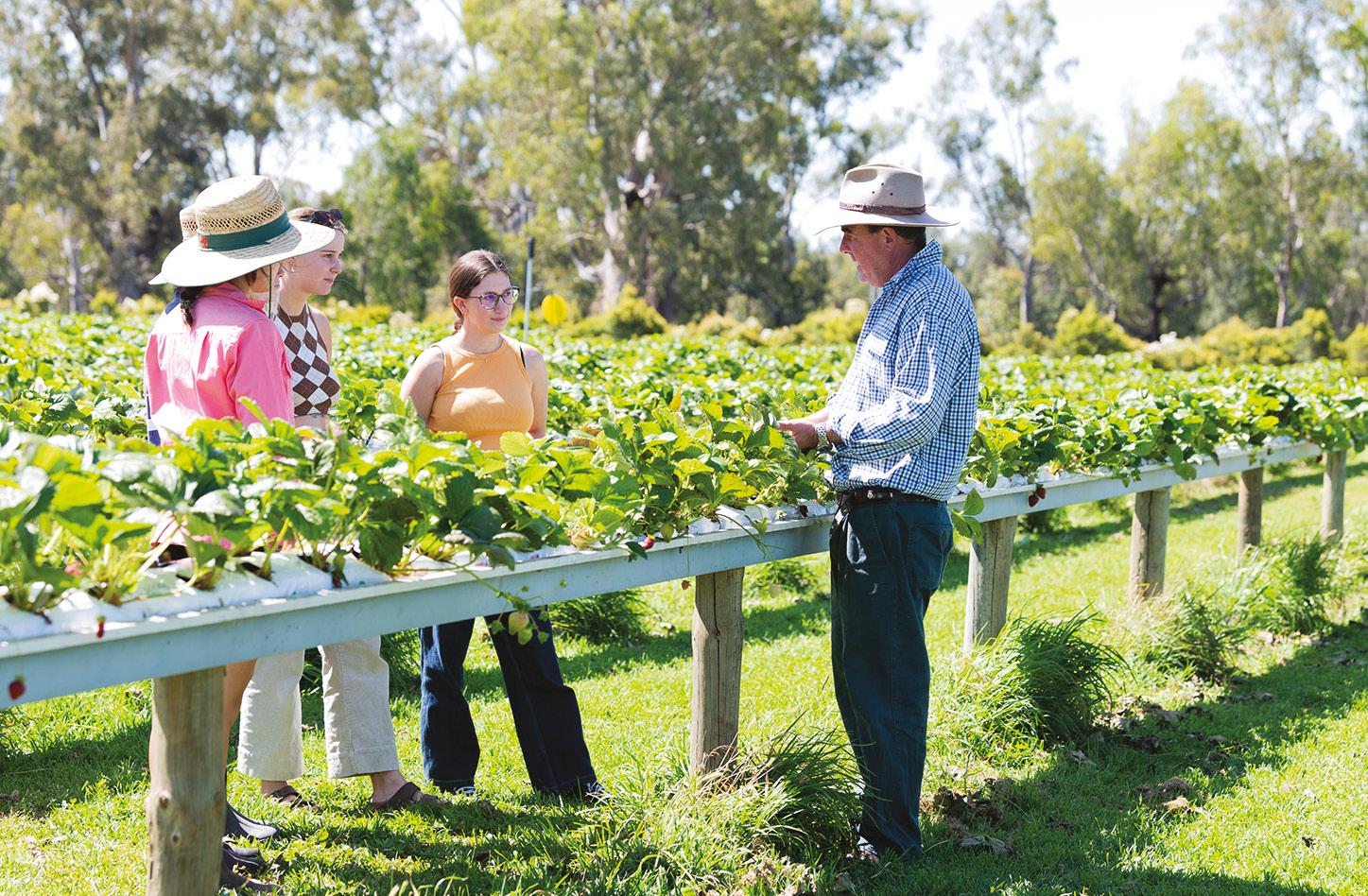
Above: Michael says the addition of the café and the agritourism angle of hosting functions and events is making the business more viable. They have also linked up with Kids to Farms to host educational opportunities as well.
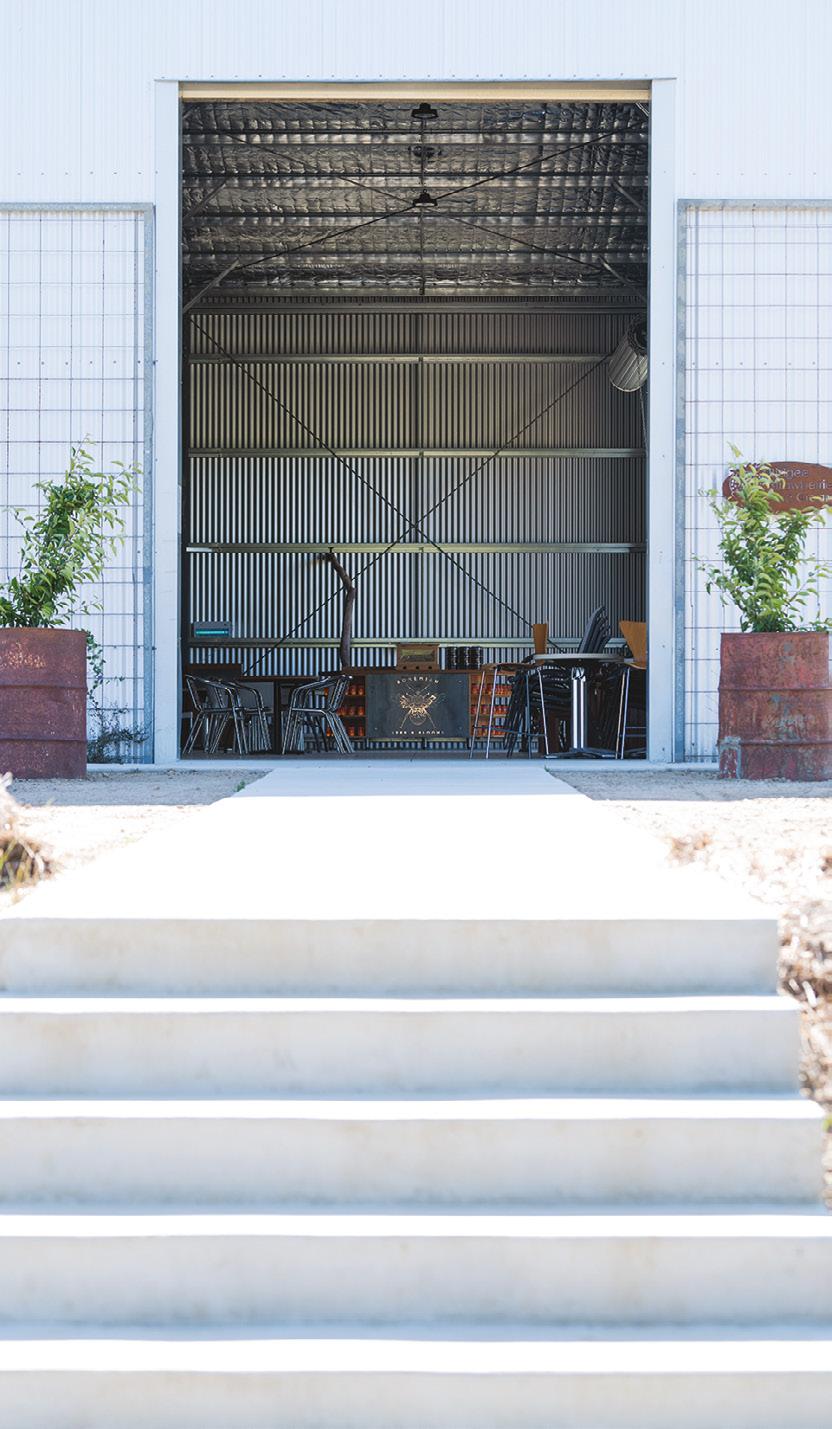

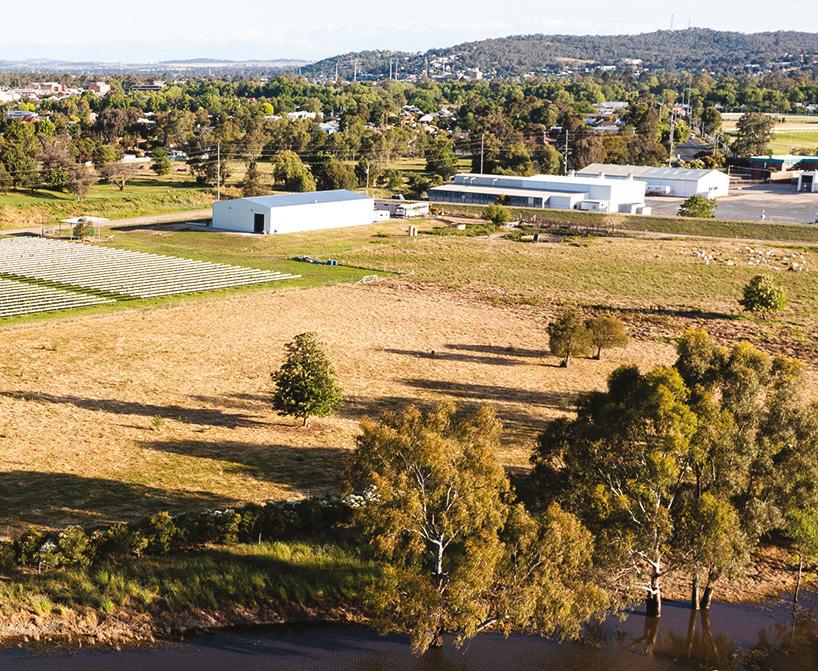
“The rainfall in the last three years has been pretty significant, which has led to a lot of washed-out fruit. We do try and capture most of that fruit for freezing to use in our value-added products.”
Wet summers have also led to an increase in pest insect pressure, which Michael keeps in check with Integrated Pest Management (IPM) system. Insect traps form a key part of Michael’s IPM plan, capturing male and female fruit fly and beetle pests and reducing the need for agrichemical sprays. l
An annual scholarship program assists with tuition and boarding costs, and is open to new and existing students seeking to join Scots All Saints College in 2024.

Feeding alpacas and cows, milking camels, harvesting peaches, planting vegetables, and keeping bees are all on the agenda when it comes to combining education and agriculture.
–
Words JEANETTE SEVERSThe Kids to Farms project, which is endorsed by NSW Farmers and funded through the federal government, enables students to spend anything from an hour or two to a whole day on a farm, learning about where their food comes from. The project builds on other initiatives – such as the Cows Create Careers project, that was established in 2004 and involves more than 1,500 students annually.
Dairy Australia’s Picasso Cows curriculum program for primary students aligns a school with a local dairy farmer and teaches children about their favourite dairy food. It has involved more than 1,000 schools since 2009.
These are just some examples of why the key for achieving $30 billion by value of agricultural production by 2030 is education. Agricultural education programs teach students how to be farmers, and trains tomorrow’s scientists, nutritionists, teachers, drone pilots, software developers, agronomists, and many others.
In NSW, education department figures reveal the number of students enrolling in HSC level agricultural electives has remained steady at around 1,500 students.





Agriculture is already embedded within compulsory food and technology subjects in years 7 and 8, and schools and teachers are also encouraged to come up with ways to integrate agriculture and food production into the food and technology subjects.
There are four specific agricultural schools in NSW, and approximately 300 government and non-government schools offering agriculture and VET primary industries elective subjects.
For many rural children growing up embedded within an agricultural environment, importance is placed upon learning about a wider world, and to help them do that, a number of schools offer scholarship programs. Here we look at some of them.
One of the biggest girls’ boarding schools in NSW is Loreto Normanhurst, and more than 85 per cent of the school’s boarders are from rural NSW. There are more than 190 boarders at the school in 2023, contributing

to a broad and rich culture of experiences and learning, fostering friendships for life among the student cohort.
Loreto Normanhurst’s Bursary and Scholarship program is focussed on enabling girls from rural and Indigenous backgrounds to access the school’s holistic curriculum.
Celebrating 125 years of excellence in education, the school is not resting on the laurels of past achievements, and instead, is looking to the future.
A 30-year masterplan includes a new purpose-built boarding school due to be opened in 2025. This will provide increased boarding accommodation to more than 200 students, flexible communal spaces, and reflect the school’s vision to create a modern, ecologically sustainable home for boarding students.
The boarding school is available for students needing full time and flexible boarding options. This includes catering for students participating in extra-curricular activities, who also live locally.
The school’s open day on March 4, 2023, is an opportunity for families to

tour the school and learn from existing students about their experiences at Loreto Normanhurst.
|loretonh.nsw.edu.au
The only co-educational boarding school in Bathurst, Scots All Saints College boasts a working farm for cattle and sheep, an equestrian centre, as well as full showjumping and cross-country courses.
The College Farm is set on about 40 hectares of the campus and hosts both Limousin and Australian White studs, livestock cross-breeding and finishing programs, and rotational cropping.
A unique feature of Scots All Saints College is the facility for boarding students to bring their horses to school during the term. The equestrian centre is close to the boarding houses, and students can choose between shared paddocks, large private yards, or a combination of paddock and yard.
The well-appointed boarding houses provide accommodation for students in years 7 to 12, enabling them to walk to class >





and participate in a variety of after-school tutorial and homework programs.
When students are participating in sporting fixtures and cultural events, the parent accommodation enables remotely located families from a distance to attend and enjoy their child’s involvement.
An annual scholarship program assists with tuition and boarding costs, and is open to new and existing students seeking to join Scots All Saints College in 2024.
Students are invited to apply for a number of scholarships – academic, all-rounder, agriculture and performing arts – music, dance and drama.
scotsallsaints.nsw.edu.au
A sense of belonging is crucial for positive wellbeing and learning for many people, and in particular adolescents. Wesley College’s boarding facility, Learning in Residence, provides an innovative and contemporary home for students in years 9 to 12.
The eight two-storey residences each house up to 16 students and one staff member. Small group tutorials and
individual learning assistance supports students to complete their homework and assignments, balanced against sport, performing arts, community service, debating and other co-curricular activities.
During the year there are numerous opportunities for creating positive connections between boarders, with initiatives including welcome letters from peers, community dinners, a gratitude box, student acknowledgements and weekly check-in conversations with mentors.
Student feedback, combined with staff input and resourcing, has led to the development of a variety of activities and events that anchor students to their cohort and community.
Wesley College’s boarding facility is situated within the school’s spacious Glen Waverley campus, and it offers weekly and full-time boarding – catering for the needs of students from afar and near. Students from metropolitan Melbourne, rural and regional Australia, and international locations, all benefit from staying at Wesley College’s boarding facility.
A leading co-educational open-entry
International Baccalaureate World School, Wesley College’s Senior School students have a choice of academic pathways –the Victorian Certificate of Education or the International Baccalaureate Diploma Program.

Located only eight kilometres east of Sydney’s central business district, Kincoppal-Rose Bay is nestled in among extensive private bushland, with easy and direct access to harbour beaches.
Kincoppal-Rose Bay school educates boys and girls from three years of age to the end of year 6. From years 7 to 12, Kincoppal-Rose Bay educates young women, offering day and boarding places at the school.
The school’s Sacred Heart values are central to contemporary learning and practice, and the school is part of an international network of 150 schools across 41 countries. This unique network provides students with the opportunity for international exchanges, on their quest to becoming globally minded citizens. >
It’s all on your doorstep with boarding for Years 9 to 12 at Wesley College



Wesley is renowned for its strong academic outcomes and exceptional learning experiences.
Learning in Residence, a contemporary, innovative and student-centred program for students in Years 9 to 12, provides a safe, nurturing ‘home away from home’ for full-time or weekly boarders at our Glen Waverley Campus.
Scholarships are available for rural and regional students (applications close September 2023).
Visit us for a tour or visit our website to register for a virtual tour.

Against the serene backdrop of Sydney Harbour, boarders at Kincoppal-Rose Bay live and learn on the picturesque edge of Australia’s biggest city, with the natural bushland and foreshore setting providing opportunities for an array of exercise and outdoor activities.
Boarders can also take advantage of the many cultural and learning opportunities within Sydney, visiting museums, galleries, local cinemas, local markets and sporting games within a short distance.
On weekends, boarding staff facilitate an array of activities on campus and around the city, including beach activities and water sports such as kayaking, stand up paddle boarding and surfing.
krb.nsw.edu.au
Boarding regionally at Kinross Wolaroi co-educational school in Orange is increasingly a strong option for parents wanting to keep their children connected to home and family, while receiving an education with academic challenge, and co-curricular opportunities.
Of the 1,100 students attending Kinross Wolaroi School from prep through to year
12, around 320 of them are boarders. Boarding is available from years 7 to 12, and about 40 per cent of the senior school students are residents in the boarding facilities. Boys live on the main school campus, Wolaroi, and girls live on a separate campus five minutes away.
The majority of students boarding at Kinross Wolaroi School are from families living in regional NSW, and they relish the extra opportunities at the school – from supported homework study, to a busy weekend activity program, and creating friendships that will last a lifetime.
The emphasis on creating a boarding home at Kinross Wolaroi School helps students to develop independence and a strong sense of self.


Parents are welcome to visit during term time, enabling families to spend quality time together, while their children benefit from a strong academic program on a regional campus.
Extra curricular activities include debating, rowing, the cadet program, pathways to higher level sport and academic challenges, and participation in the Duke of Edinburgh Award Scheme. kws.nsw.edu.au
INVESTING IN THE FUTURE Agriculture is embedded within STEM education – science, technology, engineering and mathematics – and has been recognised as a highly technical and specialised field of learning for future generations. To this end, the NSW Government has made agriculture compulsory as an education topic.
To ensure mandatory agricultural education within the syllabus by 2024, the aim of the current NSW Government, resources need to be allocated for teacher professional development and supporting curriculum material within and outside the classroom.
The NSW Government has also committed to investing in a new Centre for Excellence in Agricultural Education and has acknowledged the importance of partnerships in delivering high quality lessons and activities.
The Primary Industries Education Foundation Australia, through its Primezone Academy and Farmer Time programs, hosts more than 600 curriculumaligned food and fibre education resources, aiming to embed the value of Australia’s food and fibre production in schools and community. l


NSW Farmers will once again offer five scholarships, each worth $4000, to students participating in post-secondary education in 2023. To be eligible, applicants need to be members or the children of members of NSW Farmers.
These scholarships are open to students committed to agriculture and rural communities, participating in university or vocational study, and recognise the value of education to the future of agriculture and rural communities.
The NSW Farmers Tertiary Scholarship Program was established in 1993, to reward, promote and encourage excellence in tertiary and vocational studies from members’ families. Postgraduate studies are also eligible.

THE FIVE SCHOLARSHIPS ON OFFER ARE:
• The EL O’Brien Scholarship is awarded to a student of agriculture
• The John White Memorial Scholarship is an open category
• The Alan Chapman Memorial Scholarship is an open category
• The Graham Blatch Memorial Goobang Scholarship is an open category

• The Paul Lockyer Memorial Scholarship is an open category
Past recipients have studied dentistry, animal science, law, agriculture, physiotherapy, business management, and veterinary science.
Details about the available scholarships and eligibility criteria are available online: https://www.nswfarmers.org.au/YoungFarmers/Scholarship_Info/Tertiary_Education_Scholarship_Guidelines.aspx
Kinross Wolaroi School is a co-educational, Pre-K to Year 12, day and boarding school located in Orange, NSW.


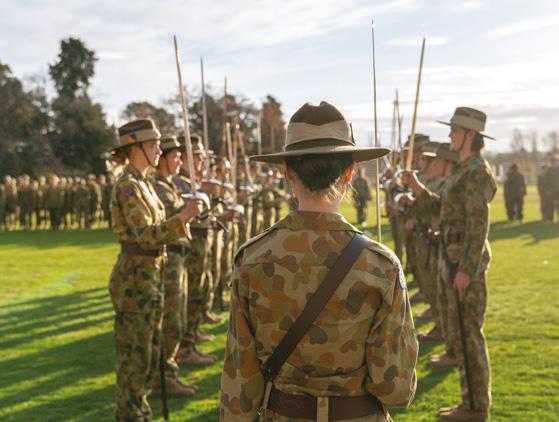
To encourage excellence and a diverse student population, Kinross Wolaroi School offers a number of scholarships to day and boarding students entering Years 7 to 11. Scholarships are awarded for: Academic, Music, General Excellence and Boarding.






For more information about Kinross Wolaroi School and our scholarships visit kws.nsw.edu.au/admissions/scholarships or contact our Admissions Team on admissions@kws.nsw.edu.au or 02 6392 0303.
Applications close: 27/01/23.
admissions@kws.nsw.edu.au

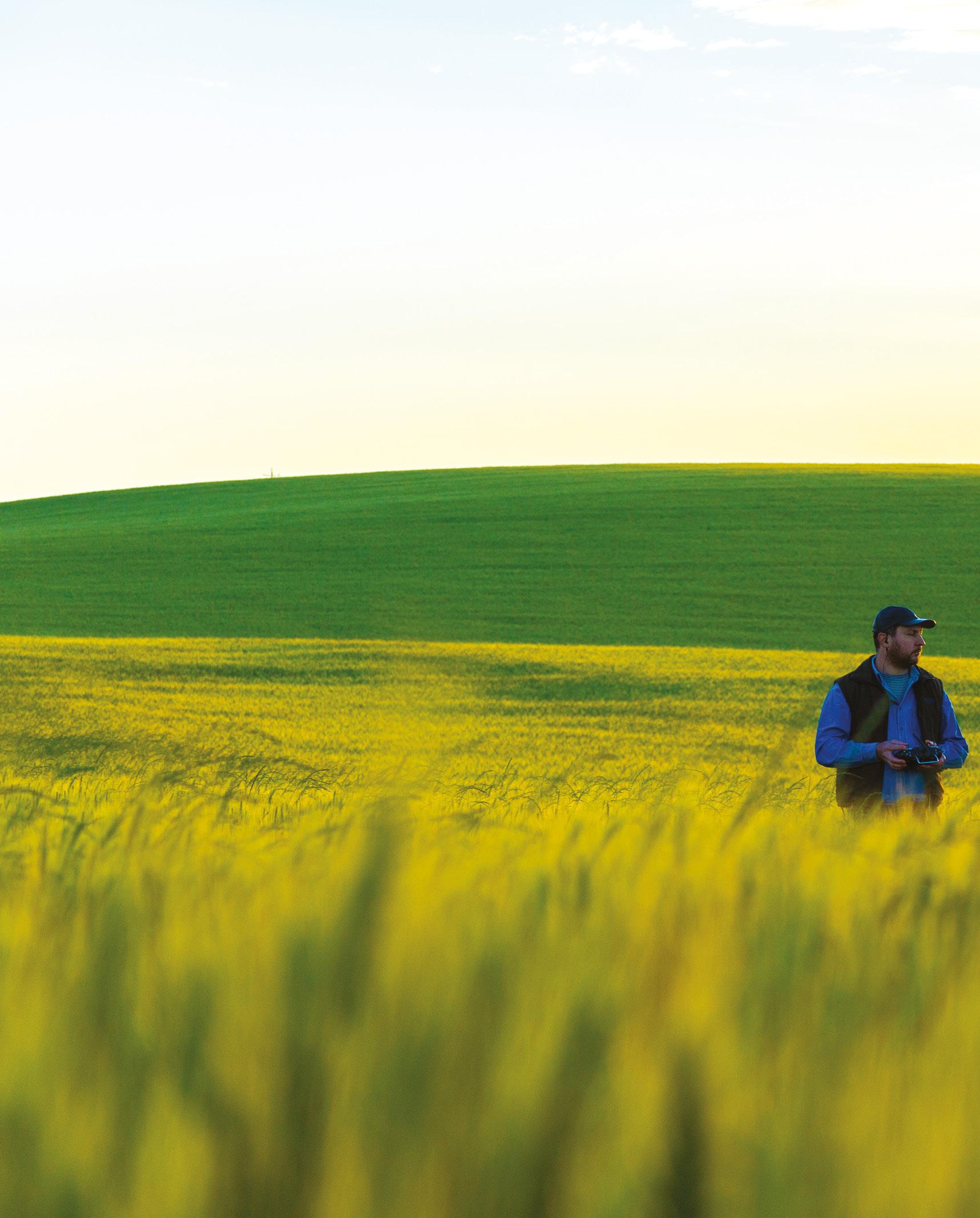
The use of drones as an aide to farming has increased exponentially over the past five years. And there’s a lot more on the horizon. –

Recent surveys show that up to two thirds of farmers either have their own drones or have used contract drone services in the past year. That number is expected to continue to rise as the benefits of drone use become more apparent.
Over the past five years the sophistication and application capabilities of drones has also exploded.
Drones are now in use helping farmers to manage and maintain vital aspects of farm life. Using remote cameras and other surveillance technology to monitor dams, water flow and water management, livestock movement and health, providing security on buildings and farm machinery, drones are saving farm operations thousands of dollars a year.
They can ensure greater efficiencies of operations by mapping water flow and identifying areas of properties that need fertiliser input and the level required for improved crop yields.
Heavy rains across much of eastern Australia and particularly throughout New South Wales has meant that vehicle movement has been problematic, and the number of farmers with bogged tractors and trucks has meant a limitation of full access to farms. However the issue has been alleviated somewhat by drones, because they are equipped with cameras and are able to go where the utes and tractors can’t.
That is just the start of their usefulness.
Highly sophisticated software is being developed which not only assists in efficient use of fertilisers and other inputs but also flow mapping, to measure surface
ON THE RISE Drone use has increased exponentially over the past five years, saving farm operations thousands of dollars through their ability to remotely manage and maintain vital aspects of farm life.
water and to identify the best place to build a dam or the best place for higher yield crop planting. Drones can also identify pests such as weed infestation and feral animal tracking.
Based in the Hunter Valley, Hunter Precision Agriculture is owned and operated by Garth Short. He is developing a unique business base with some of the largest drones currently available on the market.

“We found a drone which is the largest commercial spray drone in the world,” Garth says. “We can now compete with air tractors. We don’t need airstrips and we don’t use aviation fuel, so we have an edge.”
With escalating demand for specialised drone applications, Garth says he is now able to offer environmentally sustainable spray services.
“We found a drone which is the largest commercial spray drone in the world. We can now compete with air tractors. We don’t need airstrips and we don’t use aviation fuel, so we have an edge.”
–GARTH SHORT Hunter Precision Agriculture
The pride of the Hunter Precision fleet is the HPA Ag Spray Drone. This is a fixed wing autonomous system designed for broad acre spraying.
Garth points out that many drones have smaller tanks and slow application rates, however, the new spray drones have advanced thrust vectoring and VTOL technology which allows fixed wing spraying at 120km/h (74mph) with a 7 metre (23-foot) boom and with very fast spray refills.
“With these drones we can go to a 30,000 acre cotton farm and have the whole place sprayed in a week,” he says.

He points out that with many countries now paying a premium for environmentally certified crops, the new drones powered by lithium batteries and delivering highly targeted spray payloads where needed, offers farmers further environmental credentials.

“Major agricultural groups are looking for carbon neutral or negative inputs,” he says. “Our system provides that. This is especially important for European markets.”
The fixed wing drones have a massive 7.3 metre wingspan and a 2.7 metre-long body. They have a maximum take-off weight of 90 kilograms and carry a 45 litre spray payload.


LyonAg Drone Solutions utilises cutting edge, precision agricultural technology from DJI, enabling them with the capability to address a wide variety of situations and challenges. Servicing the Hunter Valley, New England, Mid North Coast and North West regions of NSW. www.lyonag.com.au

For enquiries please contact: James Lyon 0428 468 483 james@lyonag.com.au

With a claimed one-minute recharge and refill turn around, and the drones travelling at 100 kilometres per hour at a minimum of two metres off the ground, the spray is fast and efficient.
Garth says the company aims to have 36 of the drone units in operation in the next 12 months.
James Lyon says the heavy rains over much of New South Wales has meant that many farmers are not able to drive vehicles over their properties to spray, but at the same time the rains have meant weed growth is greater than it has been in many years.
“The demand to spray for blackberries and St. John’s Wort is huge at the moment,” Lyon says.
His company LyonAg Drone Solutions offers spraying, imaging and mapping and spreading services using a number of purpose-built drones including the DJI Agras T20, T30 and T40 carrying up to 40 litres of spray.
A former agronomist, James is well versed in the need for effective and efficient spraying but also has a great awareness of environmental factors.
His team developed Artificial Intelligence (AI) software which, when operating through the drone’s cameras, can identify weed clusters and specific spray areas. This provides for economic efficiency in the use of expensive sprays, but also ensures trees and animals are not sprayed.
“I bought my first spray drone two years ago for my own use, I am now working full-time providing spray services,” he says. “There is a very high level of acceptance for the use of drones. I have 85-year-old farmers ringing me wanting to use the drones as a spray tool.

“Demand at present is so high that we are flying
Drones have myriad uses, including for broad acre spraying. One of the leaders in the field is Hunter Precision Agriculture, with their new HPA Ag Spray Drone.

 –
–
“It is important to not only have the younger generation undertake training, but all generations and sections of the business so that everyone is invested in adopting the technology and implementing the benefits on-farm.”
MICHAEL BURT NSW Farmers Social and Content Manager
20 days out of every month if the conditions are right.”
LyonAg also provides mapping services with specialised software and cameras on board the drones to deliver precision 3D mapping and reconstructions as well as a wide variety of multi-spectrum derived index maps.
James says the technical sophistication of the new range of drones means that training users is a vital component. He points out that there are certifications required from the Civil Aviation Safety Authority (CASA) and transport regulators for both the aircraft and the operators.
Understanding the safe and effective use of drones is of the greatest importance, especially in light of the fact that working drones can cost up to $50,000 and licencing and certification can add another $5,000 to that.
The technical sophistication of drones has grown so much that training users on how to successfully operate their drones is essential. NSW Farmers will offer specialised training sessions in 2023.
The increased interest in drones by NSW Farmers’ members meant that in 2022, specialised training days in drone use and management were provided to more than 500 farmers, contractors and workers.
NSW Farmers Regional Services Manager, Catriona McAuliffe, says that the age of participants in the course ranges from late teens to the 80s, with men and women from all parts of the farming business signing up.
“It is important to not only have the younger generation undertake training, but all generations and sections of the business so that everyone is invested in adopting the technology and implementing the benefits on-farm,” Catriona says.
The courses are a partnership between NSW Farmers, Tocal College and Bralca and funded by AgSkilled 2.0, the key NSW Government program in building capability and addressing rural workforce issues.
According to Catriona, increased interest in drones has meant that NSW Farmers will be providing more courses in 2023, to ensure farmers remain up to date with best practice and training.
The courses are focussed on safe and CASA compliant operations, increasing productivity on-farm by inspecting and mapping horticultural and cereal crops, irrigation systems, fencing, pest animals, and in recent times, levy banks, water inundation and animal welfare.
“Farmers get to learn how to to use drones to collect farm data to help make informed decisions such as refined fertiliser, sowing, crop and weed management plans, as well as monitoring and maximising the efficiency of farmwater systems.” Catriona says.
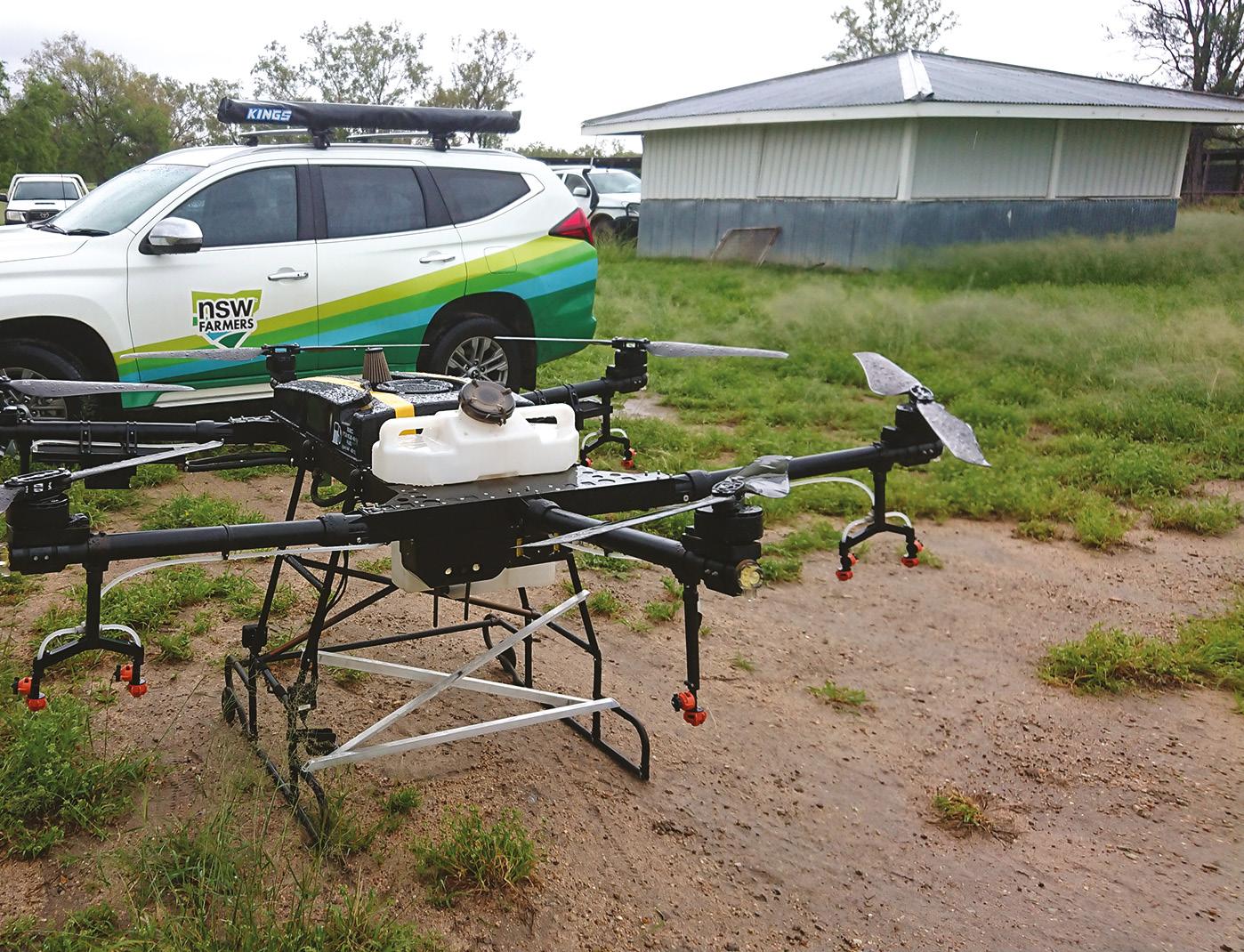
Tocal College developed the Drones in Agriculture course with leading drone operator and trainer Ben Watts of Bralca to meet an identified industry need to increase the uptake of AgTech.
More information is available at: tocal.nsw.edu.au/ courses/short-courses/agskilled/drones-in-ag l
Indications are that more than half of farmers who use drones operate them themselves. NSW Farmers provides support and training throughout the state to help farmers gain the most from drone use. The following is a list of locations and dates for the drone training sessions in the first half of 2023.
Goulburn - 31 January 2023
Bega - 1 February 2023
Cooma - 2 February 2023
Yass - 3 February 2023
Forbes - 16 February 2023
Griffith - 21 February 2023
Yanco - 22 February 2023
Temora - 27 February 2023
Beckom - 28 February 2023
Naradhan - 1 March 2023
Brewarrina - 14 March 2023
Bourke - 15 March 2023
Nyngan - 16 March 2023
Glen Innes - 27 March 2023
Armidale - 28 March 2023
Wagga Wagga - 26 April 2023
Yanco - 27 April 2023
Griffith - 28 April 2023
Lake Cargelligo - 2 May 2023
Coleambally - 3 May 2023
Tomingley - 8 May 2023
Parkes - 9 May 2023
Bellata - 29 May 2
Quirindi - 30 May 2023
Rouchel - 31 May 2023
Kotzur
Kotzur is a proud Australian-owned, third-generation family business that was established in 1953. The business started in a small shed in the NSW town of Walla Walla offering general engineering services, shed construction and the manufacturing of gates. Since then, Kotzur has grown into a well-recognised name for engineering and manufacturing of quality gas sealed silos.
In 1962, Kotzur started to design and manufacture transportable grain silos and by 1972 they had ceased all other manufacturing to focus entirely on the grain silo production. In 1985, after three years of designing and upgrading, the first gas tight sealed transportable silo was produced. The first on ground silo was constructed in 1994.
In 2016 Kotzur acquired the Downfields Engineering grain handling manufacturing business in Toowoomba (QLD). They also operate a sales office in Perth (WA) to service their expanding customer base.
Servicing customers across agriculture, industrial and commercial sectors has underpinned the continuing growth of the company, along with skilled and experienced teams in sales, design, manufacture, projects management and install which have all contributed significantly to the longevity of the Kotzur business.
Kotzur on-ground sealed silos are factory manufactured and assembled on-site and models range from 350 tons up to 15,000 tons in size. Aeration is offered across the silo range to maintain grain quality, which is particularly important in larger silos.
The company also offers a wide range of elevated cone bottom silo models in both a transportable and large elevated built on site models up to 666 tons of wheat. These sealed silos can

is an Australian owned and operated third-generation family business with almost 70 years’ experience in the industry.
be used for general storage offering medium- to long-term storage in a range of segregation levels. They can also be used as a hospital silo for pest eradication of infested grain.

In addition, Kotzur offers a range of silos to safely store fertilizer and feed pellets and silos with drying capabilities using their patented plenum system.

Kotzur products are truly “Australian owned”, and the company is proud to display the distinctive green and gold logo. The business prides itself on being one of the few full integrated domestic storage and handling providers. Products and facilities are designed and manufactured in Australia to meet Australian quality standards as well as to withstand the harsh Australian conditions.
For further information on Kotzur or any of their products please visit www.kotzur.com




Australian designed, engineered and manufactured bulk solids storage and handling solutions for Australian conditions

Farming angora goats for mohair used to be a hobby farm staple. Now, however, the industry believes it’s at a crossroads, with the way forward leading to rapid growth and higher profits.
–Words BEVERLEY HADGRAFTMohair farming is “the best kept secret in agriculture,” says Nick Gorrie, President of Mohair Australia. The lustrous fibre has seen sales surge by 35 per cent in the past two years and Nick believes there’s potential for more growth to come.

With the worldwide shortage in mohair, new markets are emerging. And with lamb, sheep and cattle prices high, farmers are looking for alternatives.
“We just need to compete with that top-of-mind awareness, so farmers know what the market is, what they need to do and what the return on investment is,” says Nick. “For instance, you can easily buy an angora goat for $150 to $180 and you should be able to make that back in a year.”
While Covid-19 smashed many industries, it’s been good for mohair.
“The knitting market has exploded,” Nick says. “Across the world, more people were at home and doing craft. Also, fashion trends have seen more big brands offering mohair jumpers and cardigans, liking the look and the fact improved genetics have bred out the itchiness.”
At present, Australia produces just one to two per cent of the world’s mohair. “I think we’re an industry that could grow 20 per cent a year without causing any impact on demand or changing the pricing,” Nick says.
“There’s not enough mohair being produced plus people like natural fibres and the qualities of mohair, such as its ability to take dyes well and to bounce back and not crease.”
In addition, high-end buyers are keen to buy from and pay a 5-10 per cent premium to growers who’ve met Responsible Mohair Standards.
This covers both animal welfare and looking after the land with a large number of Australian growers now having RMS certification.
Nick believes there’s further room for opportunity in sales of angoras. “It’s an area in which we haven’t performed very well. If you’re selling all your surplus animals to the abattoir that’s a waste but some growers have been doing that.
“We don’t tend to send goats to saleyards and that’s an area we need to improve on. Those saleyard agents are well networked and we miss out not being involved in that network.”
He was pleased recently to see an entire stud sold to a sheep farmer in the Wagga Wagga district which saw a new grower established, but he wants to see more of that.
“The more growers you have, the better, because every two or three years you need to change your bucks and we haven’t got that commercial base,” he says.
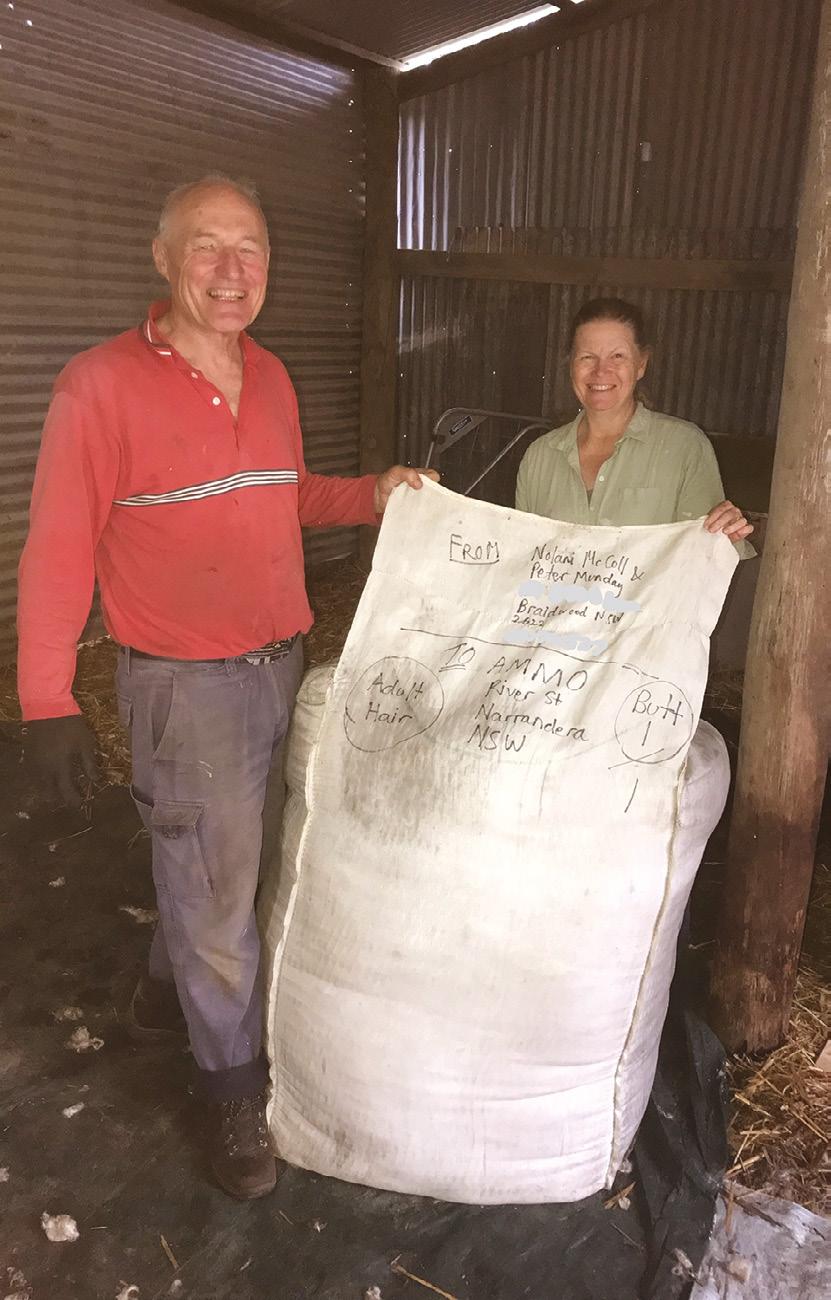

So, what kind of farmer might like to look at angora goats?
“If you’ve already got the infrastructure like shearing sheds, yards and shelter, it’s ideal,” Nick says. “Angoras don’t graze pastures very heavily so, in rotation with other livestock, they can be good because they’re looking for different things in pastures.
“Older goats can utilise marginal, hilly land and although it’s best to start slowly and build up your skill set, you can increase herds very quickly when the market is strong. Goats often have twins so, with one or two kiddings, you can capitalise on good fibre prices.”
Nick went to school in Canberra (near to the Hills of Hall region where he now farms) that had Angora goats. His interest began there. When he left school,
THE G.O.A.T. Peter Munday and Nolani McColl from Braidwood (top left); Nick Gorrie (above and right), President of Mohair Australia, says that demand for mohair has exploded, thanks to a boom in knitting during Covid-19 and fashion’s renewed interest in mohair for jumpers
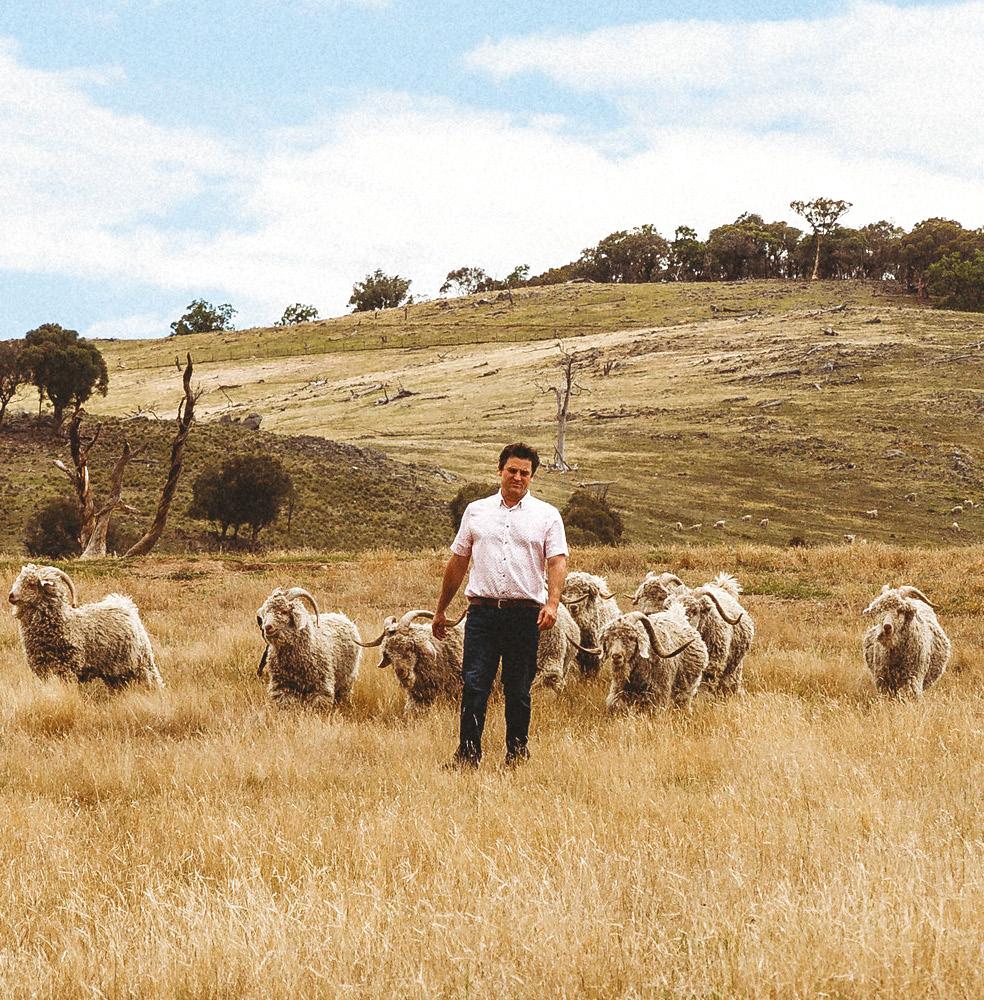
“Older goats can utilise marginal, hilly land and although it’s best to start slowly and build up your skill set, you can increase herds very quickly when the market is strong. Goats often have twins so, with one or two kiddings, you can capitalise on good fibre prices.”
–NICK GORRIE President of Mohair Australia
and cardigans.
he intended buying a horse but decided to buy four angoras instead - and now has 1,000. I HEV SORTED THE AR“At the start, we ran it as a bit of a hobby but we’re now a commercial operation and I own a farm of 170 hectares, plus rent some land from a neighbour,” Nick says. “We sold $72,000 worth of mohair last year off basically 500 goats, plus I then kidded another 300 and kept my wethers from the year before as well as sending older wethers to the abattoirs where prices for goat meat are good. It’s pretty phenomenal.”
Nick says that they are very rewarding animals, especially the kidding. “The babies are so gorgeous when they’re little.”
Grant Forsdick from Burragate is originally from South Africa, the capital of angora goat farming. “We were actually part time fruit farmers but after the farm was acquired by the government, we decided to start again in Australia,” he says.
“I didn’t even think about angora farming but when we bought Currajong Common, the vendor said we couldn’t have it unless I took the 160 goats as well.”
Grant decided to give it a go and found a very good mentor whose breeding advice has allowed him to seriously improve the quality of mohair he produces.
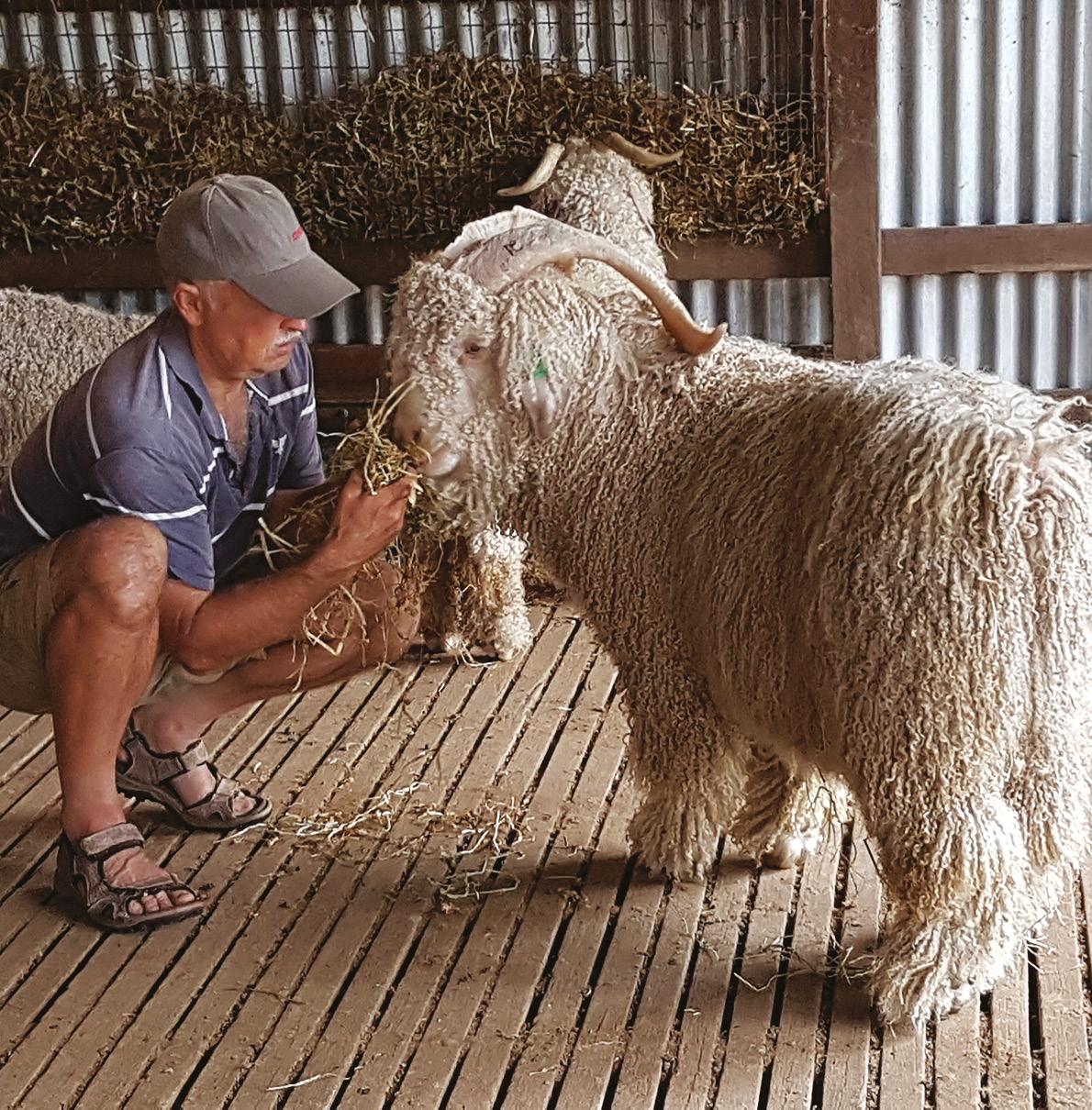
“I’m involved in the Weaving Project so what we do is slightly different to traditional mohair
Grant Forsdick (above), Chairperson of the Australian Mohair Marketing Organisation, is involved in the Weaving Project, producing mohair with a longer and finer fibre.
producers,” he says. “Our mentor identified that the top of the market wanted a longer fibre. You get a premium price for that, especially if it’s very fine. It means I shear at seven months instead of six.”
At the last assessment, 100 per cent of Grant’s kids’ fibre were approved for the Weaving Project, meeting the criteria for purity and length. They all produced sub-20 micron fibres.
“We improve price further with RMS certification and at the last sale, the best RMS fine kid mohair sold for a premium,” Grant says. “My wife Jenny and I currently have 400 adults and 110 kids across 42 hectares, and we really enjoy them.
“We apply regenerative farming practices and they’re so smart, they’re easy to move. All we do is call and shake a bucket of feed and they go.”
Because the couple shear twice a year, they find themselves better off when it comes to cash flow than when dealing with sheep, although goats are more difficult to shear because they have thin skin and less body fat.
“They’re lighter and more docile and shearing takes a bit longer so we have to pay a bit more for shearing,” Grant says.
“I’m Chairperson of the Australian Mohair Marketing Organisation (AMMO) so one of our current challenges is how to increase qualified goat shearers.”
Nolani McColl and her husband Peter are from Braidwood and they decided to buy angora goats after meeting Grant Forsdick at a holistic management course.
“We visited his farm and ended up buying our first pregnant does in June 2021,” Nolani says. “I like the fact that goats are a small animal so I can handle them, and I also like the structure of the industry. We can focus on growing and then, once they are shorn, we can send the fibre to AMMO and they dealt with the selling.”
Nolani is interested in spinning and textiles so in the future she’d like to sell into the home spinners market. “Angoras’ fleece is so beautiful – it has a lustre and takes natural dyes really well. Unlike sheep wool, it’s a solid fibre.
“Although I work for the Mulloon Institute (an environmental and sustainable research resource for farmers), we don’t have farming backgrounds but we’ve had lots of help from Grant and Nick plus our local shearer David Lillis who is on the AMMO board and focusses on angoras.”
The couple say that getting the goats has been very satisfying, and now they have a herd of 95.
“We haven’t got a return on them yet as things such as infrastructure, buying equipment and intestinal worm drenches have been expensive,” Nolani says. “I’m hoping that down the track, we’ll get ahead but that’s not why we’re doing it. We had 37 hectares and it seemed unconscionable to have land and not use it.” l
Many of our farming families have fascinating histories stretching back generations. However, the story of the Suttor family from Brucedale in Bathurst hasn’t only been shared amongst themselves, it’s been shared with the whole of Australia.
Words BEVERLEY HADGRAFT Photography RACHAEL LENEHANMost farmers consider themselves custodians of their land. For David Suttor though, the bond goes deeper than that, as he’s also custodian of his family’s history.
The Suttors’ story has been told in TV documentaries and books while local schools still come out to the sixthgeneration farmer’s Bathurst property, Brucedale, to hear him recount it again.
We spoke to David just after floods had swept through his property, destroying infrastructure ranging from his newest fences to the regenerated creek he’s been working on for years.
He was also worried about energy and grain prices and whether he’d be able to get his machinery out onto waterlogged fields. Despite this, David has not thought about selling up and turning his back on a history that began in 1800 after George Suttor was invited out to Australia by the famous English botanist Sir Joseph Banks – who wanted him to bring out plants to help establish the colony.
George had actually wanted to be an actor, says David, but his wife Sarah’s parents weren’t going to let their daughter marry a thespian.
“Instead, he came out as a horticulturalist farmer and developed the first commercial orange orchard in Australia at Baulkham Hills.”
In 1822, thinking he was about to lay claim to a 2,000-acre land grab, George and his son William, then 17, travelled over the mountains to Bathurst with 400 sheep, some bullocks, horses, and a dray with their supplies. In fact, the land ended up being only 320 acres.
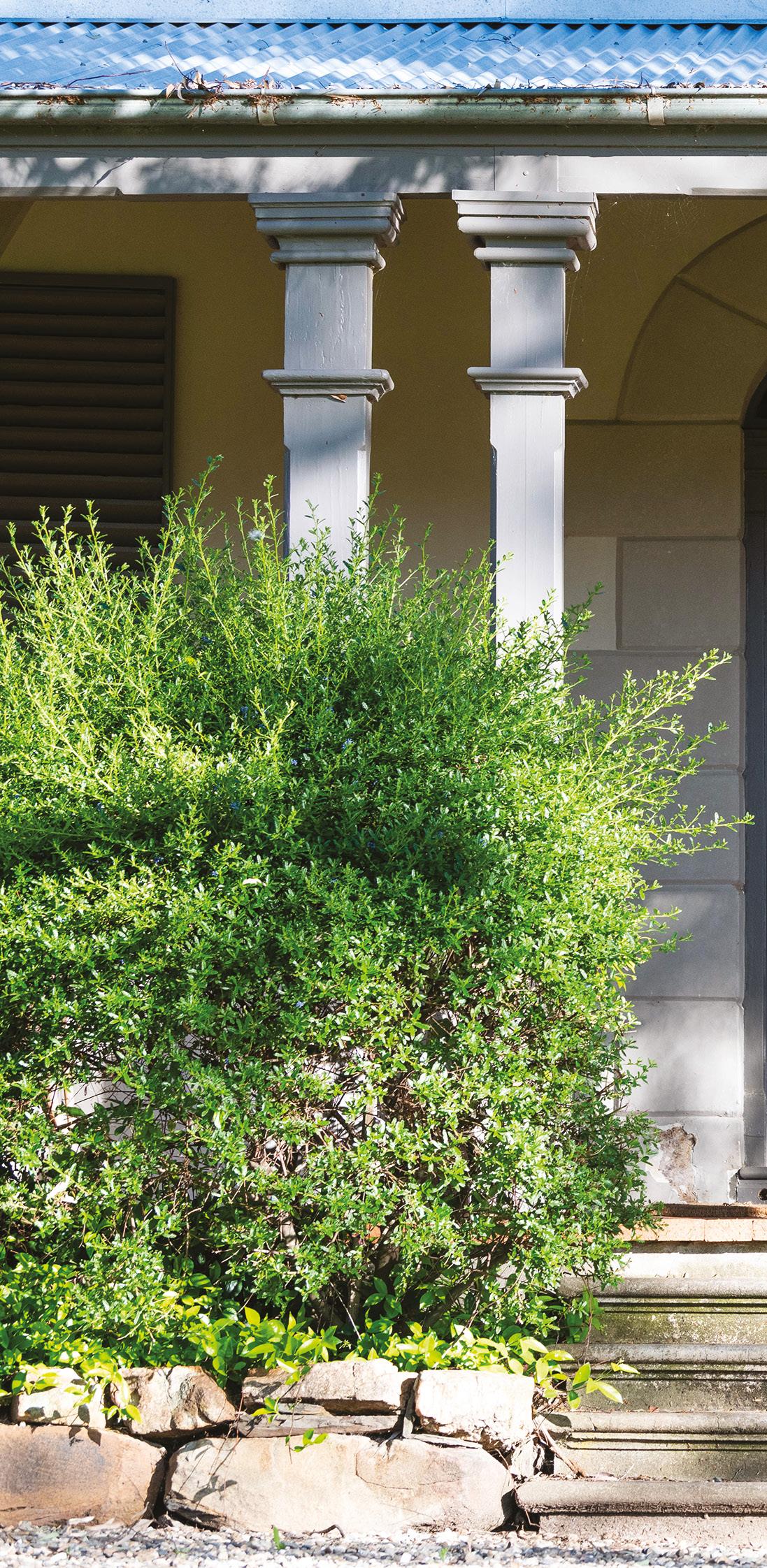
LIKE FATHER, LIKE SON David (right) with his eldest son Will (32), who runs a roofing business with his brother Jock. Both would love to see the family farm continue to preserve their history.
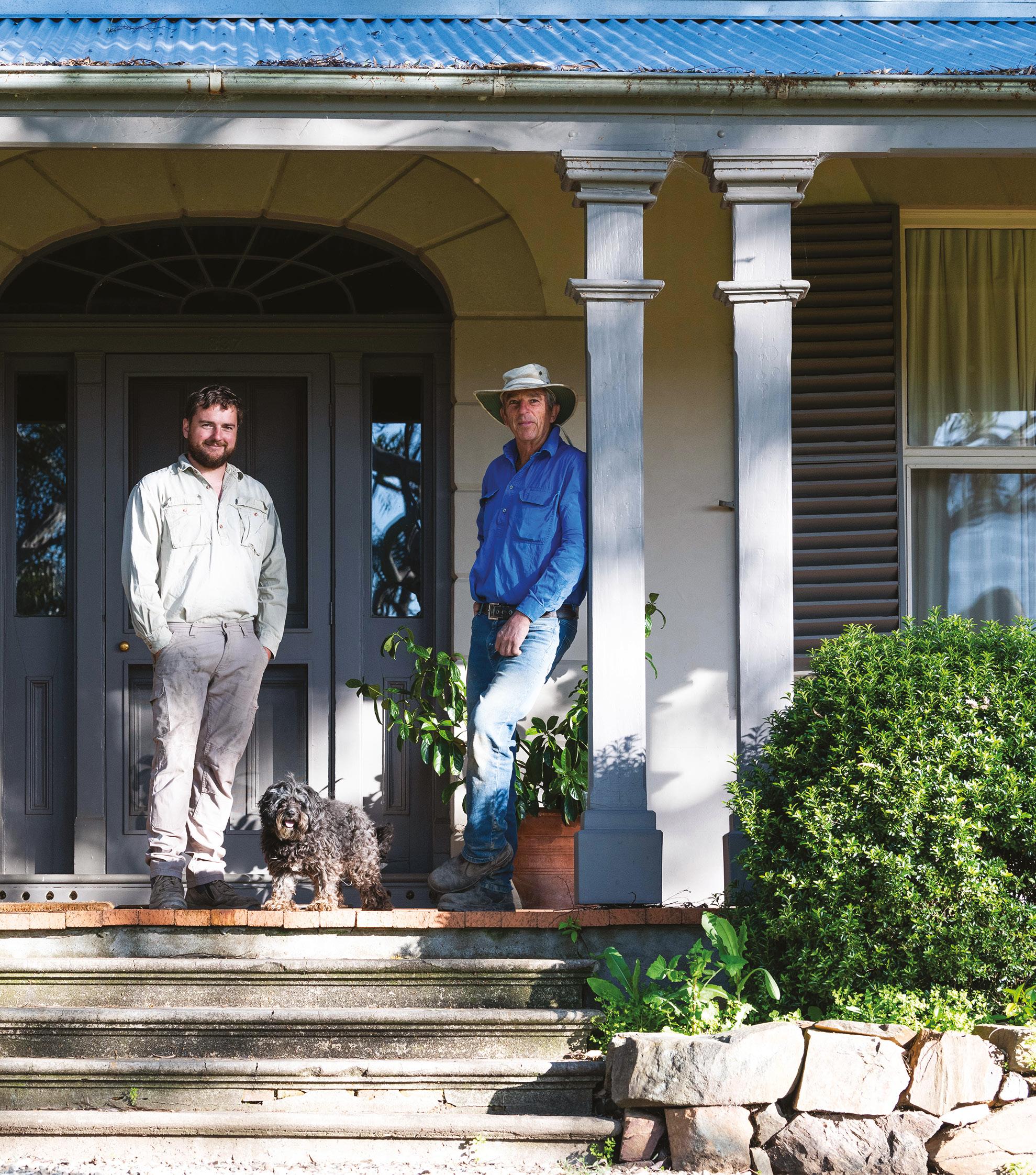
“George left William in charge of the livestock in Bathurst until it could be sorted out, instructing him: ‘Treat all of the Aboriginal people with respect and kindness. If you do, you won’t have any trouble’.”
Without that advice, the Suttor family line might have ended right there.
The local Wiradjuri people weren’t happy about all the new settlers taking their land and years of martial law and conflict followed.
William, however, was always kind, says David, and when a party of angry Wiradjuri, led by famous warrior Windradyne, turned up at his property intent on revenge for his slaughtered people, William was able to speak to them in their own language, diffusing a potentially fatal situation.
Windradyne, supported by the Suttors, went on to travel to Sydney to plead with the Governor to have martial law suspended and is now buried 1.5 km from David’s home.
The land is fenced off and recognised as a national park and he regularly sits with the warrior’s ancestors to speak with school children.
“When you have these historic things on your farm, they need to be acknowledged. The Wiradjuri are welcome here at any time. It’s a positive, dual history we share, and we like to get it out into the public as much as we can. It’s a special, ongoing thing to be involved in and something we’re very proud of.”
Kindly William, meanwhile, went on to become one of the biggest farmers out west. “It was the squatocracy period, you could lease 6,000 acres from the Crown for about 10 pounds a year. At one stage he had 600,000 acres under his control, all the way up to QLD.”
Not surprisingly, the government eventually realised it was not the fairest system and broke the runs up.
William continued to do well, however, out of the gold rush. He didn’t find gold himself – although his brother-in-law, Dr Kerr, laid claim to the famous Kerr Nugget, a 109-pound find of gold.
“It was actually found by one of his
Aboriginal shepherds who sat down for lunch, turned over a big rock to make sure there was nothing under it and exclaimed: ‘That’s the yella stuff those white blokes are looking for’.
“He rolled the rock back and told Dr Kerr. They smashed it up and put it into saddlebags, stored it at Brucedale then took it into town to get it valued. In the 1850s it was worth more than $4 million in today’s money.
“I don’t know if Kerr shared the money. He gave the shepherd some sheep and tobacco but within a couple of days he’d been swindled and left with only his tobacco. That’s what happened in those days. The Aboriginal people had no idea of the value of gold. If a white man had found it, he probably would never have told Kerr.”
Bizarrely, it was the only bit of gold found in the area. “Others came to look but never found any more. It truly was amazing, especially as it was just lying on top of the ground with this quartz around it.”
William, instead, found his own riches, selling beef to the gold diggers in Ballarat
The Suttor family have a long and interesting history, arriving in Bathurst in 1822 with 400 sheep, some

and a dray with their supplies. Today, the farm is 1,100 hectares, running sheep, cattle and cropping.
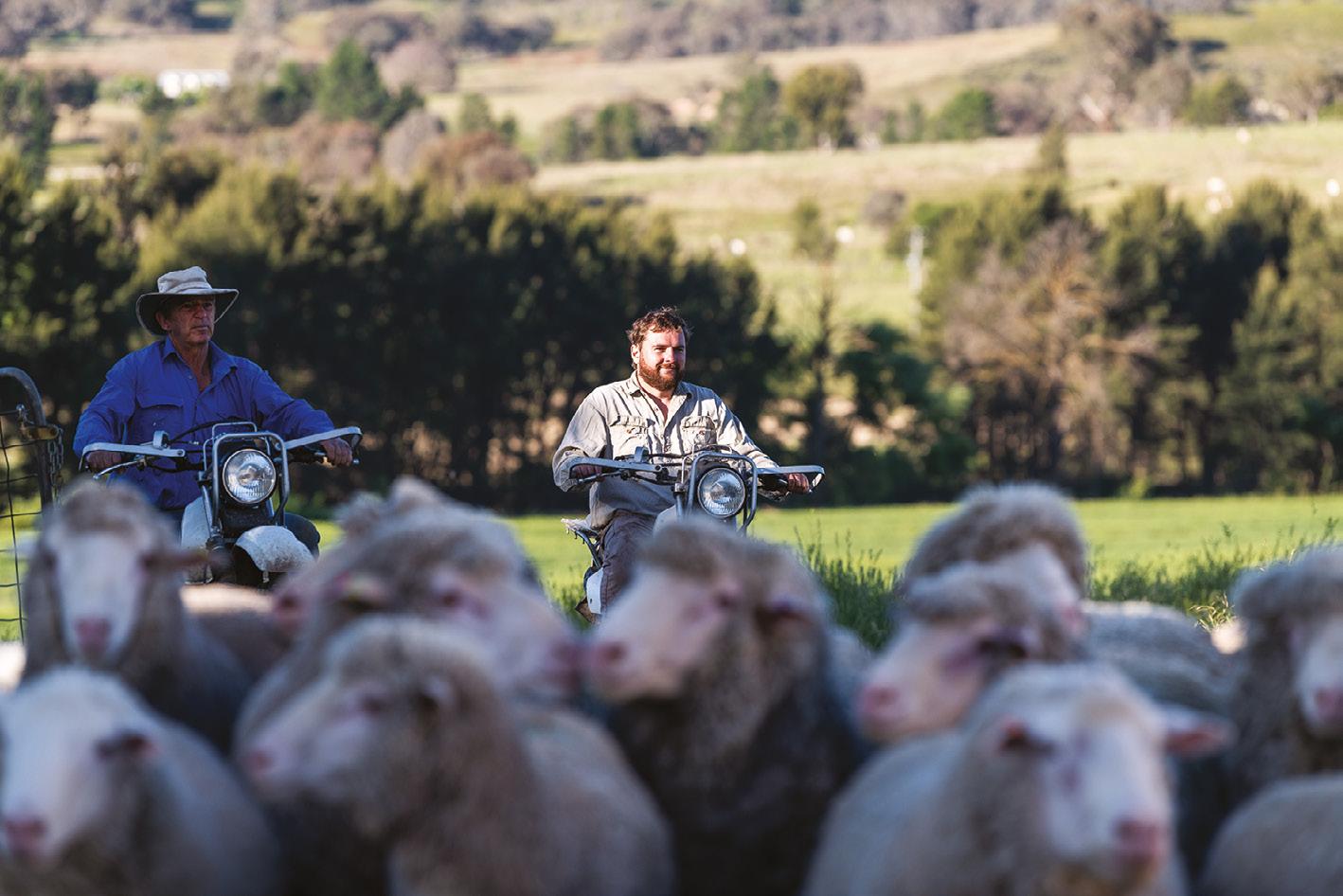
“We recently found a story about him classing sheep out west and breaking two records in one day – one for classing 10,000 ewes (obviously he wasn’t looking at them very closely) and the other for drinking everyone under the table!”
Suttor speaking about Herbert Suttor
I’m a Member of NSW Farmers because… “I am one of the great defenders of farming organisations like NSW Farmers you will ever find because together we stand, united we fall. All farmers in NSW need NSW Farmers to be able to take a united stand on issues that matter to us.”
 Terry Fishpool - Tottenham Branch
Terry Fishpool - Tottenham Branch
and Bendigo. “They’d put a mob of 800 cattle together and walk them there.
“There was a shortage of beef and with the gold rush it was worth a lot of money – so many people and no refrigeration. Whatever was butchered had to be eaten.”
David recalls one particular incident when William was unable to get the cattle across the swollen Murray River so had to sell them on the NSW side for six pounds a head.
Realising patrons of the local pub knew how much he had stashed in his saddlebags, he then had to put a wad of his cash behind the bar and get the publican to promise not to let any of them know he was on his way before they’d drunk the lot.
Fortunately, he had himself well hidden on a rocky hill by the time the inebriated patrons galloped past.
David’s great-great-grandfather, Herbert (William’s son) was more interested in sheep than cattle. “He won trophies for breeding Merinos, although we wouldn’t want those wrinkly Merinos today. No one’s got the labour to chase the flies out of those things.”
Like David today, Herbert also did a lot of off-farm work.
“There’s a bit about him being a sheep classer and we recently found a story about him classing sheep out west and breaking two records in one day –one for classing 10,000 ewes (obviously he wasn’t looking at them very closely) and the other for drinking everyone under the table!”
David’s grandfather Roy was next to take over, also dealing with the devastation of two World Wars and the Great Depression. His dad John then took the reins, swapping from sheep back to cattle again.
“Unfortunately, he ran into trouble in the 1982/83 drought. He couldn’t even send them away because Brucellosis was around then. When I came back in 1988, I put sheep back on the place producing wool and meat.

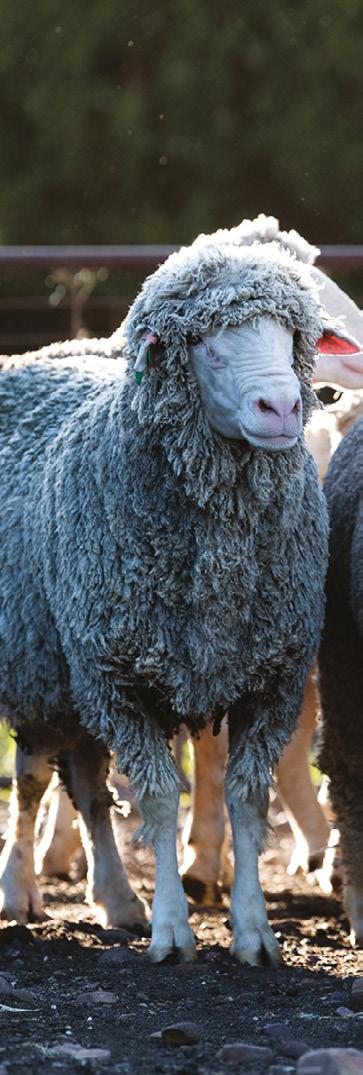
“I have recently bought some young heifers though and we’ve joined QLD cattle to a European breed, so we’ve got some cracking calves to sell next autumn and get back into cattle trading.”
Over the years, Brucedale has shrunk in size and David is now down to 1,100 hectares where he currently has
nearly 3,000 sheep, 190 cattle and does a bit of cropping. He still lives in the original homestead, built for William and his wife Charlotte in 1837: “We’ve modified it with indoor bathrooms but it’s still the original Georgian house.”
At present, the family is wrestling with the perennial farmers’ dilemma of succession. The farm can’t be reduced in size any more or it won’t be viable and there’s no way the Suttors would sell up and walk away.
His improbable dream scenario would be for the government to buy it and the family to rent it back.
It has, after all, become a special place for generations of Wiradjuri who still come to Brucedale to tend Windradyne’s grave and share the story of how whites and blacks found peace together.
“History could stay here and we could become the curators,” he says.
Will is David’s eldest son, and he has two siblings, Jock and Phoebe.
“Growing up, I always knew I wanted to be a farmer,” he says. For now though, achieving his dream is a work in progress. Currently, Will – who will be 32 in March – has his own roofing business in town with Jock working alongside him.
“We’re both very interested and want to be involved in the farm and all three of us would love to see the farm continue,” he confirms. “We’re all on the same page there. It’s just getting it to a point where it works for all parties.”
Succession plans have always been a headache for farmers. Recently though, it’s become harder than ever. Land and stock values are high which makes paying family members out or acquiring more land impossible and many have to continue off-farm work to make ends meet.
Will has grown up with stories of his incredible family and, while times were undoubtedly tough back then, he says enviously, “There were a lot of opportunities for an adventurous go-getter back then. They took those opportunities and went with it.”
Whatever happens to the farm, however, one thing is certain. Will and his siblings will continue working with the Wiradjuri people. “That section with Windradyne’s grave is fenced off and will always be preserved as history.” l

“Being custodians of history as well as the farm, we do feel a particular sense of responsibility,” David says. “That history is something to treasure. I wouldn’t want it to end under my watch and my kids are the same. They want it to continue, we just have to work out how.”
Clockwise from top: Aerial view of the Brucedale property, where the remains of Wiradjuri warrior Windrandyne rest; David sees himself as the custodian of his family’s history; the Suttor family run 3,000 sheep and 190 cattle on their property.
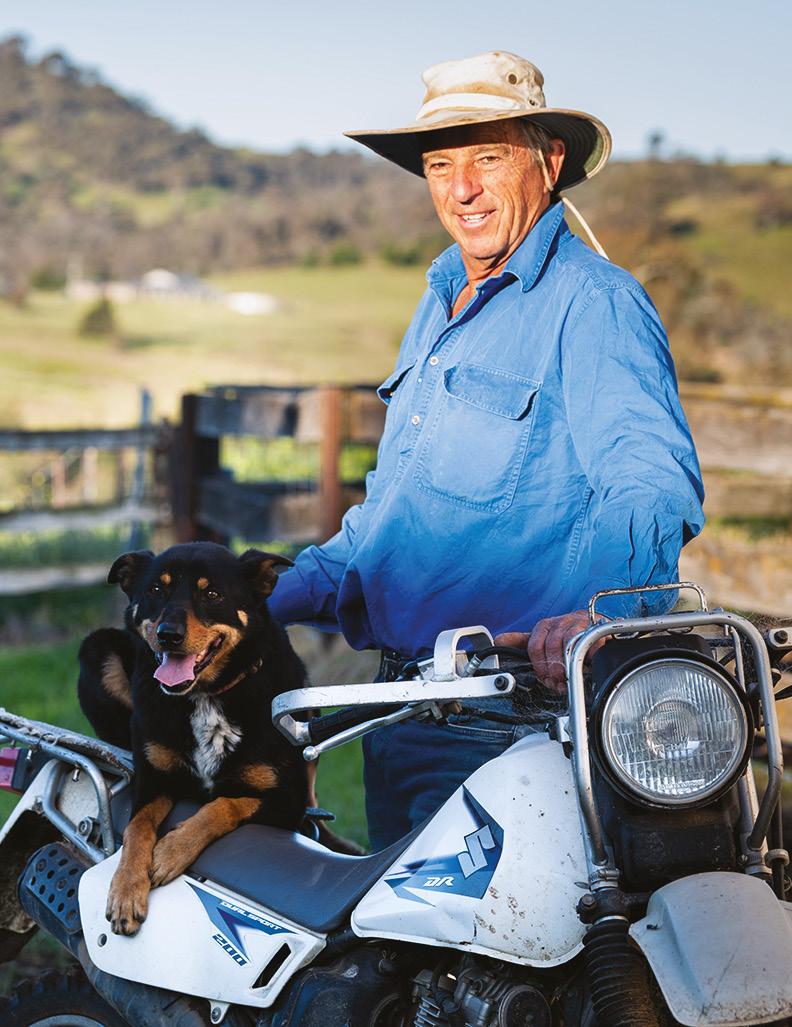


This lovely ol’ soul who pretends to be deaf really is man’s best friend.
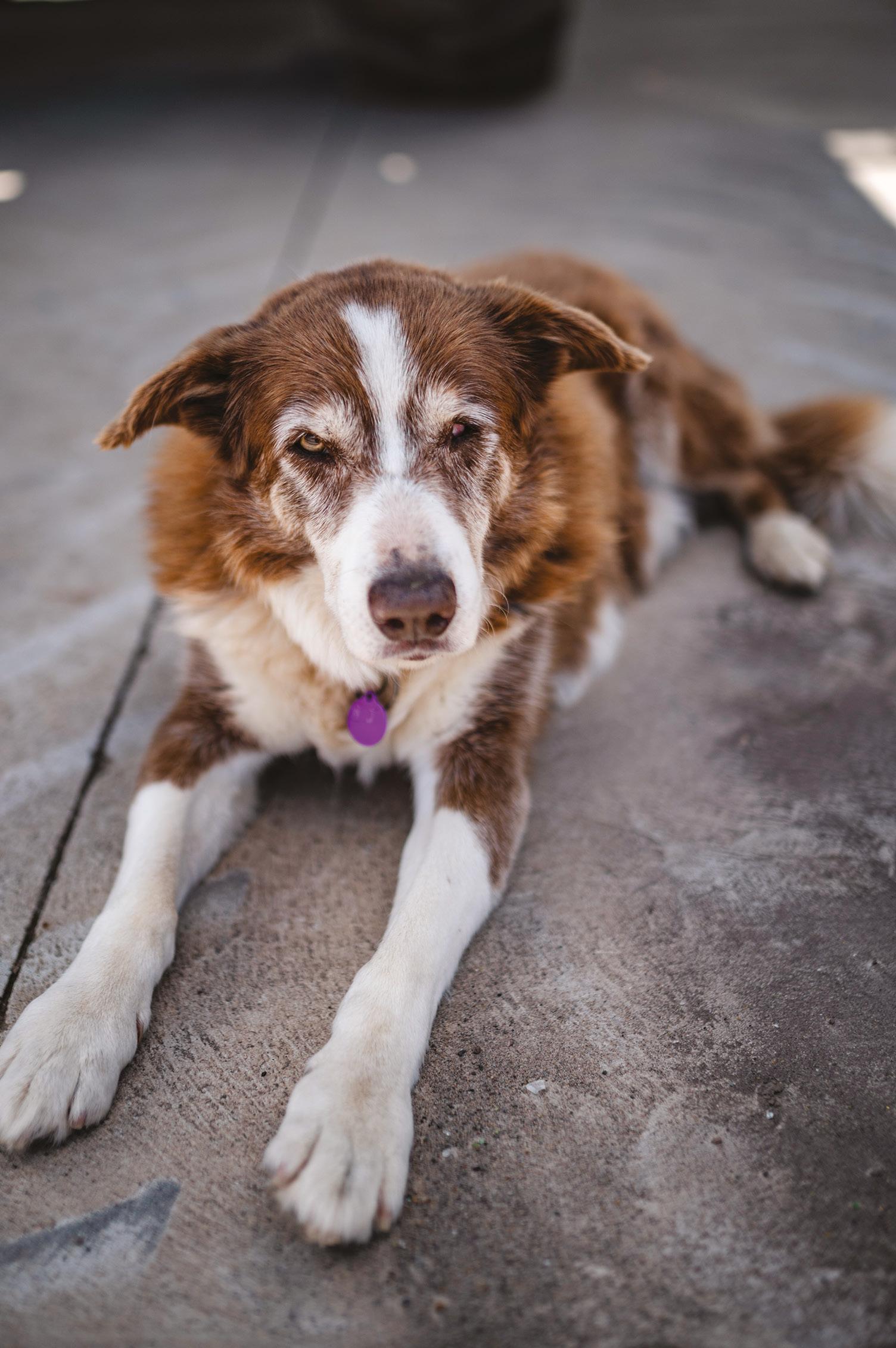 EDITED BY MICHELLE HESPE PHOTOGRAPHY GETHIN COLES
EDITED BY MICHELLE HESPE PHOTOGRAPHY GETHIN COLES
REAL NAME AND NICK NAMES: Mr Bojangles or Banjo. But you can call me BJ.
WHAT IS YOUR FAVOURITE THING TO DO ON THE FARM? Now I am happily retired, I hang around my master, sleep under his desk in the office and have the air conditioner cranking all day.
HAVE YOU EVER DONE SOMETHING REALLY NAUGHTY? Sure, and I’ve done it a lot more than they think. When I was a young sprightly lad I ‘jumped the fence’ if you get my drift. I do not know how many descendants I am responsible for.
WHAT IS YOUR WORST HABIT? What did you say? Pretending that I am deaf.
WHAT IS YOUR FAVOURITE FOOD? Fresh offal, straight from the paddock to plate.
IF YOU BECAME FAMOUS FOR ONE THING, WHAT WOULD IT BE? Having lived a life of loyalty and faithfulness. I am an intelligent worker and still have good looks if I do say so myself.
IS THERE SOMETHING THAT DRIVES YOUR PARENTS MAD? Pretending to be deaf when on an awesome sniff trail, and they are in a hurry.
IF YOU COULD HAVE ANOTHER ANIMAL AS A FRIEND, WHAT WOULD IT BE AND WHY? A retired cow, because mutual respect would have been earned whilst we were young and working hard.
FAVOURITE TOY OR THING TO PLAY WITH? My dreams. I run a long way and jump over lots of fences to meet the pretty young things.
WHAT DOES EVERYONE LOVE ABOUT YOU? I’m a good bloke.
ANY LAST WORDS? You could have got a better shot of me by not showing my missing left eye. No, actually, I’m happy with it. Gives me a wise kinda appeal.
We’ve rounded up the best Aussie-made products for your stylish country home.
Using earth and clay from outback Australia, this lovely oil pourer is a convenient vessel to fill with your favourite oils or syrups. The stylish design allows for easy pouring, making it a must-have for any kitchen or table decor.

$75 contemporaryco.com.au
With golden swirls on the body and brown on the head and legs, this cow figure is sure to bring a timeless elegance to any home. The decor is finished with pink detailing on its ears and black painted hooves, adding a vintage aesthetic wherever you place it. $84.50 sillandsage.com.au

ROCK ON
Sit in style with this antique brown rocking chair by Chocolatewood. This rocking chair is made from the finest rattan wood. With both comfort and style, this timeless piece will tie any room together.

$449 chocolatewood.com.au
This 60mm thick cutting board is the real deal. Designed for the most experienced chefs and entertainers, this board will be the focal point of any event. Gather some friends over, create your finest charcuterie board, and enjoy!

$599 thecuttingboardcompany.com.au
Bring warmth and comfort to your home with this gentle and calming blend of honey, amber, fresh hay, musk and incense. An elegant and simple combination, this candle will evoke memories of days spent exploring the countryside.


$44.95 meeraboo.com.au
Carefully and uniquely handcrafted for each purchase, Fabrican Woodworks helps both small and large dogs enjoy their dinner. These artisan dog bowls will rid your kitchen floor of any mess and have your dog dining in style. $162.95 fabianwoodworks.com.au

SOFT AND STYLISH
Designed for cosiness and luxury, these fur pillows add charm and class to any interior. They’re made from alpaca wool, offering an unparalleled level of comfort and style to match with any chair or couch.

$229 eluxuryhome.com.au
With its soft and fanciful fringe finish, this blanket is the ideal companion to cuddle up under. Merino products and packaging are 100% biodegradable and are the natural choice for keeping warm and ensuring comfort.
$319 modernmerino.com.au

 Name: Adele Smith
Name: Adele Smith
Farm: Young NSW Farmers Branch: Young Years as a Member: Four
“With an emotional investment in agriculture throughout my life, I think it’s a no-brainer to be a member of an organisation that is involved in advocacy work and policy development for the industry that I love.”

Why are you a NSW Farmers Member?
I was born and raised on our family’s farm just outside of Laggan where I was quite literally chasing Merino sheep and falling in love with the best natural fibre on the planet – wool! With the love for sheep and wool in my veins, I dreamt of a career where I could harness this passion.
There is so much that I love about agriculture, but one of my highlights would be the people. They’re very genuine, highly adaptable, incredibly creative and amazingly
innovative. I also really love the technology that is involved in agriculture and it excites me to see what will come next in terms of technology around traceability, provenance and the amazing stories our farmers have to tell.

My husband and I have only recently bought our small farm, but it is definitely no surprise to anyone that knows me that he did not get much of a say in what we’re running on our farm. I am Merino mad and so we will predominantly be producing Merino wool and First Cross lambs.

WHAT DO YOU THINK IS THE BIGGEST THING TO HAVE HAPPENED IN FARMING IN THE LAST 10 YEARS?
The advancements in technology have been astronomical, enabling producers to be able to increase efficiencies. My personal favourite advancements are naturally to do with sheep. Some of the sheep handlers that are on the market take a lot of the ‘work’ out of sheep work and electronic ID (eID) provides the ability to have a better understanding of the productivity of individual animals to help make sure that your flock is full of ‘performers’. There is also the improvements in sheep yard designs that make the sheep flow and even include a shed/roof over the top to make sheep work possible in almost any weather.
WHAT DO YOU WHEN YOU ARE NOT FARMING?
Outside of my work as Wool Technical Officer, I am involved in a number of community organisations including our local Rugby Club and the Picnic Race Club
& Show Society. My husband and I also run our own business called Growmore Agronomy Services.
In terms of hobbies, I really love taking photos of rural life and scenery and quite enjoy baking. I’m also very much a green thumb – if you don’t find me in a paddock, I’m normally poking around in the garden.
I really enjoy the Sheep Connect NSW podcast as well as The Young Farmer Business Program Propagate Podcasts.
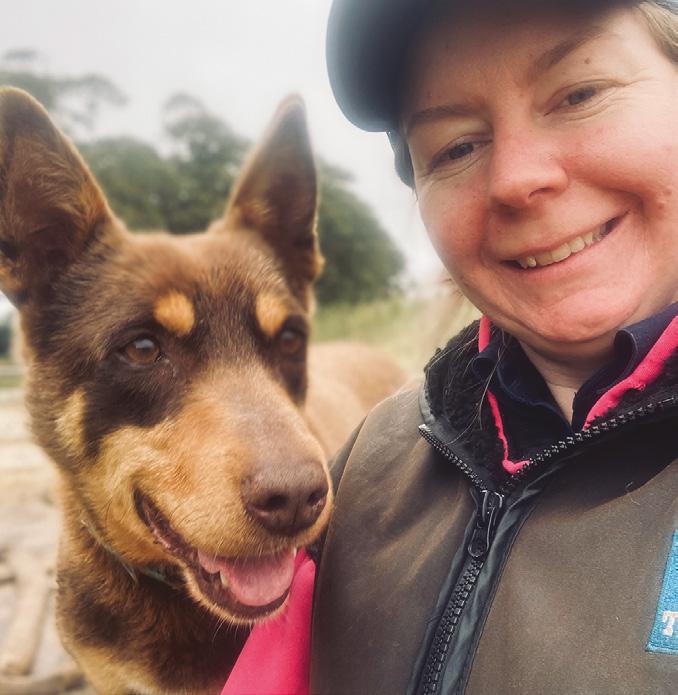
I love it when my copy of The Farmer turns up in the mailbox. It’s usually a very entertaining read to thumb through over a few days over cups of tea. As I have mentioned, I’m amazed at the ingenuity of those in our amazing industry and so my absolute highlight is usually the Innovation section. l
Help protect your livelihood. NSW Farmers is your voice – we are only as strong as you make us. The greater our numbers; the greater our voice.


FULL PRODUCER MEMBER $438.90
For those who own or manage
1 VOTE PER MEMBERSHIP a farm. Includes our basic workplace relations package which provides:

· Collective representation on awards, minimum wage review, workers compensation.
· Wage information, including wage guides issued annually.
· Phone advice, four calls a year.
ADDITIONAL MEMBER $100
Linked to a full producer, with a
1 VOTE PER MEMBERSHIP proprietorial or income interest.
SECOND VOTE MEMBER $100 Linked to a full producer, most
1 VOTE PER MEMBERSHIP often a family member.
SMALL FARMS MEMBER $150 Have a small holding and do not receive majority of income from it.
ASSOCIATE MEMBER $100 Do not own a farm, e.g. teachers, agronomists, business people.
COUNTRY CONNECTION $100 Supporters of farms from the city.
RETIRED MEMBER $100 For retired farmers
you.
ESSENTIALS WORKPLACE RELATIONS PACKAGE
Members can upgrade to this package to receive:
· Unlimited advice on employment matters.
· Assistance in negotiating with the Fair Work Ombudsman’s office.
· Representation in employment matters handled by tribunals, such as Fair Work Australia.
· Assistance with drafting and reviewing employment-related correspondence, policies and procedures, and employment agreements.
The Essentials Workplace Relations package fees start from $165 for up to two employees.
Extra charges may apply for assistance required within your first four months of membership. All prices include GST.
Use your voice, become a member at nswfarmers.org.au or call 1300 794 000.

FOR ALL GENERAL ENQUIRIES Contact the Member Service Centre on 1300 794 000 or your local regional services manager:
NORTHERN Michael Collins, 0439 958 163, collinsm@nswfarmers.org.au
NORTH COAST & TABLELANDS Mark Bulley, 0429 330 348, bulleym@nswfarmers.org.au
CENTRAL TABLELANDS & ORANA Andrew Coughlan, 0447 393 092, coughlana@nswfarmers.org.au
SOUTHERN David Banham, 0428 411 221, banhamd@nswfarmers.org.au
SOUTH WEST Frank Galluzzo, 0427 773 495, galluzzof@nswfarmers.org.au
LACHLAN & NORTH RIVERINA Catriona McAuliffe, 0488 100 005, mcauliffec@nswfarmers.org.au
WESTERN DIVISION Caron Chester, 0400 116 207, chesterc@nswfarmers.org.au
YES, I WOULD LIKE TO JOIN NSW FARMERS.
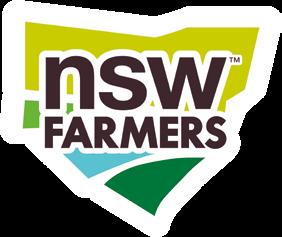
I HAVE TICKED MY MEMBERSHIP CHOICE ABOVE. PLEASE CONTACT ME.
NAME: ADDRESS: EMAIL: PHONE: COMMODITY (IF APPROPRIATE):
REGIONAL SERVICE & SALES MANAGER
Jonathan Tuckfield, 0409 493 695 tuckfieldj@nswfarmers.org.au
MEMBERSHIP SERVICE MANAGER
Alicia Harrison, 0429 817 611 harrisona@nswfarmers.org.au
Kids to Farms is a program aimed at increasing awareness in primary-school students about agriculture through excursions to farms, farmer visits to schools, and other resources.



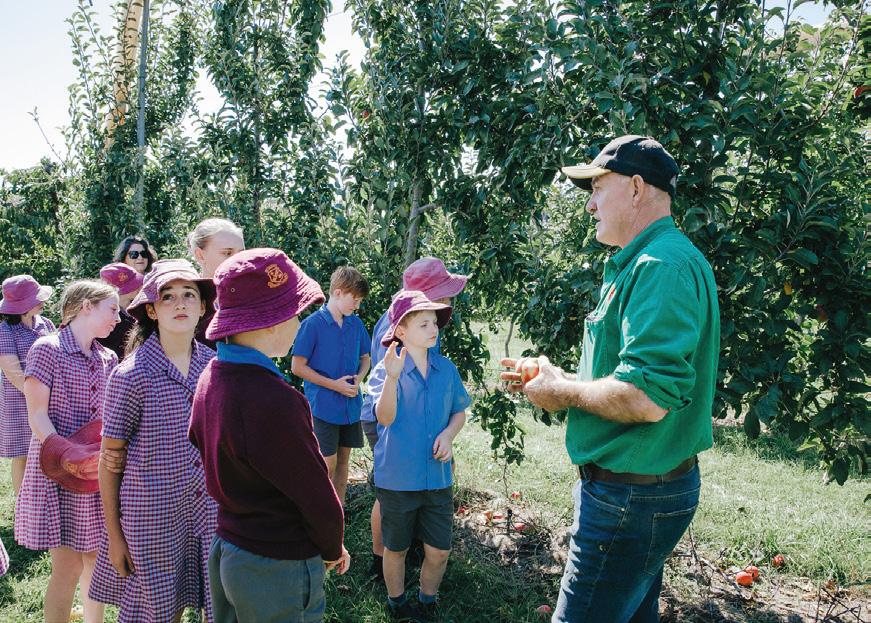

If you want to help students learn more about food and fibre, get in touch today.
This project is supported by funding from the Australian Government Department of Agriculture, Fisheries and Forestry

The Cobar Sound Chapel (cobarsoundchapel. com) is located about 1.5km west of the town of Cobar in Central Western NSW. It is open Monday to Friday, 8.30am-4.30pm and Saturday and Sunday, 9.00am-4.30pm. To gain access inside, collect the key from the Great Cobar Museum about two kilometres from the Chapel at the eastern end of Marshall Street in the centre of town. Access is free but visitors are asked to leave proof of ID and a $300 cash bond which will be returned when you return the key after locking the gates. Only one key is handed out at a time so please call ahead on (02) 6836-5806 or email visitcobar@cobar.nsw. gov.au to make a booking.
A cutting-edge sound installation created by a leading contemporary composer and Australia’s most renowned architect is something to behold.
Words SUSAN GOUGH HENLYThe installation is not in Sydney or Melbourne as one might suspect, but in a repurposed, graffiti-covered burnished water tank outside the mining town of Cobar in Central Western NSW.

Luxembourg-born composer George Lentz, who is also the first violinist with the Sydney Symphony Orchestra, has devoted his life’s work to exploring questions of the cosmos. After moving to Australia in 1990, he fell in love with the red dirt of the outback, and with the pointillist canvasses of Aboriginal artist Kathleen Petyarre, he was able to connect his passion for the night sky with the Australian landscape.
“All my music in the last 25 years has been influenced by this country and its starry sky,” he explains in a documentary directed by Catherine Hunter for ABC Compass.
“My dream was to create a specific place far away from the city where music inspired by this environment would come into its own. I also wanted to create something for regular people
who are not going to arty concerts every night.”
After performing in a concert at Cobar 20 years ago, Lentz decided it would be the ideal locale to fulfil this dream. And Cobar mayor Lilliane Brady jumped right on board. When the council showed him the site with the empty, disused water tank, he was sold.
“This is what my music is … a juxtaposition of our rusty industrial past and new-age tech with this timeless landscape,” he says.
NSW Government funding and sponsorship from Cobar Basin gold and silver miner Manuka Resources sealed the deal.
Lentz approached Glenn Murcutt who has won architecture’s most prestigious awards including the 2002 Pritzker Prize and the 2021 Praemium Imperiale for his economical and functional architecture that fits seamlessly into the Australian landscape by, in his own words, “touching the earth lightly”.
Lentz collaborated with The Noise, a Sydney-based
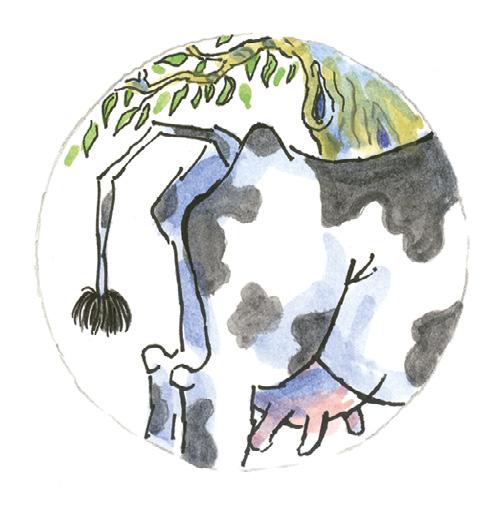
experimental string quartet to create a six-hour composition, which he then manipulated electronically to create a vast 24-hour soundscape. Cellist Oliver Miller designed the quadraphonic sound system while Murcutt crafted the intimate 5x5x5 metre space to draw the gaze upward as the sound emanates into the landscape.
Today, visitors discover the intimate solar-powered Cobar Sound Chapel as a corrugated concrete cube within the water tank’s roofless cylinder. At its four corners, light streams through slivers of cobalt blue glass painted by local Aboriginal artist Sharron Ohlsen. Inside is a concrete bench placed on a floor of rounded river pebbles: both beautiful and pragmatic as they discourage brown snakes. A gold-rimmed cone set inside the ceiling offers an eye to the universe as you listen to music that contemplates the cosmos.
Sometimes it takes an outsider with a unique vision to help us pay homage to the vastness of the Australian landscape and sky. l

NSW Farmers has recently collaborated with the NSW Department of Primary Industries (DPI) to deliver the Agricultural Renewable Energy Acceleration project (AREA). To find out more about how dairy producers can save on rising energy costs, visit the NSW Farmers website or scan the below QR code.
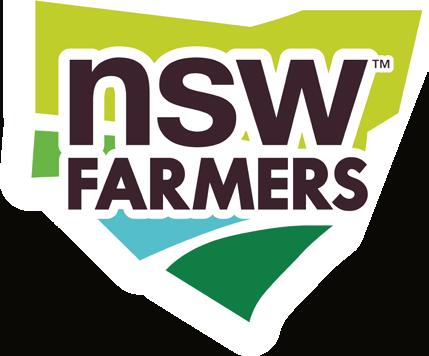

The AREA project has been conducted as part of the NSW Primary Industries Climate Change Research Strategy funded by the NSW Climate Change Fund.

Scan to read the AREA project
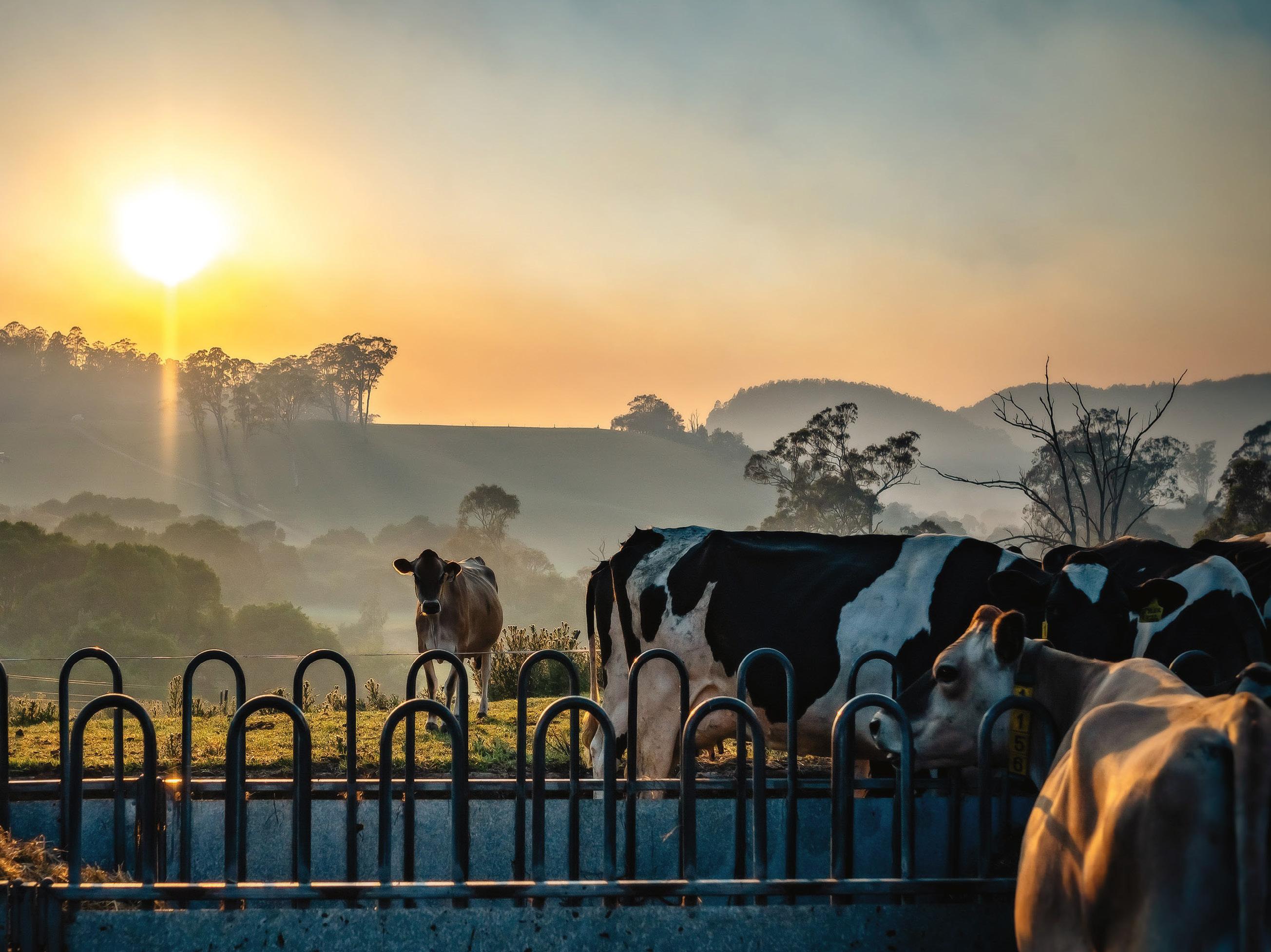
Loam has developed new carbon seed inoculums that make it easier to build soil carbon in cropping systems.


Building significantly higher soil carbon per hectare, Loam's carbon seed inoculums make carbon projects more profitable for growers. Small plot trials, Canowindra NSW
loambio.com Loam Bio Pty